





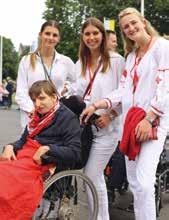




























I hope this bumper edition of our school magazine gives you a glimpse of the endlessly interesting, enriching, and vibrant life in our beautiful valley. There is always so much going on, but the serenity of our surroundings, coupled with the calm, thoughtful and purposeful nature of our Benedictine mission and ethos, provides an inspiration and peacefulness which sets the tone for life here at Ampleforth. This is the perfect atmosphere for our students to develop a love of learning, an inner confidence that enables them to stretch themselves and develop, a deep-rooted respect for each other and the whole community, and a desire to do good in the world. This is the holistic education that we strive to achieve.
I have loved every moment of what has been a spectacularly successful year for Ampleforth: I thank from the bottom of my heart every student, family, colleague and member of our inspirational monastic community for their muchappreciated contribution to the collective achievement.
By Peter Roberts Head of Ampleforth College

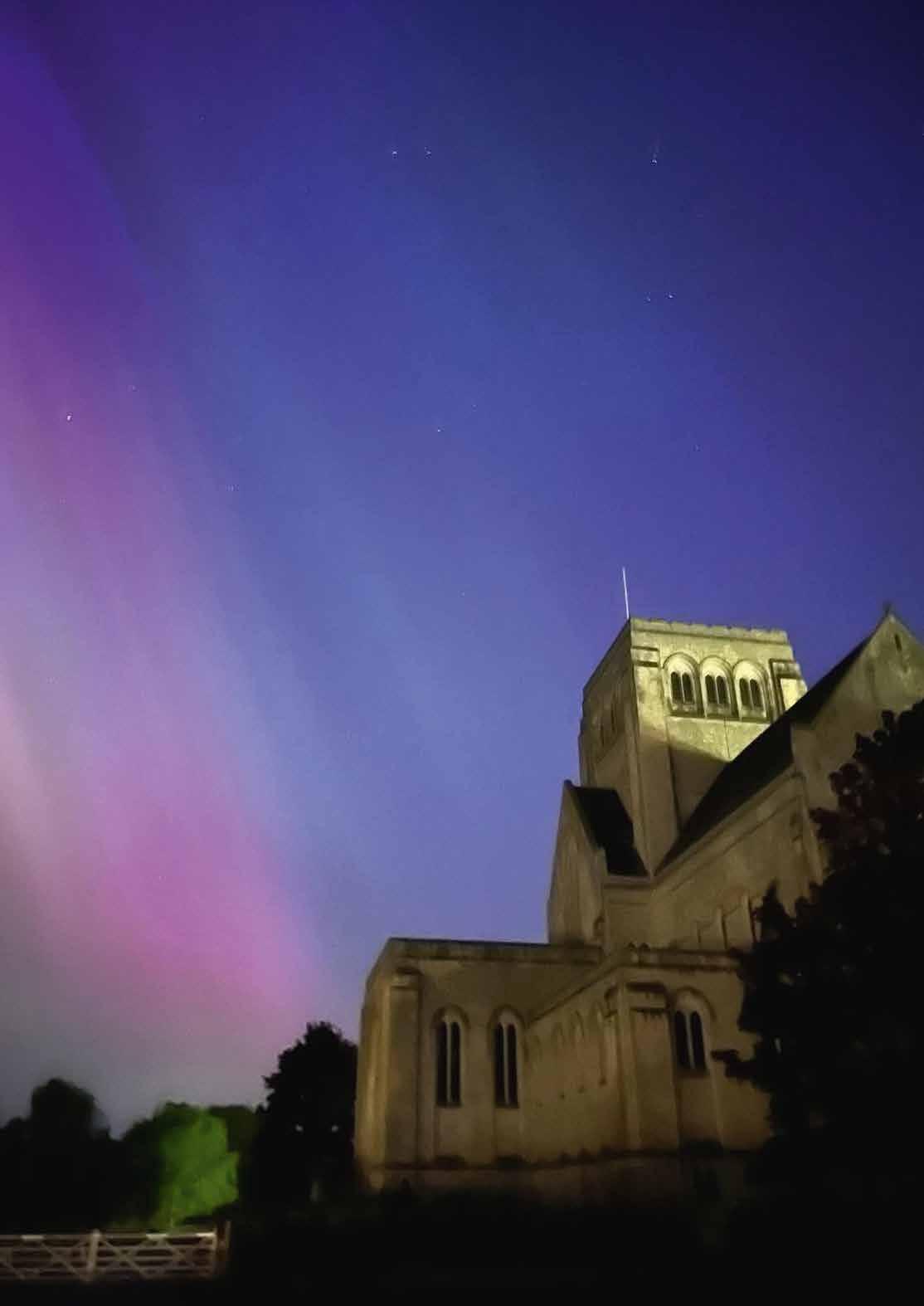
By Ceri Dent, Housemistress
It has been a wonderful year in St Aidan’s, with the girls doing us proud as ever. As I always say to parents, it is the girls who create the atmosphere and culture of the House and they are the best advertisement for the type of flourishing we aim to support. It is always with joy and amazement that we look back at all that takes place around the school day when living in a community such as ours.
The now famous St Aidan’s House spirit has prevailed this year, be it through the coordinated theme for the raft race, joyous participation in the House Singing competition, or simply through the championing of each other in daily achievements and contributions. The sense of service has been strong, and we continue to be in awe of the commitment our girls make to such a wide range of activities and causes.
Exhibition each year provides the opportunity to celebrate the broad participation and achievements of our girls, and this was a bumper year, with no fewer than 48 prizes awarded to St Aidan’s girls for their contributions in academic subjects, sport, music, CCF and theatre. We were particularly proud to have recipients of both the Elwes Prize and McAndrew Shield in the House, awarded to students in Year 13 and Year 11 respectively for their positive influence and embodiment of Ampleforth’s core values.
The theme of our House Retreat in the Autumn Term was ‘a life lived well’. The time we spent together on this day brought about a richness of
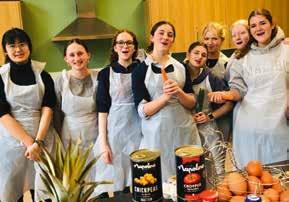
ideas from the girls about how we make this life of ours together really count and what we truly value in our daily interactions, big or small. The sense of love for their House community was strong and the ideas they generated will continue to provide a focus for ongoing projects in the House over the coming year also.
Thanks must be given to our outgoing Year 13, who have given so much to the House through their time here and have been outstanding role models for the younger years. They have undergone their own journeys of personal growth this year and leave us with great admiration for who they have become and the gifts they take with them to their next stage. They leave their legacy in the friendships they will keep and the part they have played in shaping the House ethos. We look forward to hearing of their adventures and to welcoming them back to visit in the future.
The end of one year brings with it the natural looking ahead to the next. We are blessed to have an incredible group of girls moving into Year 13, including seven Whole School Monitors. The House monitor team next year will be led by Lily Sadler, Calypso Robson and Agnes Richardson. They are already planning their contributions and the House team are excited to be working alongside them to bring about further development of the House community ethos. With Dora Potts in place as Head of School, and Isla Tennant as School Chaplaincy Monitor, we’re in very capable hands. We look forward specifically to developing a wider culture of servant leadership in the House, with the involvement of girls across year groups contributing to House goals.

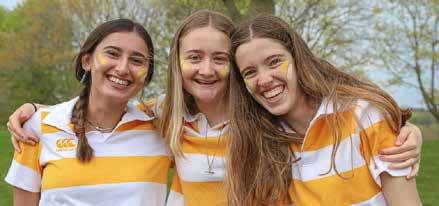

ST BEDE’S
By Charmaine Smith, Housemistress
Melisa Anyim, Year 13, was the first student at Ampleforth College to ever attain a Gold Medal in the Cambridge University National Chemistry competition.
Our very own Anastasia Tolstoy, Year 12, Chess Champion in Sweden, has been coaching St Bede’s girls to help improve their Chess prowess and logical thinking.
Ophelia Bell, Year 12, won the Junior High Gun trophy and Best Junior Shot at the National Clay Championships (the first girl selected to represent the College in a National Shooting Competition). She also became Head of Beagling and Deputy of the School Shoot.
Margaret Lawford-Davis, Year 12, was appointed Head of Green Room, lead actor in Little Shop of Horrors, Stage Manager in The Wizard of Oz, and a soloist in Schola.
Lucy Barrett, Year 13, carried the College to victory in cricket, hockey, tennis, netball and, for the House, secured wins in the Tug of War, Swimming, Basketball, Golf, Badminton, and the Ampleforth Mile (Best Intermediate: Beatrix de La Bretèche, Year 9). Meanwhile, Lucy has studied for her four A levels and continued to play the flute with the National Youth Orchestra.
Emmanuelle Vidal, Year 13, was candle bearer in the Abbey and a St Edward’s & St Wilfrid’s Monitor and has worked conscientiously for her five A levels.

Senior Warrant Officer, Amber Rego, Year 12, was appointed top cadet in the CCF and winner of the top RAF Cadet award, and was also named Kenyan National Ballet champion. She takes over as Head of House in St Bede’s and Head of the College Swimming Team.
Amelie Winter, Year 12, England Pathway for Hockey, takes over as College Monitor for Sport.
Early in the year we journeyed to Durham Cathedral for the House Retreat and visited the tomb of St Bede.
The delayed fiftieth-year celebration of the Schola Cantorum was celebrated with singing from our girls, notably Clemmie Tighe Year 13, Stephanie Okojie, Margaret Lawford-Davies and Emma Barrett.
Our House Punch was a spectacle of light and sound in a candle-lit Upper Refectory with the dulcet tones of Humphrey Kibblewhite (H) on the Saxophone accompanied melodiously on the Piano by the dapper Mr Roger Muttitt. In the twinkling light we were regaled by lively speeches from the Headmaster and the charming Izzy Camacho, Year 13, our Head of House.
May was launched by a prayerful Confirmation Service at which Bishop Terence Drainey spoke to each of our confirmands individually. Lizzie Martin, Martha Mackie, Rachelle Beguin, Victoria Collis, Anamika Desai and Mathilde de Wattville were joined by friends and family for this significant milestone.
Before we all became consumed with revision and exam fever, we delighted in the words of Abbot Robert at the Exhibition Mass on the feast day of St Bede. The next day, the Prize Giving ceremony, richly rewarded
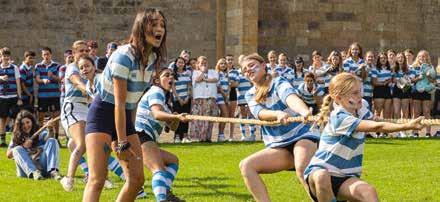
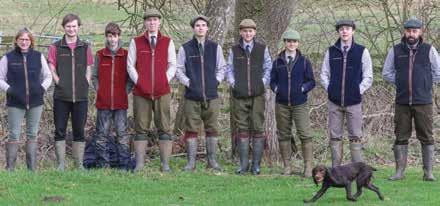
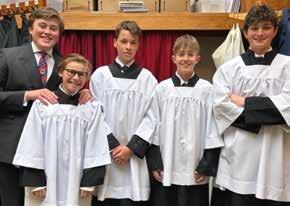
the girls not only with trophies but also with the lyrical feast of an exceptional Motet by Kerry Andrew, which had been commissioned by the College, in honour of St Bede.
Izzy Rogerson (B21) created a beautiful ink drawing of St Bede’s from Aumit Hill which is to be hung in our entrance this year as a testament to the lasting contribution of our Old Girls.
What a memorable year it has been for the girls in St Bede’s House who have cherished the support from our Old Girls, our tutors and our parents!
By Simon Rudsdale, Housemaster
What a year! The first as St Cuthbert’s & St Thomas’ House, saw a year of celebration, of building relationships and of growth personally and as a group. The House showed resilience, hospitality and kindness in bucketloads throughout the year. This was the year of “Two become One”, with a shared vision, ethos and a responsibility to build something for the future whilst always remembering the amazing history of the Houses. We are proud of what the House has become and how it has grown.
Highlights include House Punch, always special but made even more so this year as it was the inaugural one. The boys (and staff) had a wonderful time, speeches were thoughtful and kind, the food was excellent, and the company was the best part of the evening. It was lovely that Fr Richard and Fr Alexander were able to join us and see how the communities had knitted together. Guests were left
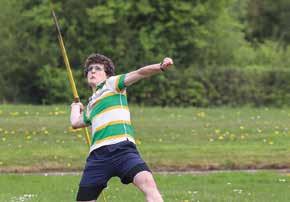
impressed, and many thanked the boys for their outstanding hospitality.
A whole-House paintballing trip in the first term was another highlight. The boys bonded over firing paint pellets at their Housemaster! It was a great day out and friendships were forged and grew as a result. The tradition of excellent Socials has not been lost and we have hosted everything from water fights to casino nights and everything in between. The constant in this is the hospitality and kindness of the boys as hosts, and the gratitude they have for events where they attend as guests at other Houses never waives. Not surprisingly, food plays a big part in our shared life too, and pizza nights, deli nights, takeaways and many BBQs throughout the year have also helped to bring the House together.
Exhibition was a wonderful weekend, starting with a huge haul of trophies and awards. It was amazing to see the achievements of the boys across all areas of school life. CCF, Theatre, Swimming, Basketball (to name a few) and academic awards a plenty showed what an excellent group of boys we have in House. The garden party on Friday night offered a wonderful opportunity to spend time with Sixth Form parents and celebrate the year. On Saturday, there was a constant stream of visitors to our St Cuthbert’s & St Thomas’ gazebo, and the support and care shown by our parents is a much -valued aspect of House life and the sense of family and community we feel.
We end the year looking forward to the continued development and growth of the House in September.
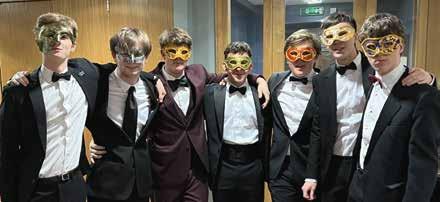


ST DUNSTAN’S & ST OSWALD’S
By Stefan Steinebach, Housemaster
This year we consolidated the many changes we introduced the previous year into St Dunstan’s & St Oswald’s, e.g. the House Council, and the Deanery system to name a few.
The boys have continued to be successful, not only winning most Inter-House Sports competitions, but also the Inter House Bake-off which was a particular triumph given we had come last in the previous two years.
In DO’s we like to have a good party and to spend quality time together as a community. In addition to our Deli Nights every Sunday evening, we also celebrated German Oktoberfest, St Martin’s, DO’s Advent Party, Christmas Party, a joint party with St Margaret’s on the eve of the House Retreats, House Punch, Exhibition Friday Party, and many more.
Our student enterprise, the House tuck shop, has been providing us with additional funds to improve our facilities, e.g. the repair of our new church organ, new toasters, new work tops for the breakfast corner, new pots and pans for the three student kitchens, photo displays of the boys, a table football table, a Scalextric, an electric guitar, three amplifiers, and a microphone for the new rock room. We have also supplemented our new breakfast menu which the House council voted on and which was introduced after Christmas.
We have also been selling our own House merchandise, such as House cufflinks and House umbrellas which has been fun and has further boosted our House budget.
We are grateful to one of our parents who donated two ice baths and of course to the Year 13 parents who so kindly gave us a new dual-purpose BBQ as a leaving present for the House. Both have come into great use already!
Matron Minnie gave birth to Humphrey before the Easter holidays, and we are grateful to Lisa Cowling who has been looking after us during Minnie’s maternity leave.
Our student voice is as strong as ever, and I am grateful to Charlie Hill and Ben Bridgeman for leading our House so successfully this year.
Next year, DO’s will have 5 school monitors: Finbar Flannery - Head Boy
Alois Lensing-Wolff - Head of House
Emil Lovegrove - Deputy Head of House
Ben Ainsworth - Chaplaincy Monitor
Rafe Langdale - EW Monitor
All in all, it has been an incredibly busy but highly enjoyable year, and we are very proud of the role we were able to play – together with the other Houses - in bringing the school forward and planning for a prosperous and successful future of Ampleforth College.
By Dan MacDonald, Housemaster
St Hugh’s House has had a very fine year. Patrick Adams (St Hugh’s Head Monitor) and William Shipsey (Deputy Head Monitor) set a high standard for inclusivity and hospitality, shaping a House that is all about the positive formation of its boys. They


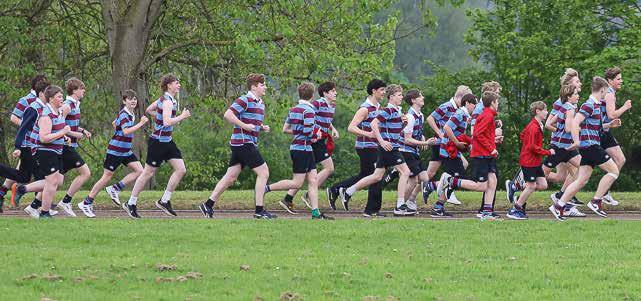
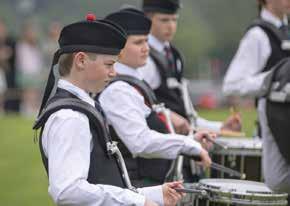
were ably led by a hard-working and fully-involved top year, which included Finn McCarthy (Deputy Head Monitor of the College) and Elijah Hennigan (St Edward’s and St Wilfrid’s Monitor and CCF SUO). We say farewell with pride to Felix James, Fionn Boxshall, Archie Lyness, Anton Loose and Oleksii Sukhotskyi and wish them all the very best for the future. The modelling they have provided for the community has been excellent, whether it be conduct in and around the House, serving the House as reliable Deans, helping develop fine characteristics in our boys, or setting a caring and compassionate fraternal tone in the place.
Ten new students joined St Hugh’s at the beginning of the year: eight in Year 9 (four from EWs), one in Year 10 and three into Year 12. We were also joined by Ralph, the first-born son of our beloved matron Dawn Butler. All the new additions have brought so much joy to what is a tight-knit and supportive boarding community, and we are all much stronger for their inclusion. Humphrey Kibblewhite (Deputy Head Monitor of the College for 2024/25) and Charlie Rooke (House Deputy Head Monitor), both new into the House in Year 12, are College Monitors and ought to be congratulated for that wonderful achievement. They join Ralph Schofield (House Head Monitor) in that role. With such wonderful role models the younger students have plenty of seniors to look up to and interact with. They were so proud of the Swim Team this year for winning the Senior Boys competition and were buoyant after the Senior Boys claimed victory in the Squash. We have also loved seeing and hearing our students participating fully in the Arts: Wilfrid Blake-James (Year 11), Edward Harvey (Year 9), Sebastian Muscat (Year 9), and Freddie Challans (Year 9), busy in the theatre
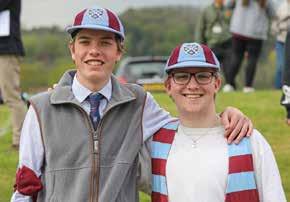
productions this year; Humphrey Kibblewhite (Year 12), Wilfrid Blake-James (Year 11), James Deacy (Year 11), Will Shipsey (Year 13) and Finn McCarthy (Year 13) have been integral and valued members of the Schola Cantorum; Arturo Angelini (Year 12) and Cullen Lyness (Year 9) soloists in the House Music competition; while Ned Simons (Year 10), Ivan Pugachev (Year 9), Francis Freeland (Year 10), Grainger Muir (Year 10), Aliosha Pugachev (Year 10), Harry Fletcher (Year 11), and Freddie Fawcett (Year 10) piping or drumming with the Ampleforth Highlanders.
Long may St Hugh’s House thrive! We all look forward to our next year in the valley and especially welcoming more families and their boys into our home.
ST JOHN’S
By Chris Starkey, Housemaster
In St John’s, our ‘family home’ culture has remained palpable.
Student leadership has been a particular strength this academic year, ably headed-up by George Birkett (Head of House), Sebastian Fernandez-Jurgens (Deputy Head of House), and Seamus Stainton (Head of School). A new initiative to invite these student leaders to attend some staff team meetings helped to strengthen the sense of purpose and collaboration in the House.
Building on work we had already done to develop the academic life of St John’s, the whole school reading initiative was well-received by the Year 9 and Year 10 boys who read for 30 minutes at the start of every


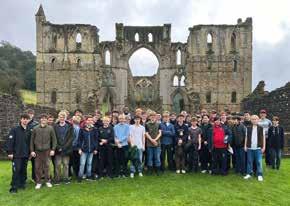
supervised prep session. The tutor team was bolstered by the addition of Mr Metcalfe, Mr Townend and Dr Dunn, who supported the boys wonderfully alongside the existing team of Dr Weston, Mr Emsley and Lt Col Blackford.
Our House Retreat was on the theme of ‘spiritual friendship’ and saw us walk to Rievaulx Abbey in attritional conditions. The boys were unfailingly positive throughout and it was a memorable community occasion. I am grateful to Johnny (Year 13), House Catechist, for preparing Thomas CreweRead (Year 11), William Hickman (Year 11), Billy Morgan (Year 10), and Joshie Gibson (Year 10), for Roman Catholic Confirmation. Fergus Younger (Year 10) has been confirmed Anglican. The spiritual life of St John’s is in good shape.
St John’s has participated extensively in wider College life, the boys being excellent ‘joiner-inners’. James Thompson (Year 11) made it onto the school small bore shooting team, and George Mattock (Year 13) won multiple prizes for his clay-pigeon shooting. Archie Jameson (Year 11) was an impressive lead in the school production of Little Shop of Horrors We welcomed Ronald Ye (Year 9), a music scholar, and also had the Pipe Major in our ranks this year - William Harrison-Topham (Year 13) - who performed majestically from the clock-tower on Exhibition Saturday. St John’s was well-represented in the Model United Nations team, led by our very own Niwa Limbu (Year 13). William Tait (Year 11) was a pioneering member of the national award-winning school Rocket Club.
There was a tremendous Rugby tour to Belfast, which seven of our boys (plus the Housemaster!)

enjoyed. We had excellent representation across the 1st XV and 2nd XV, with Seamus Stainton (Year 13), George Mattock (Year 13), and Joshua Oke (Year 12) being awarded their first team caps. George Philippi (Year 1 was Captain of Hockey and was joined by Edward Marsh (Year 13) and Harry Feeley (Year 12) in the 1st XI. Henry Lewis (Year 13) meanwhile captained the 1st XI at Football, and George Birkett (Year 13) the 2nd XI. Edward Marsh (Year 13) was Captain of Tennis in the summer term, whilst four St John’s boys were in the 1st XI for Cricket. Joshua Oke (Year 12) has excelled on an individual level at Rugby, receiving an invitation to the England U17 Development Camp. Meanwhile, Billy Morgan (Year 10) was selected for the Scotland U15 Cricket squad. An exciting year for sport in St John’s!
Followers of the St John’s Instagram will be aware that we responded to student feedback and conducted a ‘Breakfast Revolution’. Embracing the fact that breakfast is served in the House, the boys were re-organised into teams to help prepare a new menu of tasty, varied, protein-rich breakfasts for their peers. Forty-five boys eating breakfast together is a lively business, and these changes ensured an upbeat and healthy start to every day.
I am grateful to all the boys, parents and staff of St John’s - but particularly to the Year 13 leavers - the first group I have House-mastered from Year 9 to Year 13. I will miss them dearly but am proud of the people they have become. Kind, open, and values-driven young men; they will go far.


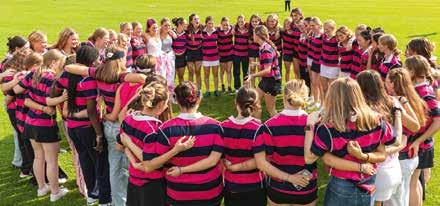
By Rebecca Paterson, Housemistress
St Margaret’s House has had a wonderful year, full of happiness and achievement. This year saw many successes with lots of our girls interviewing successfully to be part of the Lourdes trip, many taking part in the Big Walk for the Friendship Project, winning essay competitions, taking part in Schola concerts and masses, CCF expeditions, College plays, equestrian competitions, and completing Duke of Edinburgh awards. Aside from this, we have all the House competitions we won including: Hockey, tennis, swimming, netball, athletics, cross country, music and best GCSE results in the College. At Exhibition it was clear St Margaret’s girls have a vast array of interests and expertise in lots of different subjects and extracurricular activities.
The spiritual life of the House continues with weekly Deaneries, Lectio and House Mass. We had a wonderful House retreat to York following in the footsteps of St Margaret and visiting all the places she would have been and known. Many of our girls have been confirmed, both Catholic and Anglican, and some welcomed into the Church. Fr Oswald has his feet firmly under the table and has taken great care to provide the girls with bespoke prayers and liturgy. We feel very lucky to have him.
As part of our efforts in chaplaincy and charity we raised £2,500 for CAFOD specifically giving money to women’s causes such as shelters and mother and baby projects. Again, another show of solidarity from St Margaret’s community.
Yet another year leads us to saying goodbye to members of our community, our wonderful Year

13. An amazing year group, we wish them well in their next steps for some of them this may be total world domination. We only ask that they remember their Benedictine education! I would like to take this opportunity to say thank you, particularly to those girls in leadership in our House - Head of House, Lara Evans, the Deputy Heads of House, Daisy Wilson and Florence Sturdy, Evie Tempest, our Chaplaincy Monitor, and Amadea Pharaony, our St Edward’s and St Wilfrid’s Monitor. Josie Blake-James has had an outstanding year as Head School Monitor. Next year, Annie Mitchell will be our Head of House along with Daisy May and Fiamma Beveridge as Deputy Heads of House. We are also lucky to have Mary Paston Bedingfeld as Chaplaincy Monitor along with Henrietta May and Eirini Psaronikolaki as St Edward’s and St Wilfrid’s monitors. I have no doubt that these girls will lead the way for St Margaret’s setting shining examples of what it is to be a leader.
In his Apostolic Exhortation, Christus Vivit Pope Francis tells young people: “make the most of these years of your youth. Don’t observe life from a balcony. Don’t confuse happiness with an armchair, or live your life behind a screen. Whatever you do, do not become the sorry sight of an abandoned vehicle! Don’t be parked cars, but dream freely and make good decisions. Take risks, even if it means making mistakes. Don’t go through life anaesthetised. Live! Give yourselves over to the best of life! Open the door of the cage, go out and fly! Please, don’t take early retirement”
I can tell you St Margaret’s girls are certainly listening to this! We have adventurous, empathetic, participating girls, they are a joy.

ST EDWARD’S & ST WILFRID’S
By Sebastian Phillips (C00), Housemaster

What a year for Junior House! Encapsulating the Renaissance approach, there have been numerous opportunities for our pupils to throw themselves into the arts, academia, sports, and the rural upbringing here in the valley. We have been so impressed with how the Year 7s have started their Ampleforth journey and we send our Year 8s on to their new Houses, knowing that they are well prepared for the rigours of being in the senior school.
The pupils have greatly enjoyed participating in some of the many whole school House events, such as the Retreat, Tug of War, Raft race, and Singing


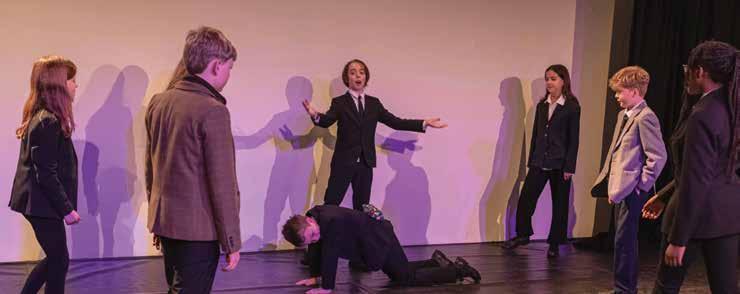

Competition. Our own annual House celebration, the St Edward’s & St Wilfrid’s House Punch, was a delightful affair with excellent speeches made by each of the prefects. All of our Year 8s have left an indelible mark on Junior House during their formative time here - including quite literally on our House mural!
Musically, our pupils have taken to the stage with growing enthusiasm. With over half the House being instrumental musicians, they have performed throughout the year with great aplomb as well as joining such illustrious groups as the Schola, Orchestra and Pipe Band. The performances at Prizegiving were outstanding, whether they were by those working towards Grade 8 on the piano or students making their first appearance in the House Band. This showpiece culmination to the academic year also included fantastic performances by those studying for LAMDA exams. The standard of performing arts was impressive and was also on display in the Year 7s’ Play in a Day production in the theatre the day before.
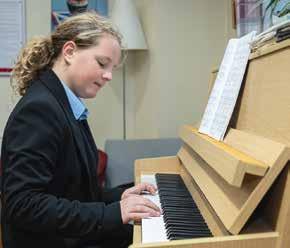
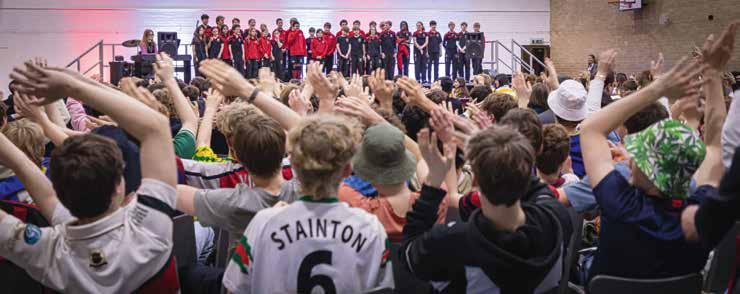


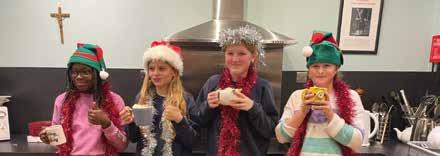
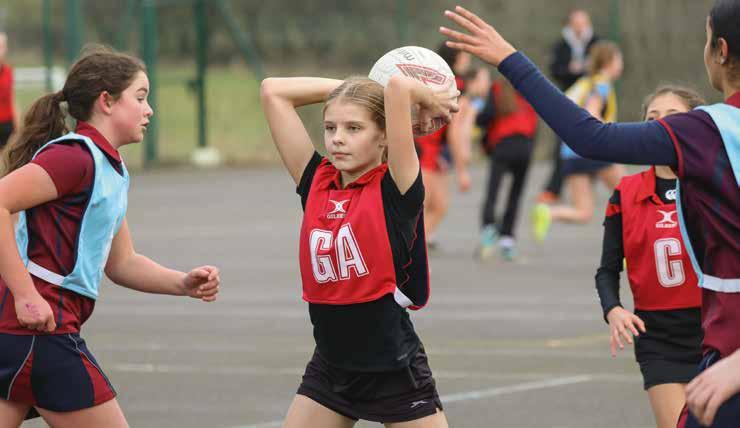


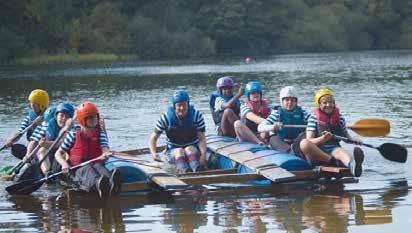
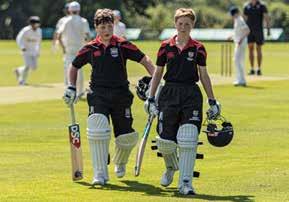



On the playing fields, both the girls and boys have shone in a variety of sports. Highlights by the boys were a memorable victory in the Ampleforth Rugby Sevens, impressive season results by both the A and B squads in hockey and, in cricket, winning against some of our distinguished local rivals. The girls outshone the boys’ excellent efforts and they had incredibly successful hockey and netball seasons. The equestrian eventers also had much success, culminating in reaching the NSEA National Championships. The Summer Term finished with the boys and girls cricket squads recording excellent victories at the Worsley Cup, where we welcomed fourteen u13 teams to Ampleforth. The boys reached the semi-finals whilst the girls went two better, winning the final in emphatic fashion. The climax was our House Athletics with the great fun Deaneries and Parents’ Relay bringing the sporting year to a close. Unlucky this year, parents!


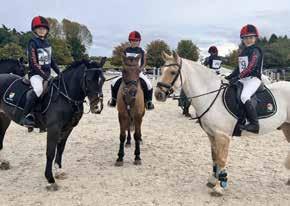
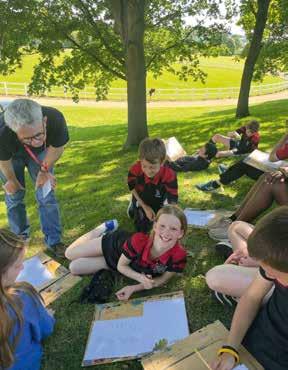


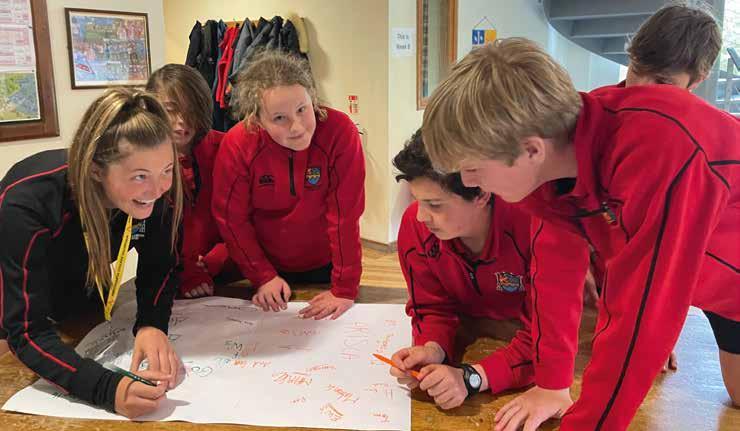

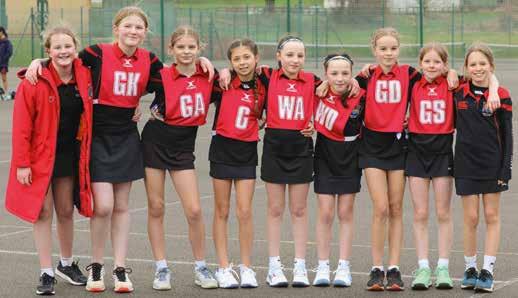
We have made the most of the many pastoral opportunities this beautiful part of the country offers both in our own valley and with numerous trips out to York, the Howardian Hills, the Moors, Scarborough, Rievaulx, Helmsley, Sutton Bank, and surfing at Saltburn to name a few.
Ampleforth is a very welcoming place and our Junior House family exemplifies this. As our community has grown throughout the year, with the arrival of more pupils and additional House staff, the sense of integration and being at home, has only become deeper. This, combined with the experience and energy of the staff team, has led to the pupils really flourishing throughout the year. It is what Junior House is all about. We aim to provide the best foundation possible for each pupil and to prepare them fully for their next stage in life. This is particularly rewarding for Junior House staff as we are part of their next steps as Amplefordians.
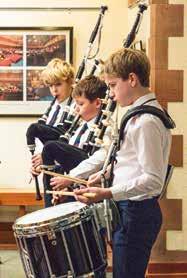




Hotly contested inter-House competitions this year included: Swimming, Athletics, Badminton, Singing , Netball, Cross Country, Raft Race, Tug of War, Hockey, Tennis, Bake off, Shooting, General Knowlege Quiz


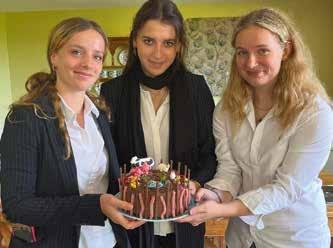







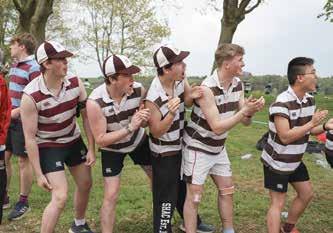

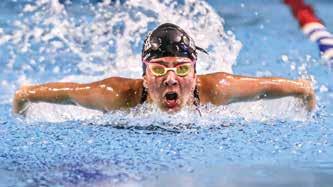

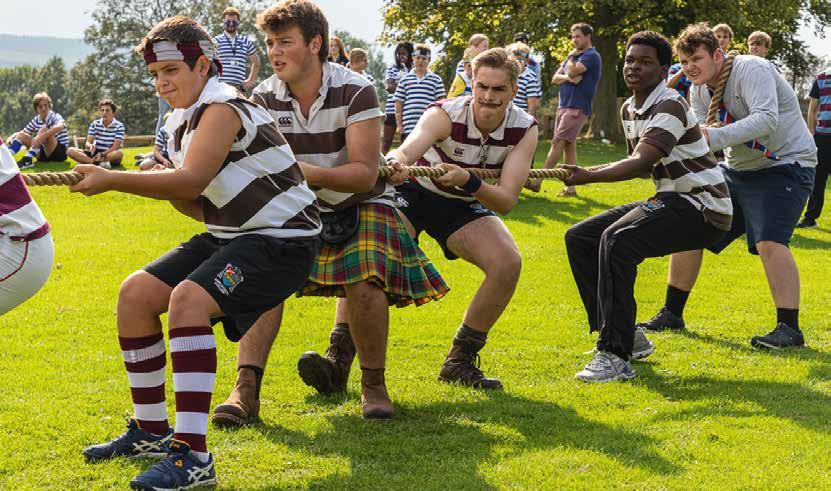
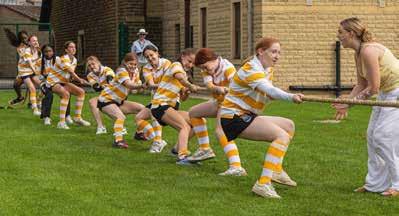

On the first glorious Sunday of the school term, we set out for the annual fight for the coveted ‘Tug of War’ title. The day always brings out the greatest sense of House patriotism within all the students and gives new students a very clear sense of House pride. It must be noted that all the participants were polite, kind and thoughtful towards all the other Houses, which made the day all the better, and also showed new students the importance of showing sportsmanship in the House events. This year was particularly impressive in terms of participation and encouragement throughout the day.
After a gruelling, challenging and perhaps even emotional afternoon, St Bede’s House and St Dunstan’s & St Oswald’s came out victorious. Many congratulations to them; it takes teamwork and perseverance, especially under the sun of the September heatwave and both Houses displayed this excellently. A mention must go to the Junior House teams who showed the whole College their impressive determination and competitiveness.
As always, a big thank you to all the staff who gave up their Sunday to help run and organise an event which brings great joy to all the students - especially Mr MacDonald who had the arduous task of being referee: hopefully the screaming hasn’t had a long-term effect on his hearing! The Tug of War is such an important event in the school’s activity calendar, as it always helps with the induction of the new students and allows them to get involved in House life and experience the community aspect of the school. This year every House showed true inclusion and there was a real sense of support for one another all through the afternoon.
By
Lara Evans (M), Year 13



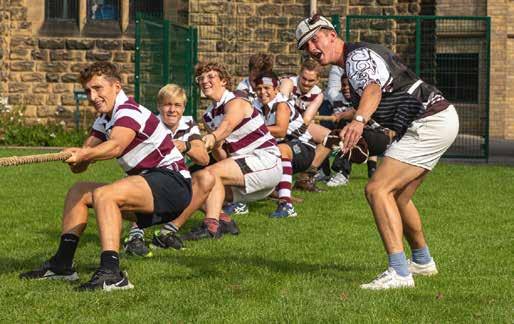
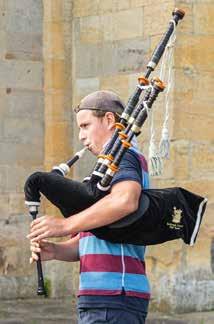

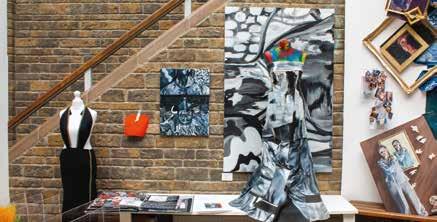










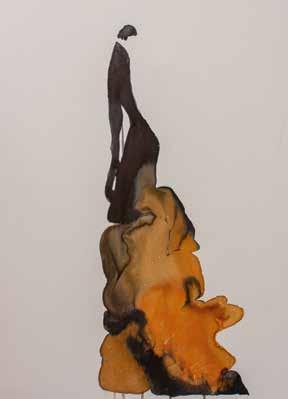


By Sarah Greenwood, Head of Art
In this, my inaugural year as Head of Art, Ampleforth Artists have experienced a rich tapestry of events and creative opportunities to both challenge and inspire their evolving practice. Lectures and practical workshops from visiting artists Rebecca Appleby and Rory Menage opened lines of visual enquiry for our Year 12 and the Art Scholars. Rebecca is a highly respected artist, who trained at Edinburgh College of Art, a selected member of the Craft Potters Association of Great Britain and a member of the Royal Society of Sculptors. Currently living and working in Yorkshire, she shared her sculptural vocabulary with students, drawing formal inspiration from organic abstractionists such as Gordon Baldwin and Gillian Lowndes.
Yorkshire sculptor Rory Menage provided an equally fascinating learning experience, exploring novel methods of portraying naturalism.
We have been fortunate to have visiting artists; however, we have also ventured beyond the valley to experience diverse practice. In September, Year 13 Art students visited Liverpool Biennial 2023, where both unusual and established exhibition venues across the city responded to the theme uMoya We walked far and experienced much that would later influence students’ coursework portfolios. To assist with the release of their exam question paper, in February, Year 13 visited London to visit Tate Modern for Philip Guston’s major retrospective.
In September, Year 11 attended Bloom at York Art Gallery (YAG). The exhibition comprised of floralthemed works, included paintings by leading artists


such as Henri Fantin-Latour, Charles Ginner and Jan van Os, who are renowned for their interest in flowers, nature and landscapes. Year 11 also benefited from the permanent collections at YAG.
Year 10 visited ‘Trap of the Truth’ at the Yorkshire Sculpture Park during October. This is an exhibition by renowned Austrian artist Erwin Wurm, featuring more than 100 works displayed indoors and, in the landscape, spanning over 30 years of his career.
Finally, in June, Year 12 visited the 10th edition of Glasgow International. Glasgow International is Scotland’s biennial festival of contemporary art where an array of artists’ projects was presented across the city, spotlighting Glasgow’s prominence as a centre for artistic production.
Having experienced a gambit of Fine Art and Curatorial practice, we produced two of our own Art shows. The first in February, entitled, “An Exhibition for Her”, stemming out of a fantastic idea from the Year 11 CAFOD Young Leaders in St John’s in support of women’s rights in Afghanistan. Our Exhibition featured work “By women, for women” drawn from our Year 10, 11, 12 and 13 female art students. This showcased our talented visual artists, with Evie Tempest (Y13M) participating as both an exhibitor, and providing the musical accompaniment.
Our final Exhibition of the year was held at Exhibition for all year-groups; however, special mention is reserved for the endeavours of our GCSE and A level candidates who really put on ‘A Show’ marking the conclusion of their courses. A huge well done to all.



By Michael Emsley, Head of Vocational Studies
The BTEC department has had a very busy year. BTECs have risen in popularity at Ampleforth with over thirty Year 12 students studying one or more of Countryside Management, Enterprise & Entrepreneurship, and Hospitality
Countryside Management students have stalwartly dealt with what has been the wettest of winters, with the weather failing to deter their outside learning.
Enterprise & Entrepreneurship students have completed their first unit of coursework, culminating in developing business ideas of their own and assessing the viability of those ideas. They then completed a unit of Personal and Business Finance where they gained valuable insights into savings, investments and the factors that impact on insurance!
In an example of Ampleforth’s personally tailored education, this year sees the conclusion of by Kit Bingham (13CT) of a one-off BTEC in Creative Media, ably supported by Ms Naylor the Head of Drama.
In Hospitality, Year 13 students finished their course with the Asian Food unit, with the students showing ever more professional kitchen skills and dishes including bao buns, tanghulu sticks, and a range of impressive looking, and more importantly impressive tasting sushi. There were some impressive final presentations of their Environment and Sustainability research projects with a diverse range of international businesses covered. This has been a bittersweet year for Hospitality as this year’s Year 12s are the final cohort to begin the qualification as it will cease to be offered nationally. At Ampleforth, next September will see an exciting new alternative - Level Three BTEC Travel and Tourism – as well as the introduction of BTEC Sport, which will combine with Countryside Management and Enterprise to offer a great selection of vocational opportunities to sixth form students.
By Jeremy Mitson, Head of Economics and Business
It’s been a year full of opportunities for our students in the Business and Economics department. November saw an early start for our students as the buses departed
at 7.00am to visit the JCB World Headquarters. The students had a great day and learnt about the production process and the wide range of opportunities available at a large multi-national corporation.
We have grown our library again this year and the students have re-started the Economics society, where they discuss current global issues and figure out how they would tackle these problems. We have also introduced for 2024-25 two new activities, one in partnership with JCB is an enterprise challenge aimed at Year 12 students and they have to work in teams to solve a local problem, by inventing a new machine. The other opportunity is for our students to develop their entrepreneurial skills. We have selected a panel of OAs and our students have the opportunity to pitch their ideas to a panel of investors who then use their own funds and time to coach and mentor these students to start their own business – it is a similar idea to BBC’s Dragon’s Den!
This year, we have had some excellent entries from our students for the Young Economist of the Year Competition, by far the most popular essay this year detailed the introduction of a government tax on unhealthy foods. Equally, it was great to record our first team-podcast, which was a lively debate on taxing unhealthy foods.
CCF
By Lt Col Miles Blackford, CCF Contingent Commander
The highlight of the last twelve months must be the CCF summer camp in the summer of 2023 (after the last year’s Diary was published). The 16-day summer camp and expedition were a joint effort between the cadets and staff from Ampleforth College, and Stamford Welland Academy (SWA). Twentyone brave cadets ventured into the Borneo jungles accompanied by five members of staff from the two schools. They were not on their own though; Gurkha soldiers from the Brunei based Infantry battalion hosted our intrepid explorers, maximising the training opportunities and providing everyone with the most realistic and worthwhile learning experience possible.
The trip was a huge success, consolidating friendships and honing survival and soldiering skills. This led to further inter-school training opportunities later


in the school year which the cadets loved. The SWA cadets returned to Ampleforth at the end of the Lent term to participate in the final field training exercise undertaken by our Cadre course cadets and supervised by staff from our affiliated unit at The Soldier Academy in Catterick.
Standard operating procedures filled the academic calendar in between the headline events: the annual dinner night, Field Day, and the Armistice ceremony were all features of the Autumn term. Air experience flights were affected by the weather, though we managed to get the RAF cadets into the air in gliders and Grob Tutor aircraft on more than one occasion. More recently we had UK Mountain Search Dog ‘Gem’ come and conduct training with our Year 9 and 10 cadets who had to hide as though they were participating in an escape exercise!
There is more to come from further field training, paddling events, and summer camp as well as our Annual Inspection and the upcoming Nepal expedition in October. Well done to all who helped make this year as exciting as it was!
By Andrew Hutchinson, Head of Christian Theology
The Christian Theology department has had an excellent year, crowned by our outstanding rating as part of the College’s own outstanding Diocesan Inspection report, which commended the department for the strong understanding of our role in the moral and spiritual formation of our students. We entered a team into the St Andrew’s University Ethics Cup Competition which was hosted by Leeds University. This year we made it to the semifinals. The experience was a valuable one, and we are keen to return next year and go further.
By Charlotte Goddard, Head of Classics
In January a party of Year 13 students of Latin, Greek and Ancient History visited Newcastle University’s Classics Department for a day of lectures on topics relevant to their A level studies. Lectures included the rhetoric of Cicero, heroism in the Odyssey, Roman imperialism and cultural life in Fifth Century
Athens. Students enjoyed the chance to look around the Newcastle university campus besides learning from lectures to enrich their school studies.
The Arcadia Classical society met weekly in the Autumn term. Our Oxbridge candidates in humanities subjects led discussions on literature, philosophy, and history, among which was an excellent presentation by Will Shipsey (13H) on heroines in Sophocles.
This year saw the introduction of Classical Civilisation lessons for students in Years 7, 8 and 9. These included the study of mythology, Classical representations of the Underworld (built in Lego and featured in the picture), the ancient Olympic Games, Roman bathing, and the history of the Latin language. These lessons provide a foundation for a new course we are launching in September: GCSE Classical Civilisation, which is offered in addition to the options of Latin and Greek.
In keeping with our whole school policy to promote reading, we are building a Classics lending library featuring a range of Classical and historical fiction. In May, we welcomed to the College OA Nick van den Berg (A79) who brought a donation of books from his father’s, Louis van den Berg (B55), Classical collection to present to the College library. The collection includes a Latin edition of Winnie the Pooh, and many Latin and Greek texts from the Classical and Middle Ages.
By Eric Knutsen, Head of Computer Science
Our computer scientists have been very busy this year, engaging with C#, Python, Scratch, spreadsheets, and desktop publishing, not to mention the assiduous preparation for public examinations.
Year 11 students had a particularly busy time learning how to programme designs that can be expressed in pseudocode and how to write on paper their programmes. We covered a lot of theory and the group worked extremely hard to ensure that they were prepared.
Year 13 students continued to engage in both theory and programming. Particularly excellent were the projects they developed during the year. These included;
a 2-dimensional game akin to a popular game from the early days of computer consoles; a prep (homework task) organiser; and work for the benefit of the College’s alumni department. The results from the coursework represent some of the best examples seen, with students doing exactly as suggested during the works’ development stage.
Both Year 10 and 12 students have made a good start to their studies. They continue to make the effort to understand a subject new to many of them. We look forward to seeing them in September, having kept the momentum over the summer with the ‘transition work’.
Year 9 students have developed a solid grasp of Python under the stewardship of Mr Butler. As well, we have investigated the impact of AI, especially on programming. The enthusiasm for the topics has led to an increased number of students opting to take the subject at GCSE next year.
Year 7 students have been grappling with spreadsheets, presentation software (using some of the less obvious tools) and the website language of html.
Finally, Year 8 students have been busy this year, expanding their skills in Scratch. They also produced, using industry-standard desktop publishing software, magazines that were published into a single Year 8 magazine, representing the best of their efforts.
Well done to all students for their efforts. The next academic year looks set to continue our upward trend of development!
By Brendan Anglim, Head of Design & Technology
There have been numerous trips and competitions for Design and Technology (D&T) students this year. All girls studying D&T were invited to a tour and workshop at Labman Robotics as part of “Ada

Lovelace Day: Honouring Women in STEM”. Year 11 to 13 D&T students joined forces with our Modern Studies students for a visit and tour of the JCB Backhoe Loader factory and World HQ in Staffordshire. D&T students in Year 12 visited Nissan’s assembly plant in Sunderland, as well the IKEA warehouse, and Northumbria University’s Product Design, Architecture and Engineering Departments. Their north-east field trip included tours of the architectural and civil engineering sights of the Gateshead Riverside, The Glasshouse, The Angel of the North and The Millennium Bridge to inspire their lighting projects.
The D&T Rocket Club, assembled from across the college, has grown to two teams and they placed 1st and 2nd at the regional heats to qualify for the national finals in June, which they duly won – making Ampleforth the 2024 National Schools Rocket champions!! They now progress to represent the UK at the International Rocket Competition at the Farnborough Airshow, competing against the very best of teams from America, France and Japan.
With an eye to the next generation of STEM students, the department hosted Aysgarth Prep School with a “Rockets and Robots” workshop. Part of this experience was a show and tell from the Leeds University Rocket Association of their Gryphon II rocket.
By Christopher Vowles, Head of English
English students have had a successful and creative year in the department, extending their reading of fiction and non-fiction, exploring canonical and noncanonical texts, and learning the craft of writing for a range of different audiences.
Year 7 students have been writing their own rules around Ancient Egyptian myth and culture; producing their own Old English manuscripts,


complete with illuminations; and taking part in the regular ‘Courage Weeks’ to develop independence and problem-solving skills. In Year 8, students have learnt about the origins of drama, and enjoyed performing a section of a chorus from Sophocles’ Antigone. They have been developing their analytical skills, writing about colonialisation in The Tempest, and studying the poetry of Tennyson, WB Yeats, Jane Hirshfield and Carol Ann Duffy.
Year 9 students been learning about how the Romantic revolution changed the way we think and write about the town and the countryside; constructing their own Frankenstein-inspired monsters in descriptive prose; and following Macbeth’s brutal rise to the Scottish throne. In Years 10 and 11, students have been perfecting their skills of descriptive writing and critical reading by examining the poetry of ageing and wisdom, Tennessee Williams’s play A Streetcar Named Desire and the Australian Gothic novel, Picnic at Hanging Rock
Sixth form Literature students have approached tragic drama and the literature of tragedy and crime writing with enthusiasm, debating questions like ‘Is punishment just an acceptable form of revenge?’ and ‘Can ghosts ever be credible witnesses to their own murder?’ Year 12 students recently enjoyed a live narrated-ballet production of Tess of the D’Urbervilles at York’s Theatre Royal and have started work on their independent summer research projects by presenting a mini-lecture to their peers on the poets and novelists they have chosen to study. Year 13 students submitted an impressive variety of critical essays shortly after Christmas, which included a feminist reading of Defoe’s Moll Flanders, an environmental reading of Hughes’s The Hawk in the Rain, and an aesthetic reading of Wilde’s The Picture of Dorian Gray. The Sixth Form Poetry Society has been well attended, and members have considered the poetry of Scotland, poetry of Wales and poems of birth and re-birth. Some members have also generated their own aleatory surrealist poetry, utilising tried and trusted techniques

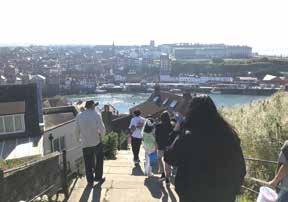
pioneered by the Dadaists and leaving readers bewildered ever since.
Approximately one quarter of the department’s Year 13 students have applied to read degrees in English or closely related fields this year at Russell Group universities and are looking forward to continuing their reading journey.
By Rita Bose, Head of EAL
The English as an Additional Language (EAL) Department has had a very busy and successful year. Congratulations to the nine students from Year 12 and 13 who have taken their IELTS exam, which is an entry requirement for overseas students to UK universities. Everyone passed, with the average score being Band 7, which is high!
In January, a group of 35 students from EAL and their guests celebrated the Chinese New Year with a fabulous Chinese banquet in York. What a wonderful occasion this was, with so much laughter and new friendships formed. It was heartening to see our younger EAL students teach others how to use chopsticks!
During the Culture and Diversity week in March, the EAL students prepared Power Points and presentations describing their own ‘Cultural Journey’. These were displayed in Main Hall throughout the week, as the students represented their native country, with their flag on display alongside items unique to their country, such as Lederhosen from Germany! We had some live cooking this year, with Mathilde preparing a delicious fondue dish, with some homemade Swiss bread. During this week we were also fortunate enough to have a guest teacher from Germany here to shadow the EAL Department, and she taught Miss Bose how to make some German specialities for the cultural evening, where teachers and students alike were all able to sample
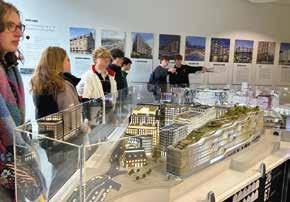

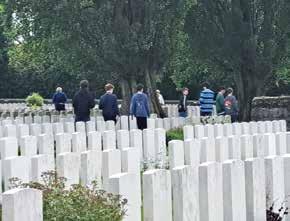

and enjoy the rich diversity of food from a variety of countries, including Poland, France and Scotland.
Our students have also all engaged well in our Cultural Programme this year, with discussions based around the Royal family, the countries and traditions of the UK, the history of York, the Great British Seaside, Brexit and the General Election. The programme culminated in an EAL trip to Whitby during the final week of term.
GEOGRAPHY
By Hannah Graham, Head of Geography
This year the Geography department has been encouraging students to consider our departmental vision of “Awe and Wonder”, “Thinking like a Geographer”, “Enquiry” and “Future proofing our Planet” through our renewed curriculum and introduction of “Reading around the World” in Years 7, 8 and 9. Students have been introduced to new and exciting topics such as Biospheres and Super-powers and books such as “Stitched up” and “Trashland” by Steve Cole.
Alongside the curriculum, our adventurous Geographers have once again been exploring the world. The Year 7 and 8 students of Junior House found themselves walking through the limestone valleys and caves at Ingleborough in early September. Students were struck by the stalagmites and stalactites on the floor and ceilings. Year 12 visited London for the day to look at the regeneration and gentrification of the Kings Cross area including Coal Drops Yard. This ignited an enthusiasm for enquiry that would see them through to the Summer term, where the same students completed their coursework investigations in York and Hornsea.
In a bid to instil an understanding of Geography that goes beyond oxbow lakes and shanty towns, we have actively encouraged our Year 9 students to carefully consider “Their place in the Valley” through the themes of Space and Place. During a dedicated morning in the Summer term, students listened to the stories of Teachers, Monks and OAs to learn about why Ampleforth is a special place to them. This was complemented by using map skills to see how Our Valley has changed over time. Students went away with a renewed perspective on life in the valley and time to reflect on what Ampleforth means to them.
HISTORY
By Paul Connor, Head of History
The History Department has had another very busy and active year. Our focus, as always, has been to teach our courses as vibrantly and effectively as possible, with Year 7 learning about British and World history from Henry VIII to George III; Year 8 learning about British and World history from the American, French and Industrial Revolutions through to the start of the twentieth century and Year 9 learning in depth about the First World War, the Suffragettes, the Russian Revolution and Stalin. Year 10 and 11 have studied Nazi Germany, the Cold War, Inter-War America and the Middle East in the twentieth century and the Sixth Form have studied Stuart and Cromwellian Britain, and nineteenth century French and German history. Particular highlights have been the Headmaster’s masterclasses on “St Bede’s World” to Year 9, the Year 9 trip to the First World War battlefields, Year 13 research essays on the English Civil War and a range of topics on Nazi Germany, and History EPQs on the Kindertransport, Marie Antoinette, the 2nd Polish Corps in WWII, the history of Venice and the Pendle Witch Trials.
The department also ran trips to see the historical films ‘Napoleon’ and ‘One Life’, the latter about the extraordinary life of Nicholas Winton who saved 669 Czech children from the Holocaust. The History Department once again ran its annual national history essay competition for prep schools (and our Year 7-9 students) which this year attracted over 200 entries that covered a huge range of topics. They included the Battle of Actium, the Battle of Lepanto, Victorian Punishments, The Slave Trade, Women in the Russian Revolution, Pearl Harbour, Responsibility for the Atom Bomb, The History of Chess, The Cold War, and many more. The standard was incredibly high. The History Department is very proud to encourage such interest in history both within the school and nationally.
By Richard Warren, Head of Mathematics
It has been a busy and industrious year in the department and as always Ampleforth students have competed and excelled in a variety of national changes. Two teams of Year 10 mathematicians took part in the York Maths Feast in March at York St John University.


They impressively worked their way through four rounds of questions, for the second year running, both teams did extremely well.
In the UK Mathematics Trust (UKMT) Junior Challenge, Year 7 and Year 8 students gained two gold, eight silver, and five bronze awards; a most impressive result. Two of these students qualified for the next round, The Junior “Kangaroo”.
For the UKMT Intermediate Challenge, our students again put in an encouraging performance, obtaining one gold, three silver, and ten bronze awards, with Daniyal Awan (Y10 CT) impressively qualifying for the next round. In the Senior Challenge, we obtained more medals than the year before (three silver and eight bronze), and we just missed out on a couple of elusive gold awards. In the Mathematical Olympiad for Girls, four students were entered (an Ampleforth first) and well done to Agnes Richardson (Y12A), who gained marks in every one of these challenging questions, achieving a merit overall. Given the positive results above, we are particularly looking forward to the post-COVID return of the UKMT Team Challenges which will be running next year.
By Aileen Wallington, Head of French
2024 has been another successful and exciting year in the Modern Foreign Languages Department with a strong set of linguists being entered for both GCSE and A level examinations. Two new members of staff joined us (Ms Wallington & Mrs Krippner) who have given a new flair to the French Department. There is a thriving timetable which includes lively speaking and support lessons, and we continue to use technology to enthuse and diversify the language learning experience.
Our brave A level students undertook interesting and thought-provoking independent research projects, which they then presented as part of their speaking assessment. We had many varied subjects as wide-ranging as: “To what extend has Escoffier shaped modern French cuisine?” (Ariane Matyk—D’Anjony 13A); “To what extent does the language of Senegalese French hip-hop impact French society?” (Kim Amsallem-Klem 13M); “What are the impacts on local communities and
the environment resulting from cobalt mining in the DRC?” (Maxime Johannesen 13CT); “Was Coco Chanel a revolutionary icon of fashion and feminism” (Amadea Pharaony 13M); “Why is it important to preserve French cultural heritage?” (Nikolaus Matyk—D’Anjony 13CT); “To what extent has Islamophobia grown in Spain?” (Cosimo Beveridge 13DO); “Are Spanish Laws still favouring men?” (Soraya Crosse 13M); “To what extent the Chilean economic policies since 1973 been successful?” (Sebastián Fernandez-Jurgens 13J); “The legacy of the ‘Reyes Católicos’, positive or negative?” (Crispin Tate 13Ct) to name a few.
One of the big highlights of the year for the MFL Department was this year’s cultural diversity week. Promoting cultural diversity is something that the MFL department does regularly, but the week was a great opportunity to have language students engaged in this as a common goal. The activities on offer were varied. Thus, French classes analysed French short films and modern influential French music, whilst sampling French biscuits and cakes. The senior cohort got an education on, and a taste of, French cheese, they even learnt the correct way to cut and serve it. Year 10 Spanish students attempted an exercise on loanwords (these are words borrowed from other languages such as kindergarten, café and bazaar), as well as building complex origami shapes which they then inscribed with messages to promote diversity in the target language. Students also learnt about Spanish poetry. Cultural offerings from the Chinese Department included an array of fortune cookies and a calligraphy session.
The Linguistics Olympiad was attended and enjoyed by many Year 11 students. This event allowed students to explore language as a code or as an ensemble of data which requires intelligent and logical deductions. Pupils were presented with language puzzles in Adinkra Symbols, Kannada, Georgian, Zou, and Guna to decode.
By Chris Starkey, Head of Politics
Politics remains one of the most popular A level subjects in the school, and there were some pleasing results in 2022-23.
Mr Strange has proved to be an outstanding addition to the department, maintaining our departmental strength in the teaching of Political Ideas, and proving to be a hit with the students.
The Department was subject to an Ofsted ‘deep dive’ this year – something we welcomed as an opportunity to demonstrate the work being done to fine-tune curriculum design, our work with SEN and EAL students, and our approach to assessment and feedback.
As ever, a large proportion of the cohort plan to go on to study Politics or a related course at university. It is pleasing that the Department continues to inspire, and that the A level is seen as fun and academically stimulating by the students. This is also reflected in the good range of EPQs that have a political focus.
Whilst the ‘real world’ of Politics may bewilder, we are conscious that the Department has a role to play in preparing students for a life as citizens and future leaders. A lecture by Lord Deben on The Gospel Imperative for Climate Change was particularly memorable this year. We also heard from Sir Julian Brazier about Catholicism and traditional conservatism. Students joined in enthusiastically with the weekly Politics Society, the Model United Nations team, and regular school debates.
By Peter Woodward, Head of Biology
It is perhaps appropriate in an Olympic year that the Science department has again achieved a large haul of medals across a series of academic Olympiad competitions.
In the Chemistry Challenge run by Cambridge University, Melisa Anyim (13B) achieved a prized Gold award, with Melchior Saaf (13CT), Maxime Johannesen (13CT), Ronaldo Che (13CT) and Finn
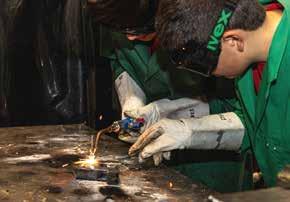
McCarthy (13H) presented with Copper awards. This year saw the 56th Annual Chemistry Olympiad, run by the Royal Society of Chemistry, and Melisa Anyim became the first Ampleforth student to achieve the “double” in a calendar year with a Gold medal here too; a fantastic achievement. Ronaldo Che was also awarded a gold medal. The impressive haul of medals saw Silver awards for Emmanuelle Vidal (13B), Maxime Johannesen (13CT) and Finn McCarthy (13H) and Bronze awards for Lucy Barrett (13B) and Eli Hennigan (13H). The bar has been set high for team GB this summer in Paris to emulate our Year 13 Chemists! Students in Year 12 A level Chemistry were also selected to take part in the RSC Analytical Practical competition, and we await these results.
Our Biologists visited Blencathra in Cumbria for their annual field trip. Despite inclement weather it was an excellent experience in terms of their Ecology studies in the Sixth Form. They also had a visit from Dr Guy Sutton who challenged the students with a series of advanced seminars on Neuroscience, The molecular basis of disease, and Forensic Science. Practical and project work plays a key part in Science education at Ampleforth and the Physics department has done a lot of work in this area with students in Years 7 and 8.
This year, the Science department ran several prep school science days, inspiring the future generation of scientists with a variety of different activities: the wide range of chemical reactions, the science of light, the spooky effects of static electricity, and the use of DNA in crime analysis. We have also offered practical activities for the numerous college open days.

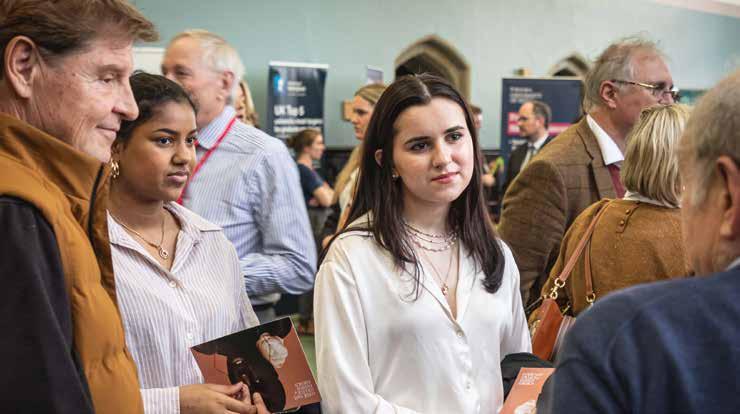
This year has been an exciting time for me as I complete my first year as Head of Higher Education and Careers at Ampleforth College. It has been a pleasure to work with the wonderful staff, students and parents whilst developing our Higher Education and Careers provision.
The highlight of the year is the Higher Education and Careers fair, which wouldn’t take place if it wasn’t for the efforts of our Careers Events Coordinator, Clare Tidmarsh. This is not an easy event to organise – it takes a full year of planning to come to fruition! More than 80 delegates volunteered their time from a wide range of institutions, including many Russell Group universities, Degree Apprenticeship and Professional Services specialists, and Gap Year providers. Some of our delegates travel a long distance to support us, including those from Oxford University, Cambridge University, the New York Film Academy, IE University Madrid, Conde Nast and JCB. It is a busy, successful and informative day, appreciated by students, parents and delegates alike.
Another regular feature of our Higher Education and Careers provision has been our Visiting Speaker programme. This year our speaker themes have included, “My Life in Law”, “Land Management”, “Careers in Finance”, “Careers in Policing and Medicine” and “Summer Experiences and Gap Years”. We have been fortunate that many of our guest speakers have been willing to extend their support by visiting classrooms or offering workshops, such as the Nottingham University Maths department, representatives from Strutt and Parker and Duncombe Park, and the North Yorkshire Music Therapy service who ran a workshop for our Music Scholars.
We continue to support students with Oxbridge, Medicine, International Study and apprenticeship applications, and it is pleasing to see an increasing number of successful applications in these areas.
By Stevaan Hall, Head of Careers
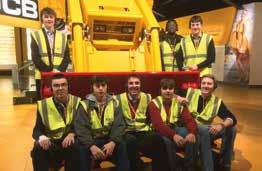

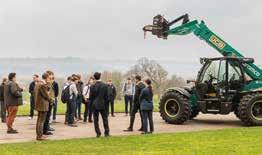
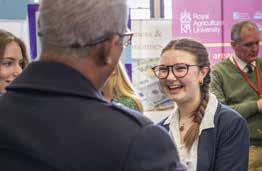

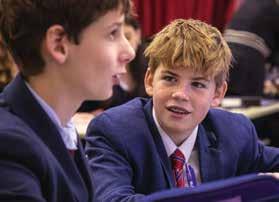

For those that do not know me, I am Mrs Pepper, and I have been asked to talk to you today about Benedictine Scholarship, something I know you have been hearing about in your lessons and year group assemblies.
Firstly, I will explain what Benedictine Scholarship is, followed by what you can do to show its qualities.
Benedictine Scholarship is our way as a community of approaching your studies. It is rooted in our school tradition, as scholarship is at the very heart of Catholic Benedictine culture, and for centuries monastic communities kept alight the flickering candle of knowledge. At Ampleforth we prize learning as central to your formation.
In Benedictine Scholarship, we want you to show certain qualities. We want you to develop good study habits, to have an intellectual curiosity, to critically engage with the world around you, to have a love of learning and an enjoyment of reading; we want you to be reflective, resilient and most importantly, always strive to do your very best.
I wanted to stress the inclusive element of Benedictine Scholarship. It applies to each and every one of you. It is about you being the very best version of yourself and flourishing. It means you need to work hard, but also that your teachers have designed and teach your lessons in such a way that has high expectations for you. They will teach to allow excellence for all students. It doesn’t matter if you feel you are the brightest in the class or find academic studies hard. Benedictine scholarship is for everyone.
Benedictine scholarship is also a way you can live out our school mission. It is an invitation for you to see the value and purpose of life through a transforming encounter with Christ, how you are all are participating in a living Christian community. How you are cherished as a gift, how you must make the most out of every opportunity and know that you are accompanied along the way by your teachers, peers and wider school community. How we all share in a ‘common good’ together in the classroom and acknowledge that our actions impact others.
Finally, I want you to reflect on what this means to you. St Benedict in his Rule gave us tools for good work. You too have tools to help in becoming a Benedictine Scholar, through our Ampleforth values of Attentiveness, Respect and Courage.
How can you show attentiveness in the classroom? How can you respect your peers? And finally, and most importantly, how can you show courage? Because it takes courage to do your very best. It takes courage to keep going. If you find something hard or fail, it takes courage to have high expectations of yourself, it takes courage to challenge those who prevent others from learning and ultimately it takes courage to really make the most out of every opportunity. It will take courage to be a Benedictine Scholar.
By Helen Pepper, Assistant Head Teaching & Learning



The annual UK Youth Rocketry challenge, aimed at students aged 11 to 18 from secondary schools, colleges and youth groups, is to design, build and launch a model rocket with a fragile payload. Rockets have to adhere to specific design rules and must reach a set altitude with a specific total flight duration. And there is no place for what SpaceX euphemistically calls “a rapid unscheduled disassembly” – a rocket that breaks up; all parts of the rocket (other than disposable recovery wadding) must descend, connected together, under parachute.
Ampleforth’s efforts in 2024 saw real fireworks, with the team winning the National Finals! Organised by ADS, the UK trade association advancing leadership in Aerospace, Defence, Security and Space, this annual award has been keenly contested over the past 12 years by students from across the country. Regional contests lead on to a national finals, with the winners going on to represent the UK in the International Final against the winning teams from America, France and Japan held at the Farnborough International Airshow.
While the team’s work is supervised by Dr Anglim, the rocket’s design and manufacture is entirely the work of the students. The trajectory to 2024 has, like all the best quests for perfection, been tough, with plenty of setbacks along the way. Ampleforth’s 2023 entry didn’t even get off the launch pad, being disqualified in the 2023 Regionals. “We’ve gone through so many highs and lows,” said John Ng, a Year 13 member of the team. “We didn’t know how the altimeter worked last year. We thought more fins was the correct design. We forgot to make records of our test flights and even forgot to tie knots to connect the parts together!”
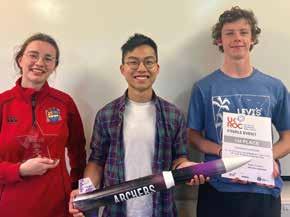
This year, the team has learnt the lessons from previous years, using a checklist to prevent repeating the same mistakes. They got to grips with using CAD and finding out the drag coefficient for different parts of the rocket to make the simulation accurate.
A significant development was the team’s meeting with the Leeds University Rocket Team (LURA), where they learnt about weather cocking. In a nutshell, a less stable base to the rocket means it will balance itself with the wind and therefore go straight up. That led to the all-important decision to change from a 6 fins design to a 3 fins design. This really was actual rocket science! And it was hands-on too, with the team making their own designed nose cone with 3D printing, producing carbon fibre fins, and making home-made parachutes from nylon sheets.
Things really took off at the Regional Finals, held at Elvington Airfield near York, with the team securing first place. It was then onwards and upwards to the National Finals on the last day of the school year. SHAC, we have lift-off! First place secured, with a ticket to the International Finals.
“The team has been amazing and with all the hard work, dedication and of course the passion of the club and the competition, we have made this success happen,” said John. “Without Ronaldo (data analysis), Tiffany (sewing the parachute), Mathilde (data logger), and of course Dr Anglim for creating this club, this amazing result wouldn’t have happened.”
Whatever the outcome of the International Finals, this has been a fantastic achievement; and the whole team is, obviously, over the moon.
Team: John Ng (DO) Year 13, Ronaldo Che (CT) Year 13, Mathilde de Watteville (B) Year 12, Jasper Sai Ping (H) Year 12, Anastasia Wu (B) Year 12, Freddie Goor (CT) Year 9, William Tait (J) Year 11, and Mieszko Dorosz (CT) Year 13.
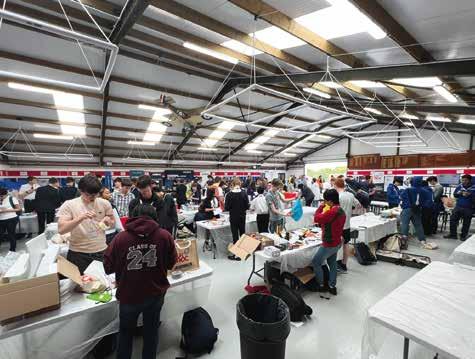
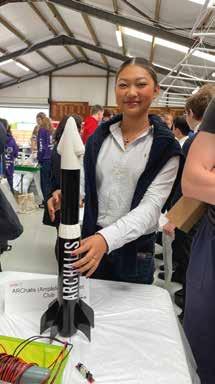
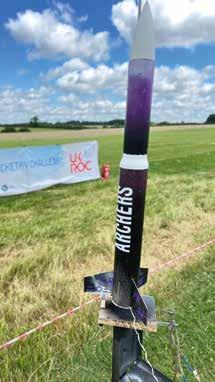
“THE TEAM HAS BEEN AMAZING AND WITH ALL THE HARD WORK, DEDICATION AND OF COURSE THE PASSION OF THE CLUB AND THE COMPETITION, WE HAVE MADE THIS SUCCESS HAPPEN,”

Last year we rekindled many musical events that lay dormant due to Covid. This year that musical fire that is at the heart of the College burns bright and strong. It has been another year packed full of delightful performances in the valley and throughout the UK. I shall summarise them here but do read ahead for more detailed articles written by our students.
2023 saw the 400th anniversary of the death of composer William Byrd. To mark the event, we presented a concert of Byrd’s music and were joined by professional consort Ensemble Pro Victoria. They led an in-depth workshop during the day, sharing their knowledge and talking to our students about the varied career of a professional singer. The Faure Requiem and the St Cecilia Concert remained a fixed point in the Michaelmas term, and it was wonderful to see audiences for both increasing. It was around this time that we heard of Finn McCarthy (13H) being awarded a gap year Choral Scholarship in Canada – a truly wonderful achievement.
We returned to London for the Ampleforth Society Carol Service, though it was more memorable for the journey home – please do read Clara’s article! This was then immediately followed by our performance of Messiah (firmly re-established in our concert series) and the College Carol Service. In amongst all of this were our regular lunchtime recitals hosted by Houses and our more formal evening recitals.
January 2024 started with a bang. We welcomed Mr Muttitt to the College as our new Head of Keyboard and College Organist. Within 24 hours of starting the job he was accompanying the Schola Cantorum for the Vigil Mass at Westminster Cathedral. The choir continues to be on excellent form, and it was a real privilege to sing within the liturgy at Westminster. A few weeks later we had the pleasure of joining Ripon Cathedral Choir for a joint evensong at Ripon Cathedral: superb music and the opportunity to be singing alongside a top choir. By now, rehearsals were well underway for two significant events: House Singing and the Schola 50th anniversary weekend. Two joyous moments which placed music at the centre of the lives of Amplefordians old and new! During the Easter break we heard that a second student had been offered a place to continue her singing postAmpleforth. Felicity Cunningham (13A) was awarded a place to sing in Leeds Cathedral from next year. It was also lovely to hear news and recordings of Lily Sadler (10A), Niamh Lally (12M) and Agnes Richardson (12A) from their National Youth Choir residencies.
Our return from the Easter break began with our third and final trip to London for the Schola to perform Messiah at Cadogan Hall. This performance was masterminded and conducted by OA Charlie Grace (O92)
(also father to Oliver (12CT) who was singing in the Schola). This was a brilliant occasion and it was a privilege to be part of an event to raise money for the Charlie Waller Trust. Exhibition, with its theme of music, was a great undertaking. A new motet (Stella Matutina by Kerry Andrew) was commissioned and premiered at the Exhibition Mass; the newly formed Jazz Ensemble dazzled and entertained in the Refs; the Orchestra presented a superb and demanding programme at the Exhibition prizegiving (including concerto movements performance by Lucy Barrett (13B)) and the pipe band looked and sounded superb on the Bounds during the afternoon activities. We closed the celebrations with a recital given by our senior pupils, many of whom gave their final performances as Ampleforth musicians. As I write, we’re preparing to take a small number of the Schola to the Sedbergh Festival for a workshop with the BBC singers, we continue to prepare students for their ABRSM examinations; and the Schola continues its twice-weekly offering in the Abbey.
I’ll sign off with the words I shared with the Year 13 musicians after the Exhibition Recital. “You must keep playing, keep singing. The world is fractured and in a parlous state and it needs the arts to rekindle joy and hope. Please go out and share your gifts.”
By Edward Seymour, Director of Music


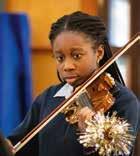
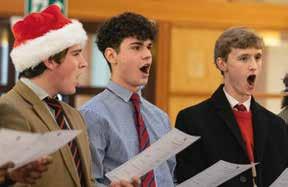

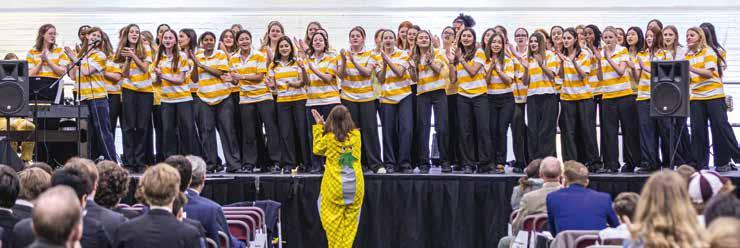
In October, the Schola had the privilege of performing the Byrd 400 concert alongside Ensemble Pro Victoria (EPV). Leading up to the concert, we prepared the Byrd four-part Mass and some of his other famous works, such as Cibavit Eos and Civitas Sancti.
On the day of the concert, EPV held a workshop in the afternoon, and each member introduced themselves to us, giving an account of their experiences of choral music throughout their lives so far. They spoke of how they first began singing choral music, whether that was through school choirs or through being choristers, and they all expressed their passion for choral music as they addressed us. They provided an excellent insight into professional choral music, which no doubt inspired us all.
Additionally, EPV performed some of Byrd’s work alone for us. They worked as a collective to create the best blend whilst also maintaining enthusiasm, and the sound they made was exceptional. Following this performance, EPV, being the specialists in early music that they are, gave helpful suggestions which unquestionably enhanced our sound, especially in the Abbey where we rehearsed later on.
Just before the concert began, Professor James Weeks from Durham University gave a pre-concert talk about Byrd, who was an English Renaissance composer. As a devout Catholic, much of Byrd’s work was inspired by his faith. He produced many sacred works in Latin, which were used for recusant use in forbidden Catholic Church services. Since he lived in post-Reformation England, Byrd couldn’t practise his faith in public, and so he risked his life by writing music for Catholic use. His bravery is an inspiration, and a constant reminder of how we mustn’t take for granted how lucky we are to practise our faith in this school without fear of persecution.
We performed the concert to a full audience, making it clear that all our efforts had paid off. The highlight of the concert for me was the ‘Ave Verum Corpus Re-imagined’ by Roderick Williams. This piece takes Byrd’s famous motet and re-imagines it for three unaccompanied SATB choirs. A small group from the Schola joined EPV for this piece, and the effect in the Abbey was unforgettable.
Overall, the experience with EPV was incredibly beneficial and I hope the Schola has more opportunities to work with them and other professional ensembles in the future.
By Agnes Richardson (A) Year 12
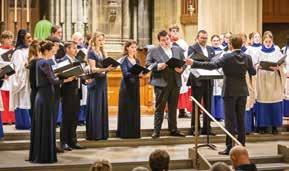
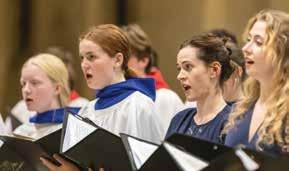



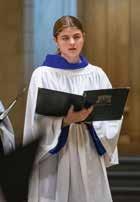
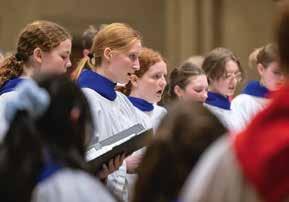
In November 2023, just after the feast of All Souls, the Schola Cantorum performed the spiritual meditation that is Gabriel Fauré’s Requiem, a serene commemoration of the faithful departed and prayer for eternal rest for the souls of the dead.
There were two exquisite solo performances; Pie Jesu, gracefully sung by soprano Felicity Cunningham, and Libera Me, impressively sung by Finian McCarthy, bass. Both soloists are senior singers in Schola, exemplifying the talent and standard we strive to maintain.
Although many of us had sung Faure’s Requiem before, we all delight in learning together, rehearsing expressing the emotion of the liturgy, and enjoying our favourite movements. Being accompanied by the highly experienced William Dore on the organ, and led as ever by the wonderful Edward Seymour, really helped us to deliver a professional and moving performance. Our experience, and the fantastic responses we had from all those who came listen to us that evening, reflects how sacred music can impact and inspire. As we sing to the whole school at least weekly, this is something that touches all students during their time at Ampleforth College, not just those in Schola.
By Niamh Lally (M) Year 12
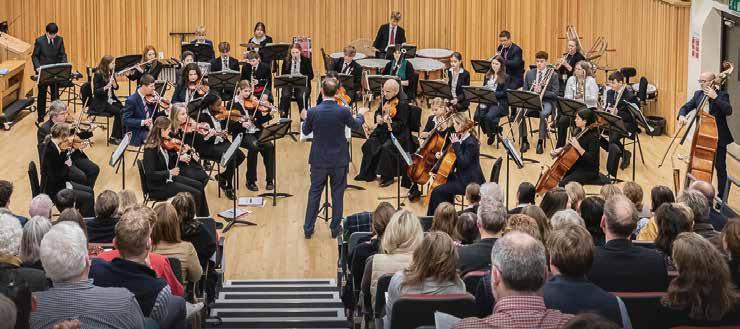
The St Cecilia Concert is an annual concert that highlights the ensemble music that Ampleforth students learn and perfect in the first term. It includes the Ampleforth Highlanders Pipe Band, the Chamber Choir, Pro Musica, the Jazz Ensemble and the Orchestra – all with a variety of music of different styles.
The concert started with a lively entrance from the Ampleforth Highlanders, consisting of both pipers and drummers – Calypso (A) Year 10 being Drum Major and Will (J) Year 13 the Pipe Major. The Highlanders performed four traditional pieces for us, led by the Senior Pipe Major, Mr Robinson – it was a fantastic start to the concert.
The Chamber Choir, a vocal ensemble conducted and directed by Oliver (CT) Year 12, then performed three beautiful pieces set for all voice parts. These were really well received and all who watched were very impressed by Oliver’s leadership!
Next, Pro Musica, a small and selective strings ensemble consisting of violin, viola and cello and directed by Ms Hicks, played two wonderful pieces by Telemann and MacDowell. These were a delight to listen to and again loved by the audience!
The Jazz Ensemble, a purely student group led by Emil (DO) Year 12, brought in a twist in musical style, performing three pieces by Dorham, Kosma and Mark & Simons. Niamh (M) Year 12, performed an impressive vocal solo in one. The performances were entertaining for both the audience and the musicians, with the ensemble receiving a standing ovation at the end.
Last but by no means least, the College orchestra came on, conducted and directed by Mr Seymour, and led by first violin Lucy (B) Year 13. They started with three movements from the Variety Suite for Orchestra by Shostakovich – a huge well done to the soloists: Ronald (J) Year 9, Agnes (A) Year 12, Humphrey (H) Year 12, and Finn (H) Year 13. This was followed by the Berceuse and Finale from the Firebird Suite by Stravinsky, a beautiful piece originally played in the Russian ballet. The pieces had such a variety in style and the orchestra really encapsulated this in their playing - an impressive end to the concert.
This year’s St Cecilia Concert was a huge success and huge congratulations to all those who put in the hours of hard work…they very obviously paid off. We are already looking forward to next year’s concert!
By Dora Potts (A) Year 12


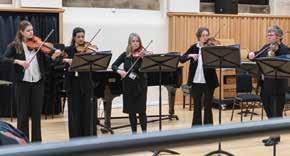


On 2 December, the Schola travelled down to London to perform the annual Ampleforth Carol Service in Covent Garden. Being one of the highlights of the Michaelmas term, revising and learning carols ended up being a steady process which came very naturally to everyone involved. Upon our arrival, we took a trip on the London Eye before walking over to Corpus Christi Church where we began to rehearse and familiarise ourselves with the acoustics. As ever, the service was a huge success with pieces by a range of composers including Judith Weir, James MacMillan, and Philip Stopford. These were combined with several hymns, and readings by members of the Ampleforth Society. We were particularly lucky to be joined by Aileen Baker (A13) who sang the soprano verse in Handel’s Glory to God. Following on from the performance, we had the chance to catch up with family members and OAs who had come to show their support. It was a lovely occasion which saw the coming together of current students with old students, and it highlighted many of the capabilities of the Schola.
It is safe to say, however, that the most memorable part of the trip was the return journey to the valley. After learning that cable damage would keep us on the train in Doncaster for nearly three hours, we made our best attempt to keep spirits high by singing Christmas carols as entertainment for the other passengers in the coach. For those of us who managed to stay awake, this was received with gratitude, many smiles, and multiple recordings (which later went viral on social media). We also shared conversations and compared our own experiences with them. After what would have been a somewhat miserable journey, turning a scenario like this into something so unforgettable made the trip that much more rewarding, and this is something which will be remembered throughout the years to come.
By Clara Sharpe (A) Year 13
SENIOR MUSICIANS RECITAL
Ampleforth College recently hosted a brilliant concert to display the exceptional talents of several of our senior musicians.
Alix Hamilton opened with a stunning piano performance, displaying technical precision and deep emotional connection. Lucy Barrett followed with a graceful flute performance, marked by impeccable breath control and expressive phrasing, enchanting the audience. Agnes Richardson concluded the solo performances with a soulful saxophone piece, captivating listeners with her rich tone and emotional depth.
Emma, a gifted pianist, displayed her refined technique and emotional depth as her fingers danced across the keys. After which, Lily Sadler sang with a melodious voice which filled the room. Together, they created an unforgettable performance that captivated the audience and highlighted the promising talents of these young musicians.
By Lily Sadler (A) Year 10
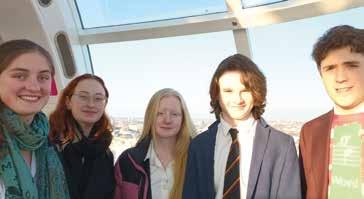
The Schola trip to Cadogan Hall to perform Handel’s Messiah was a highlight in the school’s musical calendar. Our day started with an early departure from Ampleforth. Arriving in London just before midday, we went to the Victoria and Albert Museum to explore and get some lunch. Our rehearsal afterwards at Cadogan Hall kicked off with a rousing 18th Happy Birthday rendition for Becky B! We rehearsed all the choir-only pieces with an amazing orchestra (many of whom were principals from some of the finest orchestras in the UK). After a pizza supper, we got into our robes for the concert.
The concert attracted an audience of around 600 people, and we performed under the baton of Charlie Grace (O92), singing alongside his choir, Vox Cordis. It was a thrilling experience! We were incredibly lucky to perform with four incredible soloists - Hilary Cronin (Soprano), Tim Mead (Countertenor), Nick Pritchard (Tenor) and William Townend (Bass). The audience stood up for the Hallelujah Chorus, as is tradition, and at the very end gave us a standing ovation which was a lovely surprise! It was great to discover many OAs had made the effort to attend this concert, along with Peter and Marie Roberts.
The concert was in aid of the Charlie Waller Trust whose vision is a world in which young people are educated to understand mental health and get all the support they need. It raised just under £32,000. More details about their amazing work can be found here: www.charliewaller.org.
It was a very late return to Yorkshire but some of us managed to turn up to lessons the next morning at 8:40am! It was an experience the choir will never forget, and I heard that some of the orchestra players made lovely comments about our highquality singing. The Schola is incredibly grateful to Mr Seymour, Mr Muttitt and Miss Lally for this trip.
Will Shipsey (H) Year 13
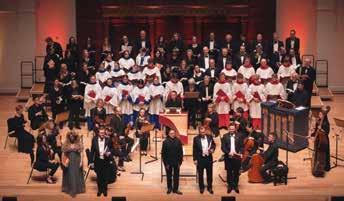
Early in the Spring Term, the Schola Cantorum were fortunate enough to venture down to London to celebrate Mass at Westminster Cathedral. After our relatively lengthy journey, lunch was undoubtedly at the forefront of everybody’s mind - a small Italian restaurant with a bustling atmosphere kindly accommodated our contingent.
We were greeted at the entrance of the Cathedral by organ scholar and OA Christopher Too (J18). The Cathedral is notably impressive for both its scale and Christian Byzantine architecture, complemented greatly by the single bell tower standing at 284 feet. The viewing gallery at the top offers a superb panoramic view of the city and we were taken up in small groups to fully embrace the ‘Bird’s Eye view’. Tours of the Cathedral were going on simultaneously, led by Fr Ambrose. It was a truly enriching experience to look upon the contrast in the Cathedral’s lower reaches of intricate mosaic decoration, to the upper reaches of ceilings blacked with ‘a century’s worth of soot, incense and candle smoke’. A distinct highlight was the individual chapels in the name of every patron Saint to the home nations; a unique feature, and we were privileged to see them.
The choir sang in the apse behind the altar and I personally felt the service to be a lot more intimate from this perspective. We sang Byrd’s Mass for four voices and ‘Messe Solennelle’ by Louis Vierne which feel like two quintessential arrangements for the Schola. The latter has been a notable favourite of ours this year, so it was a joy to sing it in such an extraordinary place. At the offertory, we sang Byrd’s ‘Cibavit Eos’, a tremendously beautiful piece that felt richly supported by the acoustics of the Cathedral; with the absence of an organ this piece feels texturally and harmonically so prominent. Finally, during communion, Kerry Andrew’s ‘O Nata Lux’ was the final piece and felt truly resolving; a sense of tranquility and stable harmonisation finished our choral worship in a very successful and enjoyable trip to the Cathedral.
Before our departure back to the valley, greetings with parents and OAs were exchanged to top what was a truly lovely experience and day out. As a choir we were eternally grateful to be invited to sing in such a significant and holy place; the day will never be forgotten.
By Humphrey Kibblewhite (H) Year 12
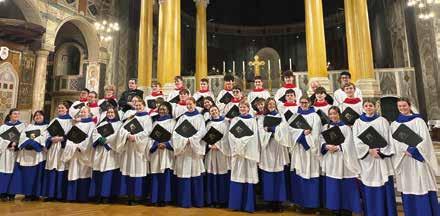

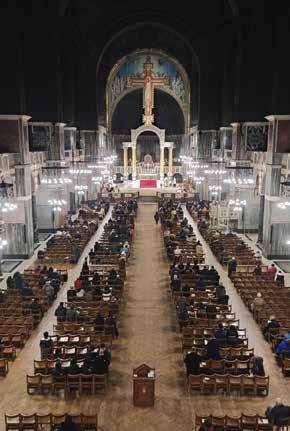

The 50th Anniversary of the Schola in March was a magnificent weekend-long celebration where former members of the Schola returned to the Valley to sing with current members plus orchestra to a packed Abbey Church.
On the evening of Friday 8th March, it was the feast of St John of God. To commemorate this, we sung Hadyn’s St Joannis de Deo Mass, followed by our other motets, Kerry Andrew’s Before the ending of the day, and Philip Moore’s Like the Deer that yearns, a piece commissioned especially for this celebration. The Monk’s Choir was full.
On Saturday afternoon, we had a final rehearsal for the evening’s performance of Mozart’s Requiem in D Minor, with a student conducting the first movement! The evening was fantastic with a huge turnout, a packed Abbey church and incredibly high standards of music despite such short rehearsal time. The soloists were all Old Amplefordians who have continued their singing at the highest professional level which was very inspiring.
For Sunday School Mass, it was wonderful for our current schola students, robed up, to be joined in our procession into the Abbey Church with all the Schola alumni. We sang God’s Grandeur by Wilby, and O clap your Hands by Vaughan Williams, joined by a professional brass ensemble and one of our fellow students playing the Timpani. What a roaring sound! It filled the Abbey’s acoustic, which sounded amazing.
This momentous occasion was a magnificent experience for all involved. Special thanks go to the Music department for their amazing work to make this possible, and what a wonderful weekend it was!
Oliver Grace (CT) Year 12



I was very proud to see Amplefordians involved in the televised King’s College Cambridge Carol Service on Christmas Eve. In the Choir we had Ben Turner Berry (H18), who was an Organ Scholar at Corpus Christi College with a First-class degree in Music and now a postgraduate choral scholar at King’s, and Theo Carter, chorister at King’s, who will be joining us in Year 9 in September. Alice Hunt (A20) who got a Double First degree in Classics at Gonville and Caius College and is now taking an MPhil at King’s, did one of the readings.
At the Westminster Cathedral Choir School Christmas Celebration, Chris Too (J18) who held Organ Scholarships at King’s and Jesus Colleges Cambridge, at Gloucester and Salisbury Cathedrals, and now at Westminster Cathedral, played the organ. Henry Laird (O16), who was a Choral Scholar at St John’s College Cambridge, was the Tenor Solo, and Dan Fernandez, chorister at Westminster Cathedral and joining us in Year 9 in September, sang in the choir. Many congratulations to our Music Department for nurturing such talent!
By Peter Roberts, Head of Ampleforth College
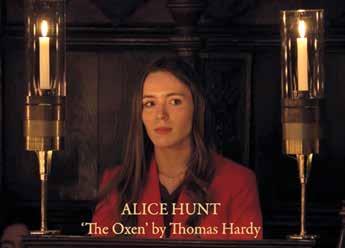

MUSIC AT EXHIBITION
Music was at the centre of the 2024 Ampleforth Exhibition with multiple groups getting involved such as Chamber Choir, Pro Musica, Pipe Band, Jazz Ensemble and the Schola Cantorum each doing their own bit. The Schola started off the even with Choral Mass in the Abbey on Friday evening. This was particularly poignant as it signified the Year 13’s last full service to the choir as they performed works by Dove, Bairstow and Bruckner. A wonderful introit by Dr Kerry Andrew, Stella Matutina¸ was specially commissioned for this service. Music then shifted to the Refs where the Jazz Ensemble, led by Emil Lovegrove (DO) Year 12, gave a sparkling performance throughout the evening’s festivities.
Saturday morning was the turn of the College Orchestra and Pipe Band. The Orchestra gave performances of Danzon No. 2 by Marquez, Mambo from West Side Story, Flute Concerto by Carl Reineke (with the flute solo played beautifully by Lucy Barrett (B)Year 13), and finally performing Run by Snow Patrol with the Pipe Band. The standard of the music was exceptional.
The afternoon offered up a recital from many of our senior musicians. It was wonderful to see so many perform individual solos, showing courage as well as talent. It was heartening to see musical students receiving awards at Prize Giving in recognition of their impressive commitment, and lovely to hear the Headmaster talk about his pride and support of music at Ampleforth, putting it centre stage at this year’s Exhibition. A particular quote stands out from his speech, ‘music is the beating heart of the community’. I feel this speaks volumes and gives high praise to each SHAC musician, both current and previous, and their sacrifices towards providing a unique service for the other students. A particular thanks to Edward Seymour and all the music department for making this possible.
By Giles Hill (J) Year 12
RIPON CATHEDRAL EVENSONG
The Schola had the wonderful opportunity to experience a different type of liturgy and to work alongside professional singers when singing with the Ripon Cathedral Choir last February. The service was led by the Dean of Ripon, joined by Fr Ambrose. Dr. Krippner, the Director of Music at Ripon Cathedral, conducted the music with pieces by Stanford and Balfour Gardiner. He had kindly given up some of his time before hand to rehearse through the pieces which was really beneficial!
The Ripon choristers were very welcoming letting us share their vestries; we all had great fun. A highlight was definitely going down inside the crypt, the oldest in Europe, built in the time of St Wilfrid. Although it was extremely small and narrow, luckily it was lit and we could walk through it.
Becky Brown (A) Year 12
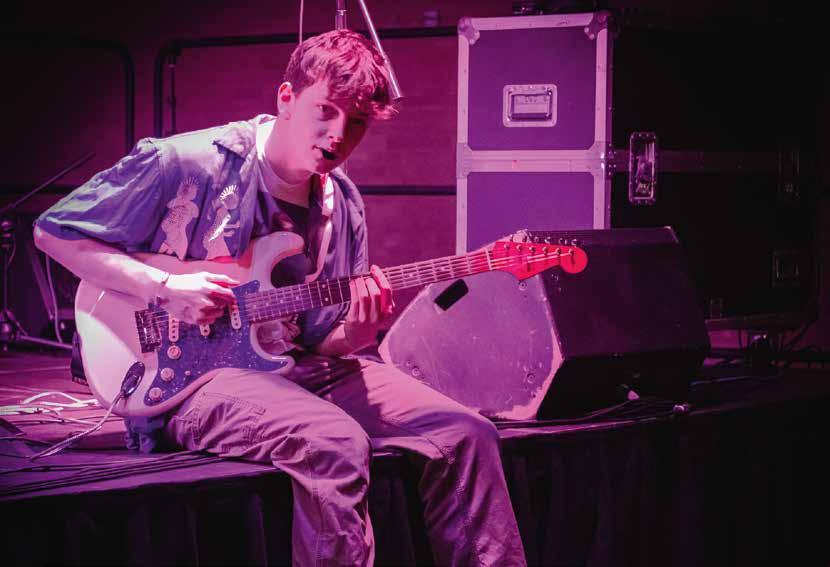




SHAC Rock is the annual student-led concert in aid of FACE FAW, our school charity. The whole school flocks to the Sports Hall, with the heightened enthusiasm of those not facing a training session, to hear a variety of student bands put on a 2 hour show. This year’s stellar line-up of wannabe rock stars included the ‘Red Hot Chilli Prayers’, ‘Fleetwood SHAC’ and ‘The Weird Monks’. With budding impresario Zander Buchanan (DO) Year 12 in charge of the set list and putting together the show, it is pretty much all studentled apart from the help of the stage and lighting rental company. All proceeds go towards FACE-FAW which works to help those in need and those who are suffering in the UK and around the world. Coming off stage after a pulsating performance, Emil Lovegrove (DO) Year 12 said, “With much of the College’s music each week being focused on the Abbey and classical performances, it’s nice to switch it up and see some fast paced, head-bopping music played by your friends. The students who take part enjoy it as well, not just the music itself, but also because it feels valuable and that you’re contributing to a good cause.”

Emil added, “Another important aspect of SHAC Rock, as many of this year’s performers will attest, is that it provides an inspiration for other students, especially the younger ones, to participate in these school events. Not only does it improve individuals’ ability to play music and participate in a band, but it also brings people together, allowing students to make new friendships across the year groups, as well as supporting such an important cause at the same time.” Reflecting on yet another epic, sweaty, uplifting afternoon, Zander paid tribute to all the bands’ hard work: “Rehearsals were crucial for the success of the concert. It’s not easy fitting these in with everything else going on, but however much they managed, they’ve all shown today it was worth it.”

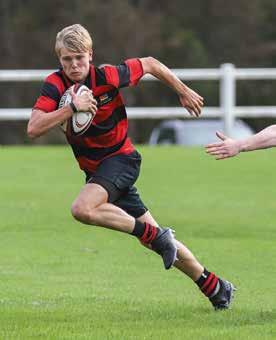

RUGBY
As ever the effort and determination shown by all the students who are involved in the rugby programme on the field of play this season has been second to none. Fielding nine teams and playing over 70 fixtures, there has been an opportunity for every student who chooses rugby to represent the school on Wednesday or Saturday afternoon. Playing in one of the most competitive fixture circuits in the country, I’m pleased to say that, in particular, our 1st XV had a positive season recording memorable victories and hard to accept losses against quality opposition. Allied this with a successful Northern Ireland half term Rugby tour that included fixtures against some of the strongest schools in province, and the selection of 1st XV team members, Josh Oke (J) Year 12 in the Yorkshire Rugby Academy and England Under 17 training squad, and Benny Hill (DO) Year 11 in the North Yorkshire developing player programme, the future seems very bright for next season. Special mention to the 2nd XV who were statistically the most successful rugby team, playing nine games, winning seven and losing two. Congratulations to all involved. I am also extremely pleased with the development of our Under 13s, who albeit did not have the most successful season on paper, showed huge collective development with a number of students playing rugby for the very first time.
By William James, Director of Sport
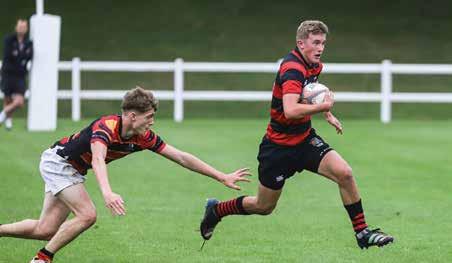
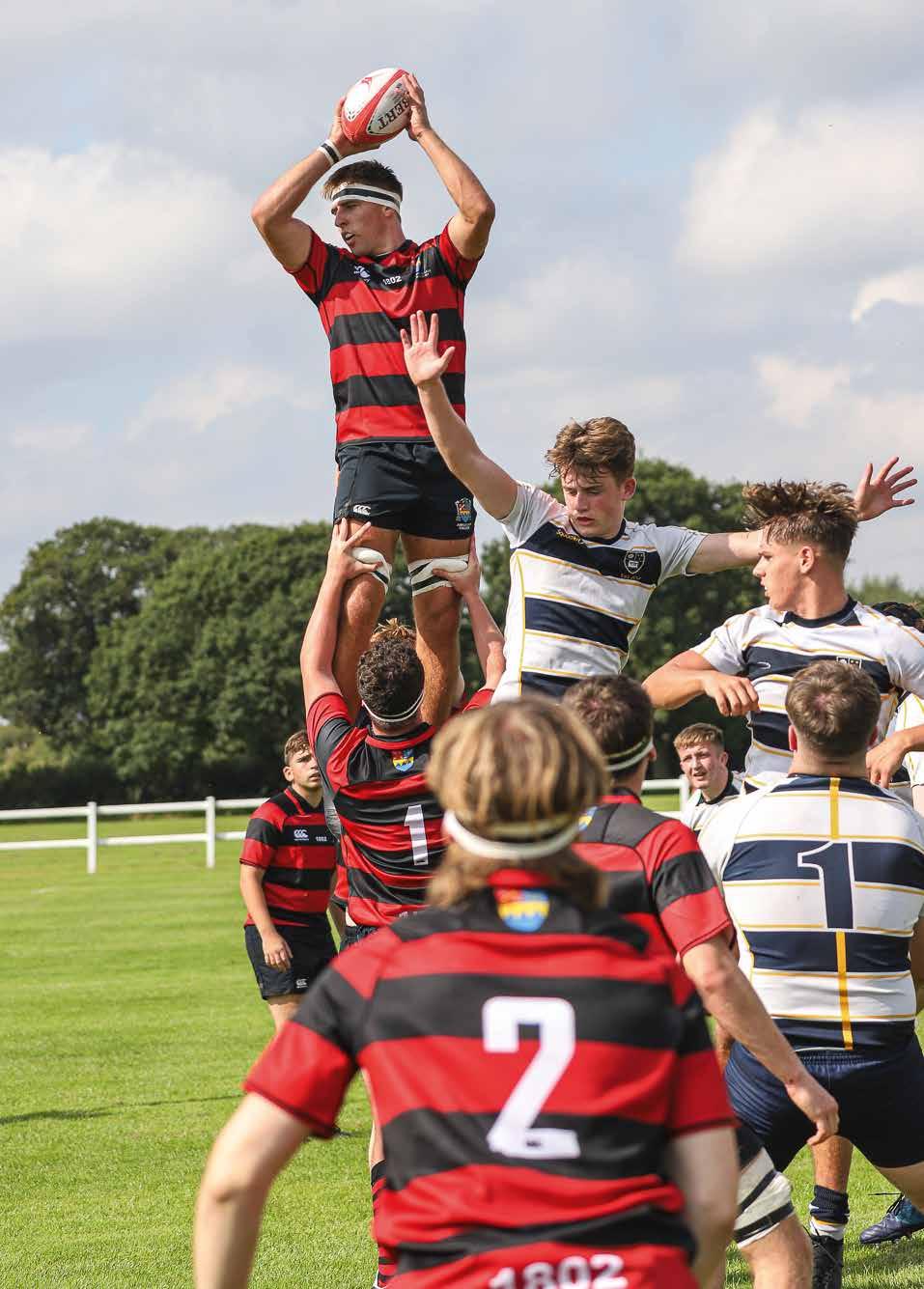



Our girls’ hockey programme has been hugely successful playing a total of 89 matches and winning a total of 62, resulting in the most successful girls’ hockey programme we have had in ten years. Our 1st XI girls won 11 out of 16 regular season matches and progressed to the North of England finals, notably with Chloe Grace (M) Year 11 scoring a remarkable 25 goals for the team over the season. Statistically our U13 XI were the most successful team winning 15 out of their 18 matches and scoring a remarkable 47 goals - an amazing achievement in particular when playing schools with higher student numbers. The U14 girls excelled and reached the semi-finals stage of the national tier two finals, losing narrowly on penalty shuffles, finally finishing runners up in the North-East. I am pleased to say that we have had over 14 students in the girls’ hockey programme accessing performance pathway and representative hockey over the last season. In particular, Chloe Grace and Amelie Winter (B) Year 12, both gaining access to the England Talent Academy pathway - a fantastic achievement.
By Justin Metcalfe, Head of Hockey



In the Lent term Netball is our flagship girls team sport, with over eleven teams representing the school week in week out in a highly competitive North East of England fixture circuit. The 1st VII was highly competitive, recording a season of playing eight matches, winning four drawing two and losing two. Our most successful team were the U14A, who played six, and drew one - a fantastic achievement and one that bodes well for the future. The U13A netball team were the most prolific when it came to scoring goals, with 191 in total for the season, followed closely by the 1st VII with 178 goals.
I’m pleased to say that Agnes Barrett (EW) Year 7 and Thea Camacho (M) Year nine were selected for their respective North Yorkshire netball performance pathway programmes, an outstanding achievement as both girls are a year young for those specific representative honours.
By Hayley Edgar, Head of Netball


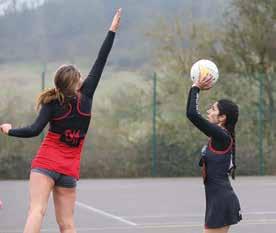
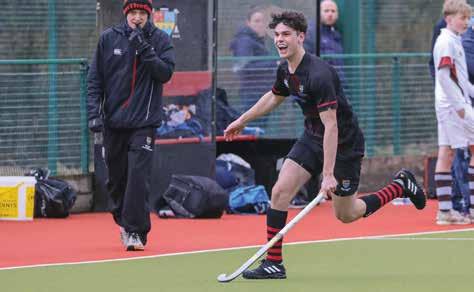

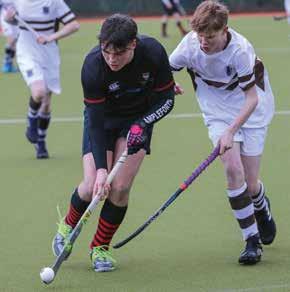
The boys’ hockey programme is going from strength to strength, fielding ten teams and playing over 56 matches. It is fantastic to see so many students accessing such a successful programme. Our 1st XI Boys reached the final of the T3 North of England Tournament at Leeds University and recorded an overall season of playing 13 winning seven losing five and drawing one.
The U14 Boys were particularly successful winning seven of their nine matches and scored 30 goals, which is an impressive achievement and bodes well for the future of hockey at Ampleforth. As our overall boys’ hockey provision continues to grow, I am pleased to say that we have had over seven students accessing performance pathway hockey, with Noah Rothwell (H) Year 11 in particular gaining access to the England talent Academy system. I’m excited to see what next hockey season brings.
By Justin Metcalfe, Head of Hockey
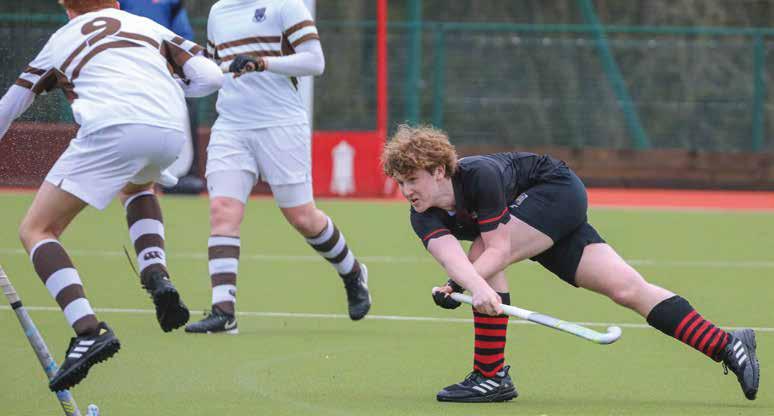

The boys and girls have had a fantastic tennis season this summer. The girls won 26 out of 31 matches (83% win rate) and the boys won 25 out of their 34 matches (73% win rate)! Well done to all those students who have represented the school in matches. Highlights included the 1st Team girls reaching the semi-finals of the Aberdare National Cup and the Boys 1st Team beating Sedbergh and St Peter’s.
Justin Metcalfe, Head of Tennis
FOOTBALL
Football has been a key offering and sport in the Lent term for a number of years now at Ampleforth college, and I’m pleased to say that we have over 50 students participating in the programme throughout the Easter period.
Albeit a challenging season on the field I’m pleased to say that the commitment and delivery of football at Ampleforth is continuing to develop. I am sure it will be a positive season next year.
By Hugh Ainscough, Head of Football
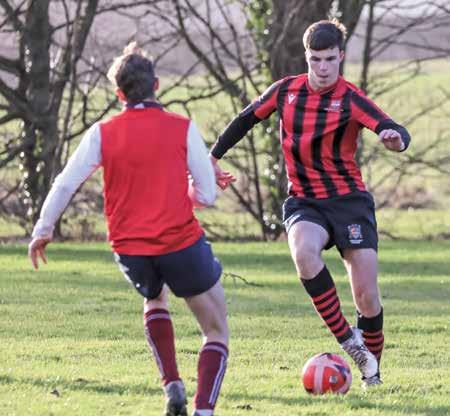
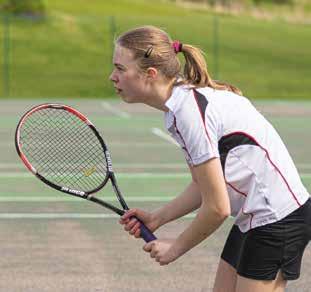


The Cross Country season started with the team captains Evie Tempest (M) Year 13 and Sam Bartle (CT) Year 13 battling for positions on a fast, and sweltering, 10km fell race at the Castleton Show. This was followed swiftly by John Ng’s (DO) Year 13 outstanding effort at the Paras 10 mile TAB (tactical advance to battle) with boots and 35lbs of weight. At a local orienteering event on the Moors near Whitby, Will Tait (J) Year 11 and Paul Muscat (H) Year 11 used their navigational skills to outrun the others. Amelie Winter (B) Year 12, Jemima Jenks (A) Year 12 and Anna Harrison-Topham (M) Year 12 all raced hard at local heats to win places on the North Yorkshire squad and deserve congratulations for this achievement. In January, it was a pleasure to host a growing crowd of OAs who were pushed by school runners for every place at the OA Cross Country fixture. The OAs (recent leavers and veterans) retained the Corbould Cup for now. Erin Anglim (B21) became the first female OA to take part and we hope women will feature more in future OA races in the future. Ampleforth boys and girls dominated the Stonyhurst teams with an exceptional performance from Liam Gould (CT Year 11), who had recently smashed his 5km Parkrun PB. We look forward to even more PBs, running challenges and races next season.
By Brendan Anglim, Head of Cross Country

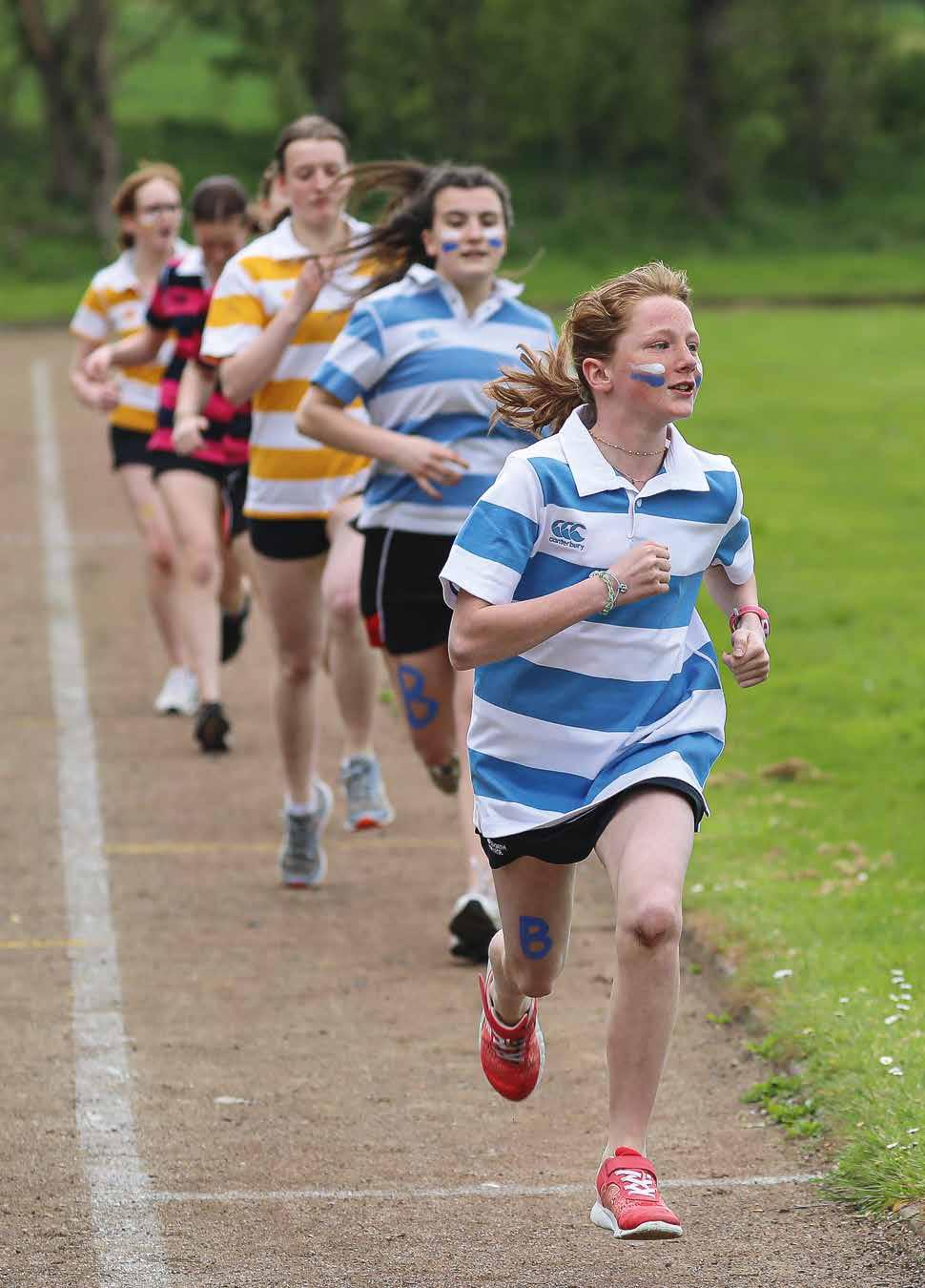


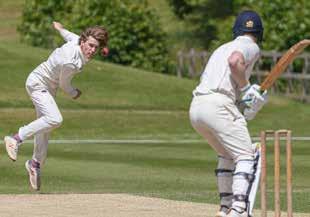
Set in an outstandingly beautiful location with facilities second to none, it is clear to see why cricket is such a popular option as a summer sport. Unfortunately, the summer never arrived! Nearly half of all fixtures had to be cancelled and the momentum that would have been built with a busy start to the term, never materialised.
There were some excellent performances by both boys’ and girls’ sides with notable victories for the U17 Boys’ National Cup side and the Under 14 girls against Sedbergh.
The Emeriti Schools’ Festival was yet again hosted in the valley and over 180 students took part in the Under 13 Worsley Cup in the last week of term. As the cricket programme continues to develop, I’m pleased to say that we have a number of students accessing performance pathway participation, not only at club level, but for North Yorkshire and Yorkshire itself. This in itself is a fantastic opportunity and achievement for those students involved, and in particular an opportunity for them to develop their own skill set, but also to contribute to the overall performance of Ampleforth College cricket. With the refurbishment and completion of the Robin Dyer cricket nets facility and a full winter training programme in place, I am sure that cricket will continue to develop in a positive manner and we will see the benefits of these training programmes come to fruition next summer.
By Sebastian Phillips, Head of Cricket



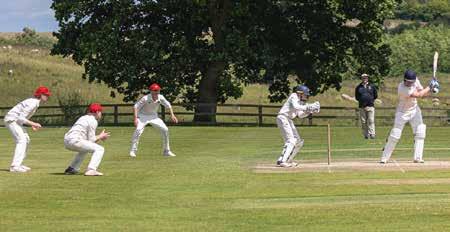
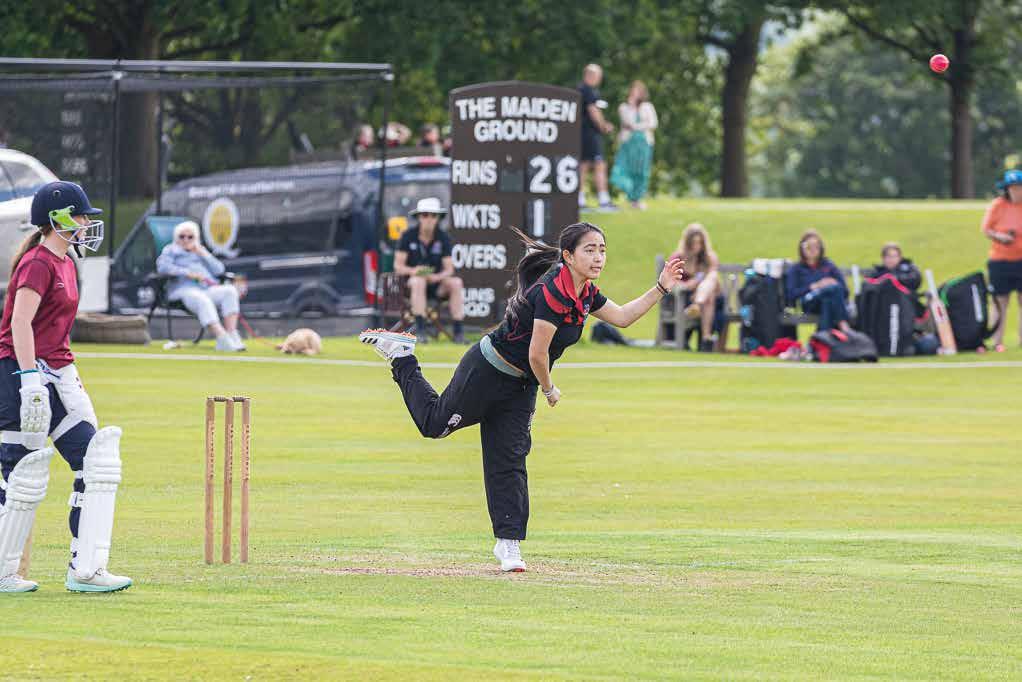
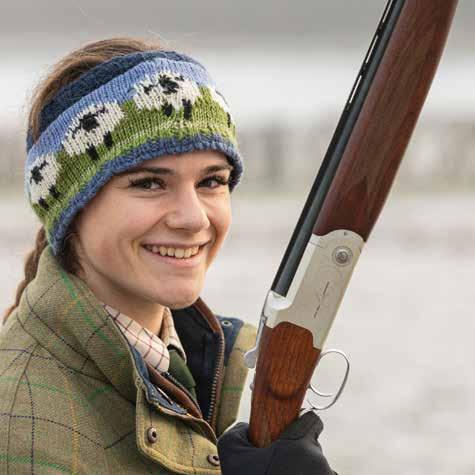
Ashoot day at Ampleforth is a day all the students in the Shoot team look forward to, well who wouldn’t with Pheasant samosas for lunch every Saturday! They really are a delicious addition to our day.
We have had another successful shoot season, with all nine students of the gun line enjoying some wonderful days’ shooting. The beaters provided the gun line with some high and fast birds, resulting in excellent afternoons.
The flush of birds early in the season from Sandpit was a delight, as were the first ducks off the pond, Nicko’s face was a picture when those ducks took flight; only to prove to be too fast for the guns!
The beating line did a fine job again this year, even on the days when there were only four beaters and

Mrs Cook out beating. Teamwork in the shooting field comes naturally to those who enjoy their Gamekeeping and Shooting here at Ampleforth.
Hector Corrie (DO) Year 13 did a great job as Shoot and Beagling Captain this year, keeping the long-standing connection with the Ampleforth Beagles a strong one. Nicko Price (CT) Year 12 will take over as Shoot Captain this coming season, alongside Ophelia Bell (B) Year 12 as Vice Captain. Ophelia will also take up the Whip as Captain of Beagling too.
The dressed pheasant from the shoot season was offered to staff within the school at the end of the season, which resulted in over 40 members of staff taking this up and funds being raised towards the shoot dinner for the students.
It was lovely to be able to invite parents to accompany the students on shoot days again this season, and we look forward to running a Clay Shoot next school year for former shoot students and parents to join us.
The season culminated with a superb end-of-season dinner alongside the Equestrian team, parents and staff, which this year was held at the Pheasant Hotel in Harome.
By Eliz Cook, Country Sports Coordinator

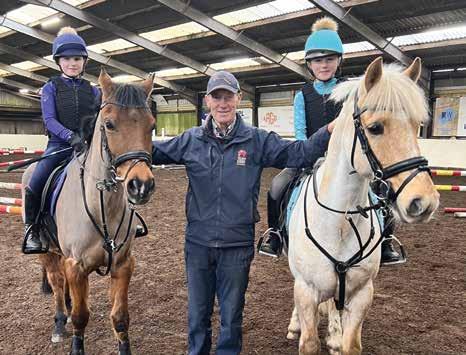
The school’s Equestrian Team have had another successful year, with riders qualifying for the NSEA Eventers Challenge Championships at Hickstead, and for the NSEA National Championships in October.
Poppy Bramall Peill, and Olivia and Elizabeth Bellamy, represented the School at Hickstead in May, at the NSEA Le Mieux Eventer’s Challenge Championships.
The three girls represented the school with true professionalism, putting in many hours of preparation work prior to the Championships. Poppy finished a very well-deserved 6th place in the Eventers Challenge Final. The three girls finished in the top ten riders in nine of the classes they competed in over the three days at the Hickstead Championships.
Miles, Elizabeth, Olivia and Poppy have all enjoyed lessons this year with Christopher Bartle, British Eventing’s High Performance Coach. Miles has now finished his schooling at the College and is moving on to a gap year in which we hope he will be competing his new horse and making the most of his lessons with Christopher!
Tamara Cotton has made a successful debut on the team this year, qualifying for the NSEA National Championships Silver Plate classes.
Equestrian Achievement prizes were awarded at Exhibition to Poppy Bramall Peill in recognition
of her successes this past season. Not only has she competed successfully at Hickstead, but finished in 6th place in her first One Day Event representing the school too. Poppy Speir was also awarded at Exhibition for her commitment to improving her riding. Poppy’s confidence in her ability has gone from strength to strength with the help of the lessons at Friars Hill Stables.
The Equestrian team joined the Shoot team for a wonderful evening at the Pheasant Hotel for the end of season dinner which we all enjoyed.
By Eliz Cook, Equestrian Manager
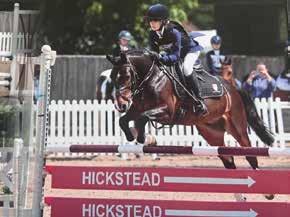


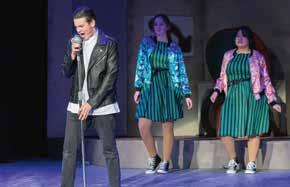
This year, in the Drama Department, we have successfully performed the musical ‘Little Shop of Horrors.’ Undertaken by our Seniors, Years 11, 12 and 13 and supported by the Juniors, Year 9 and 10. The production was a resounding success, offering students the chance to explore their acting and singing abilities. Led by an extremely strong cast, working in conjunction with the Music department, led by Mr Pallister, the group worked hard to develop a sense of cohesion which led to a highly positive and energetic performance. As well as the performers, we had a dedicated group of students who supported through set design, technical support and costume design. The effort shown was exemplary and helped create an extremely memorable performance. Our Green Room students took on the challenge of creating a giant man-eating plant puppet from first principles, designing, constructing and painting it in its entirety. To be of use, it had to match the other puppets that were hired in, and be comfortable for the puppeteer to use, and durable enough to withstand the rigours of the performance. Our large crew did an amazing job operating the lights and sound and coping with the complicated scene changes in this wonderful and very successful production.


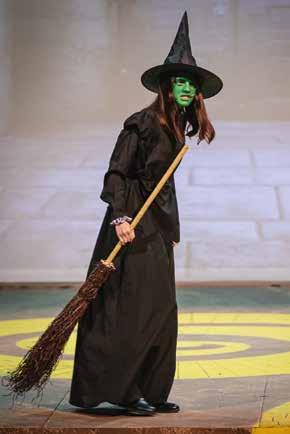


The second instalment of our packed programme was ‘The Wizard of Oz’. The Juniors, composed of Year 9s and 10s, came together to produce our second musical of the year! Working on their dancing and singing skills, the group developed their understanding of working as part of an ensemble. Using an immersive set which extended out into the grounds, we welcomed parents and students by asking them to follow the yellow brick road painted by our Green Room students. The Year 12s took the lead in running the technical elements of the production, whilst working with and building the skills and confidence of our younger stage crew members.
Finally, in June, Year 7 and 8 took part in ‘a play in a day,’ with the theme ‘A Street Through Time.’ This allowed the youngest of our students to experience taking part in a full performance before a large audience.
Dance has developed greatly during 2023-24, with student numbers growing, and a wide variety of styles being learned, creating highly versatile performers amongst our students. Our dancers have participated in the school musicals, along with performing recitals and showcases throughout the year to display their hard work and undeniable talent.
By Emma Naylor, Head of Drama
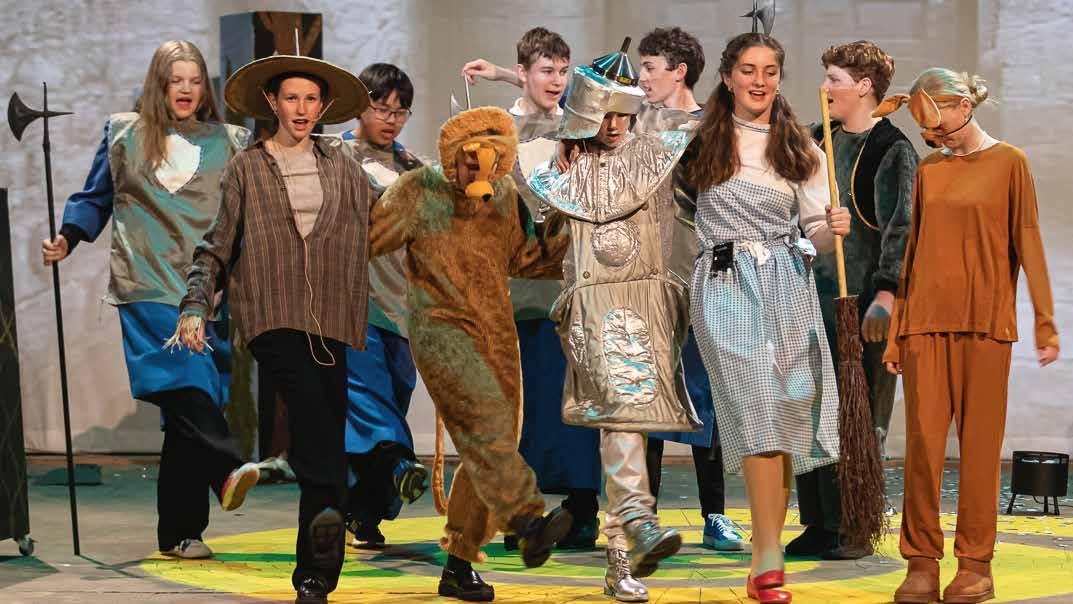



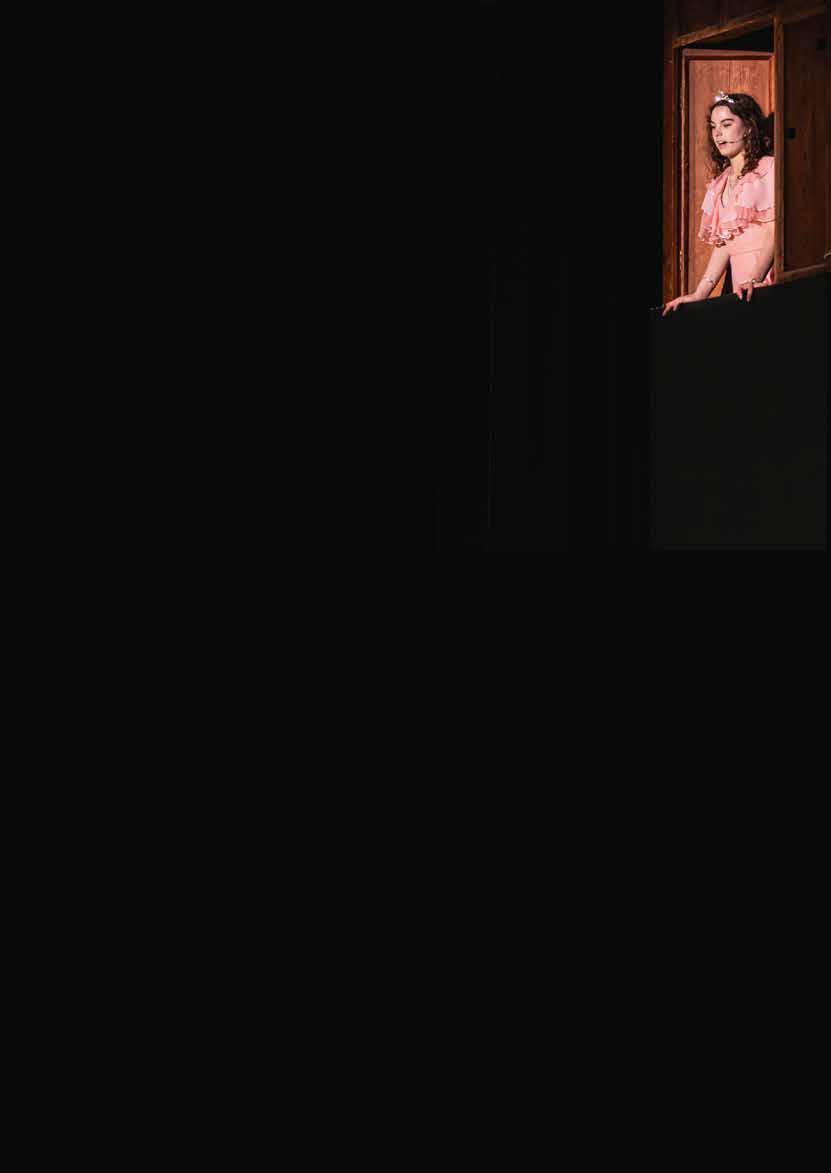

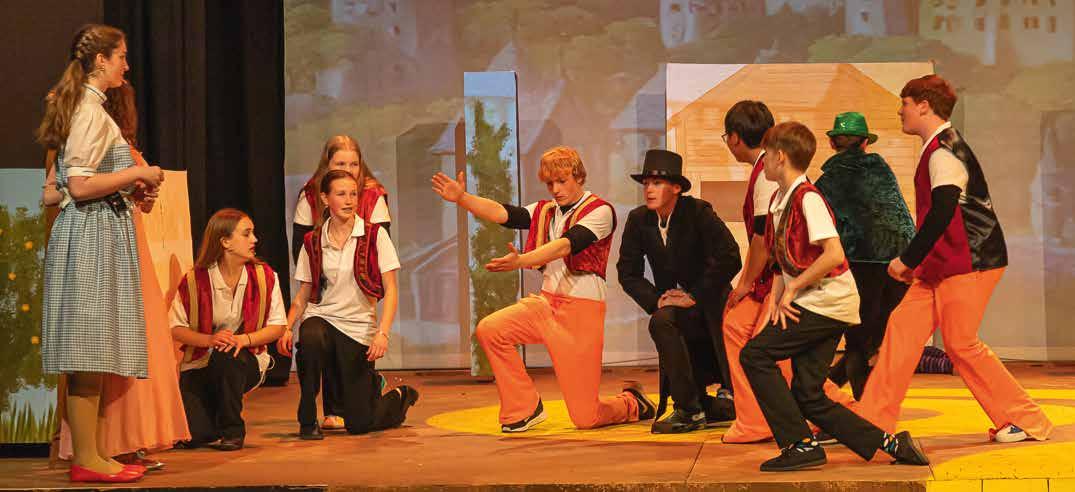

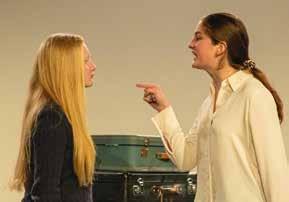


Amplefordians will quote the Rule of St Benedict with confidence, perhaps most commonly that “listen” is the first word of the Rule. Our life is meant to be, first of all, a listening life. That’s part of the reason why every student and member of staff at Ampleforth has the opportunity to make a day retreat, every year.
Fr Kevin recommends a beautiful book written by the Anglican priest Michael Mayne entitled: “This Sunrise of Wonder”. He wrote it as a gift to his grandchildren - wanting to share with them all that had inspired him in life, nature, relationships, literature, music and art. He did so in the hope that they might live with their eyes and ears and hearts open to the wonder and beauty waiting to be found in life.
Metropolitan Anthony Bloom, who many years ago gave a series of very popular talks on BBC radio, once told the story of an elderly lady who came to him asking his advice about prayer. She explained that for 14 years she had been praying ‘the Jesus
Prayer’ almost continually but it hadn’t worked. “If you’re doing all the talking”, he said, “you’re not giving God a chance to speak.”. “What will I do then?” she asked. He advised her to go to her room after breakfast, put it right, and then ‘light a little lamp before the ikon you have, and first of all take stock of your room. Just sit, look round and try to see where you live because I am sure it’s been a long time since you’ve really seen your room. And then take out your knitting and for fifteen minutes knit before the face of God, but I forbid you to say one word of prayer. You just knit, and try to enjoy the peace of your room.’ She didn’t think it was very pious advice, but she took it.
Later she came back to him, saying: ‘It works. After breakfast I got everything ready, made sure there was nothing that would worry me, and then I settled into my armchair and thought, “Oh how nice, I have fifteen minutes in which I can do nothing without feeling guilty!” And I looked around and for the first time in years I thought, “Oh, what a nice room I live in.”’ Then she said, ‘I felt so quiet
because the room was so peaceful. There was a clock ticking but it didn’t disturb the silence. It’s ticking just underlined the fact that everything was so still, and after a while I remembered that I must knit before the face of God, so I began to knit. And I became more and more aware of the silence. ‘The needles hit the armrest of my chair, the clock was ticking peacefully, there was nothing to bother about, I had no need of straining myself. Then I perceived that this silence was not simply an absence of noise, but that the silence had substance. It was not an absence of something but a presence of something. The silence had a density, a richness, and it began to pervade me. The silence around began to come and meet the silence in me. ‘All of a sudden I perceived that the silence was a presence. At the heart of the silence there was Him who is all stillness, all peace, all poise.’ She had found the way: “Be still and know that I am God.”
In our busy life, there is a danger that we can be distracted, in too much of a rush, too eager to move on to the next thing, too
anxious to achieve what we feel we need to achieve, to stop and appreciate the present and to taste its richness. We can glide past each other, not really encountering each other or seeing each other. We can do the same with nature, with God.
To make a retreat is to rediscover the important amidst the urgent; the gift of the people and the place around us; the Lord here with us.
This year, Year 7 and Year 8 travelled to St Gregory’s Minster to discover the beauty and history of the church and to be inspired by St Gregory and St Augustine.
“IN OUR BUSY LIFE, THERE IS A DANGER THAT WE CAN BE DISTRACTED, IN TOO MUCH OF A RUSH, TOO EAGER TO MOVE ON TO THE NEXT THING, TOO ANXIOUS TO ACHIEVE WHAT WE FEEL WE NEED TO ACHIEVE…”
Year 9 spent time in the Valley learning about our patron saints and each other.
Year 10 walked to Rievaulx Abbey and focused on deepening their understanding of St Aelred and spiritual friendship.
Year 11 travelled to Fountains Abbey and explored St Benedict’s chapter on humility.
Year 12 were inspired and encouraged by Old Amplefordians who came to share something of their own pilgrimage in their charity work and service. Year 13 spent the day at the peaceful Shrine of Our Lady of Mount Grace in Osmotherley, considering the Lord’s words “Who do you say I am?” as they looked to life beyond the Valley, with one student commenting

“My spiritual growth has made me most proud during my time here. I have found something that I will keep with me for the rest of my life, it has allowed me to become a better human being and friend and it has showed me that there is always more to live for and work towards.”
There is something very powerful about choosing to stop and to listen; that choice allows life to begin to reveal itself in its full depth and richness; it allows us a life lived with Christ.
By Gabrielle Foster, Lay Chaplain
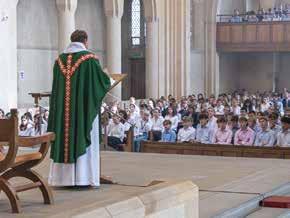

The play Waiting for Godot presents its audience with two tramps skulking about on stage. Nothing happens. They spend the time exchanging idle and apparently meaningless chatter. They can’t leave and end the monotony because they must wait for Godot. But Godot never arrives. The whole thing seems absurd. They just stand there. Waiting. At one point, one of them remarks: “Nothing happens. Nobody comes, nobody goes. It’s awful.” For many, that’s a fair description of the play.
Yet, the play presents a profound allegory of life; it suggests that for much of our lives, we might just be doing the same thing: walking around, waiting for something to happen.
In the second Act, there is a moment of brief action. Two other characters enter the stage: one of them is blind, the other seemingly mad. The blind man has fallen over and is crying out for help.
For a moment the two tramps stand and discuss what to do. They are frozen in inaction. One of them, suddenly feels the need to act:
“Let us not waste our time in idle discourse!
Let us do something while we have the chance!
To all mankind they were addressed, those cries for help still ringing in our ears! But at this place, at this moment of time, all mankind is us, whether we like it or not.
Let us make the most of it, before it is too late!”
It is the parable of the good Samaritan. How would we respond, when we pass someone wounded on the byway.
I don’t know about you, but whenever I heard that parable, I always thought well of course I would be the good Samaritan; but as I grow older, I realise I am the others too: at times, I am the Levite or the Priest that pass by on the other side of the road. Life is busy. We have our own commitments.
“The air is full of our cries.” Says one of the tramps, “But habit is a great deadener.”
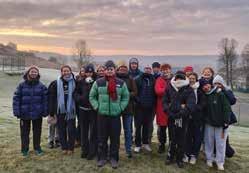

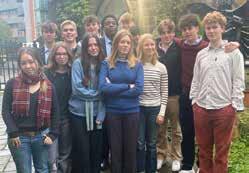
So why am I telling you about this?
Because I help run your student charity FACE-FAW, which is our way of fundraising for those in need and those who are suffering. The name FACE-FAW is an acronym, which means its letters stand for words. I want to focus on two of those words: F for Friendship and A for Aid.
The word “Friendship” expresses the motivation to respond to suffering, the word “Aid” the response, the action.
FACE-FAW is an invitation to all of you to respond to those cries for help. It is about what capacity you have in your heart to give, from time-to-time, to others: giving in terms of time, kind words, actions, your gifts and talents.
Already, so many of you have given.
On Friday, a group of Year 12 students ran 6 ½ miles and after half term, more Year 12 students will be sleeping out overnight in the cold, exposed to the elements, in solidarity with rough sleepers. Both activities are to raise money for two charities, St George’s Crypt and St Pio’s, working with and providing services for the homeless and the hungry in Leeds and Bradford.
In December, a whole host of students, who had been practising throughout the Autumn term, put on a fundraising rock concert and in March, Year 13 will be engaged in sponsored football for hours. Both events are in aid of the charity Mary’s Meals and in January, thanks to these efforts FACE-FAW donated over £13,000 to provide the food for the year at our sponsor school Chigwaja Primary, in Malawi. Thanks to their Double the Love campaign, this money has been matched by the charity’s other partners, and our donation will now go towards feeding an additional 705 children living in chronic poverty.
And there’s been much more: donations to foodbanks, activities in houses during advent to name a few. Thank you.
Next Wednesday, marks the beginning of Lent. I am inviting you all to think not
only about what you might give up, but also about what you can give of yourself in service to others.
We are halfway through the academic year. What else can we achieve together in the time we have left?
The suffering in the world can seem constant. Only last week we heard from OA Anthony Glaister who works with the charity ABCD Bethlehem providing care for disabled children in the Holy Land. He gave us an insight into some of the suffering taking place there. The war still rages on in Ukraine. Children still live in chronic poverty.
I don’t say this to make you feel guilty. You mustn’t and it’s not healthy. The problems are too vast for you as an individual to solve. But we can change our attitude to giving and to love. We have it in our hearts. And in those moments we might be changed too; as Magnus Macfarlane Barrow, founder of Mary’s Meals writes, we might find that “by practising charity more fully we will come to know ourselves more fully. We might discover along the way that it is not only the poor person over there that needs charity, but ourselves too. Within our very selves we may even discover famines - parts of us starved of love - or areas of darkness into which we have never before ventured… Our relationship with charity can be a key that opens previously locked rooms where our greatest treasures lie in wait -where gems such as joy, peace and a deeper sense of meaning and purpose glimmer in the dark.”
To return to that enigmatic play, Waiting for Godot, and the words of one of the tramps:
“Was I sleeping, while the others suffered? Am I sleeping now? Tomorrow, when I wake, or think I do, what shall I say of today?”
What will you say of today? What will you give tomorrow?
By Daniel Davison, Assistant Head of English
Ampleforth is a place that moulds students to become people that will serve God and the world. I have certainly been transformed by the holy experiences I have had the pleasure of encountering in the valley. For me it started at Gilling where, by year two we were expected to the Lord’s prayer and the Hail Mary off by heart. Even then, at that young age, it was made clear that Christ was not just someone that you talked to at mass once a week or even at morning and evening prayers every day, but someone that was with you for the rest of your life, and that he always loves you. Another guiding influence has been the Rule of St Benedict; within its guidelines, we become truly free and it helps us to focus on others, rather than ourselves.
Fr John (my confirmation sponsor and my first Chaplain) is someone I look up to as an example of living a life of service. Most of the faith that is instilled in me now and that I try to show today comes from the inspiring nature of his kindness and dedication to the Church and the children of Gilling. Something that I believe makes Ampleforth outstanding, through its unity with the monastery, is the connection that students gain from being in the presence of those who have spent most of their lives searching for God and for a deeper understanding of themselves. And so they are in a great place to help us as young people find our place in the world. All three Chaplains I have in the valley have been able to make me see faith in more than two dimensions and shown me that it is something that is lived, not visited, and that words without actions are merely tokens.
More recently, in our Sixth Form Chaplaincy periods, I have been invited to be more conscious of my actions once more. We have had time to both think about the meaning of our Benedictine values and to take actions to live them out too. One particular focus for our year was on the homeless. Some students visited a Franciscan priory in Bradford that provides a soup kitchen for
the poor; I chose to visit St George’s Crypt, somewhere that I had visited growing up and so I felt a personal connection to come back. We learnt about how the Crypt has been helping the homeless, the vulnerable and those suffering with addiction since 1930. In preparation for the trip, we were encouraged to reflect upon these words of Basil Hume, that “each person is unique, and so he or she has something special to show which no one else has. That is the reason why each person whom I meet has a claim on my respect... Perhaps we can see more clearly what I am trying to say if we think about seeing Christ in other people.” This was something we all experienced powerfully when meeting the residents themselves and hearing their stories, the dark places they had been to, the painful experiences – addiction, rejection, neglect – and the hope that they were now living and the love that was transforming their lives. Meeting these homeless people obliterated any pre-conceived or imagined stereotypes of rough sleepers: their stories and their experiences commanded respect and instilled in us a sense of wanting to take some further action to show our solidarity and support.
In February, 15 of us took part in a sleepout to raise money for the Crypt and St Pio’s soup kitchen. This was motivated in part to raise money, but also as a show of solidarity for those sleeping rough. It was a cold night, with temperatures dropping below zero, but we had been well-prepared, equipped with layers and warm sleeping bags, sleeping under the shelter of a balcony and with the protective tarpaulins and wind-breaks, as well as the comforting knowledge that tomorrow, we would be back into our own beds. Rough sleepers don’t have such luxuries and are constantly at the mercy of the elements, often caught in the rain and sleeping in dangerously damp and wet conditions. The experience allowed us imaginative space to consider what it would be like to do this every night and consider the long-term impacts this could have on both physical and mental health. And each
of us were able to remember the stories and faces of those we had met for whom this was a lived reality.
One of the things that our Chaplaincy sessions have led me to consider is how we can integrate service into our way of living. This motivated me to train for the Leeds half marathon, which I completed in May. It was the first time I had ever run the distance. While it was tough, I was spurred on by the encounters in the Crypt having seen firsthand the fantastic work they do in Leeds supporting the homeless. As our year group has begun to assume the responsibilities of school monitors, it is also the driving force behind our ambitions for implementing positive change, inspired by our values. This term, for example, we have taken action based on the value of Stewardship, leading a campaign to reduce energy wastage in the school and to recycle secondhand clothing.
Unlike in the younger years at Gilling where I said the prayers because it was the way that my parents wanted me to live, now I say those same prayers not because someone else wants me to but because I do: I want to glorify God in the way that I live my life. I think this is something that next year’s monitor team share: we want to help promote positive change through the example of our service.
By Finbar Flannery (DO) Year 12









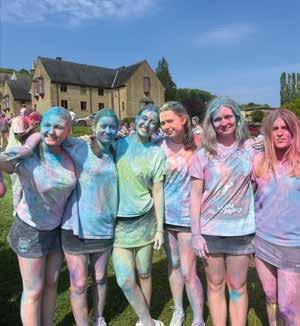



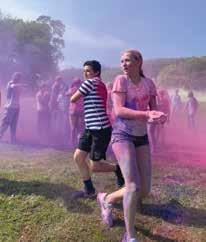

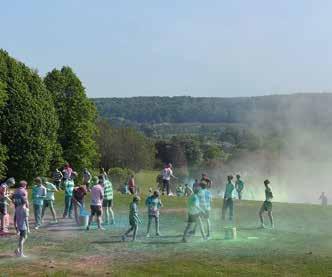



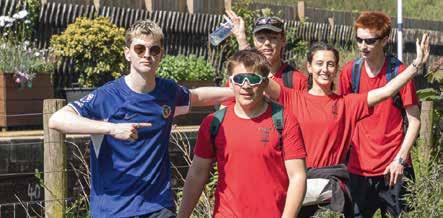
When I was approached to write about my experience of the Ampleforth College Big Walk, I was hesitant; I was worried that I would miscommunicate the meaning and purpose of this marvellous event our school facilitates for us every year. The goal of this walk holds much tradition and meaning for any Ampleforth College student, as I believe we are doing it for something, and someone, much bigger than ourselves.

Every year a group of Year 12 students and staff walk 78km from Whitby Abbey to Ampleforth to raise funds for the ‘Friendship Project’, a scheme to provide shared experiences with students from Oakfield School in Nottingham, a school for children with disabilities and learning needs. We get involved in this to understand the physical and mental pain that an able-bodied world may cause to anyone born with mental or physical disabilities. By putting ourselves in their shoes for even a second, we hope to grow in empathy and kindness for everyone around us. We undertake this walk to get alongside the Oakfield students and serve them, just as Christ showed us.
Even though it was a daunting task, I believe there was a spirit of togetherness and pride in each person completing this walk, and slowly, by working through the task at hand, we begun to dispel the fear, and instead embraced each other, learning and gleaning knowledge and understanding from this experience.
Saturday morning, 18 May 2024,10:30AM: Our group buzzed with a mixture of excitement and anxiety for the task to come. Feet were strapped to white, and hair was braided back tightly. We were ready. Hopping onto the bus we drove to Whitby. The ride was full of music and laughter as we nervously waited for what was to come. Next, we had the privilege of Mass with Fr Henry in the unique St Mary’s church next to Whitby Abbey, in which he shared a kind word of encouragement and the importance of selflessness in this walk. His words struck a
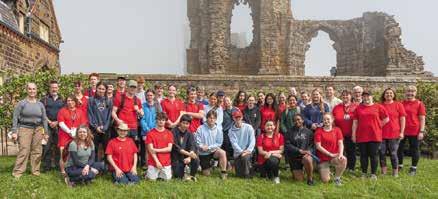
chord in my heart as I began to realise how important it was that we did this walk for the right reasons. And then we were off.
Leading the group, Dr Anglim wove through the bustling streets of Whitby, alongside the river and up through the moors. Quickly, day turned to night, sun turned to cloud, and we were freezing. Trudging along the moors, soaked and cold, we continued. The early morning sunrise sprung from the clouds, and the group’s energy never faltered. Soon we stumbled down to Duncombe Park in Helmsley for a warm sausage bun, in which we basked in the 10am sun. After filling up with breakfast we persevered for the last 7 miles, being wonderfully welcomed back home to our school by a lone piper, greeted by our friends, families and staff. Smiles and tears encompassed everyone, and we shone with pride, as we had just finished one of the hardest things we had ever done.
The Big Walk hangs under an umbrella of activities and events students at Ampleforth organise to fundraise for Oakfield School. This year we also organised a Friendship Ball, and sold pizzas, Christmas cards, and sweets for Valentine’s Day. All four activities were great fun and contributed to raising the money for the benefit of the Oakfield students. This week we visited Nottingham for three days to work with the children and experience the fruits of our labour.
Seeing the children and working with them really brought to light how lucky we are for this opportunity to meet new and different people. We got to learn simple Makaton, a form of sign language used mostly by people with disabilities, autism or different communication needs. It was a small feat to learn how to communicate with these children, especially those who were completely nonverbal or quadriplegic, and I’m sure it was a first for most of us. Another challenge we had to take on, was fully understanding their responses. I hadn’t anticipated how they were going to communicate back to us, it was such a simple thing that I kicked myself later for not thinking about. How am I to have a basic conversation with someone who communicates in a way I don’t understand at all? One system we discovered was to ask yes/no questions and ask them to tap yes or no on the sides of their wheelchairs. We used communication sheets, signing, and even just body language.
One of my favourite moments was laughing with Hampshire (an Oakfield student) because she had told me to run after the geese by a pond. However, the geese turned around and hissed back at me, so I turned and fled leaving my audience in hysterics at my lack of bravery. All the children we worked alongside had brilliant senses of humour, and always found a reason to giggle. Another highlight was seeing how wonderfully kind they all were. They lead by example, showing compassion and empathy for everyone, always checking in on each other. Bethany, one of the Oakfield students, made sure I had a cup of juice too, motioning that one was hers and one was for me. When we played a football match, a boy got upset and went to stand on the side; his friend quickly responded by going to encourage him back.
Spending time with these fantastic children was one of the best experiences I’ve had during my time at Ampleforth. I have learnt more about patience, courage, determination, overcoming challenges, and prejudice. I have learnt how much we communicate without words, and how small gestures can say so much. I am more aware of appreciating the simple things in life, noticing things to enjoy, and valuing my relationships with people. I am enormously grateful for the opportunity to spend time getting to know the students at Oakfield school and for how much they have taught me.
By Amber Rego (B), Year 12
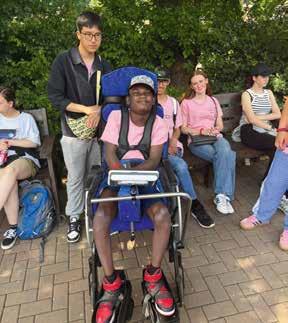

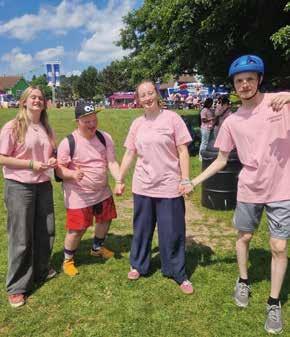
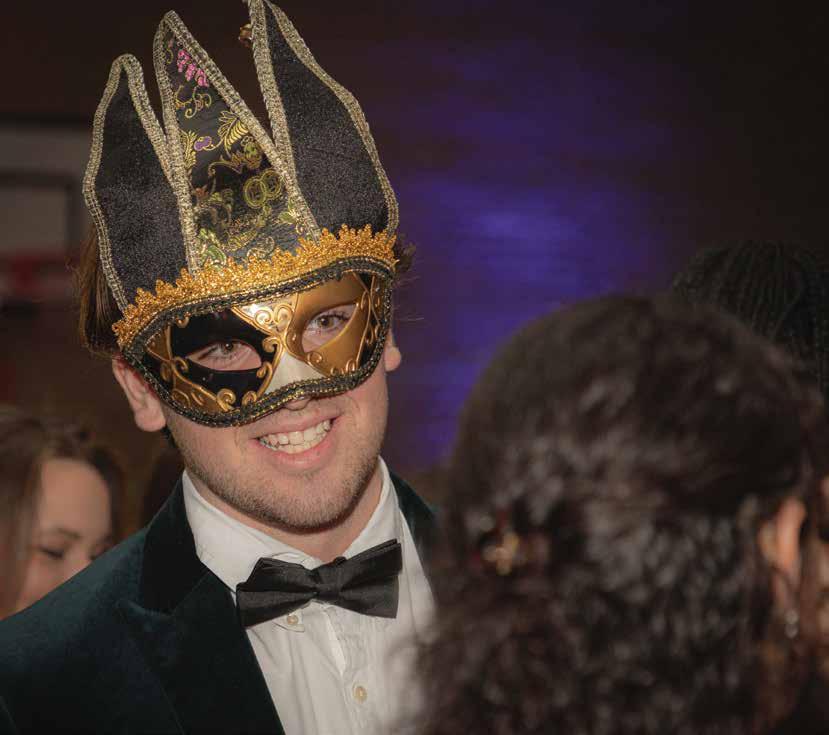

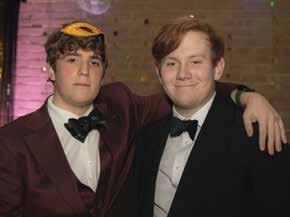



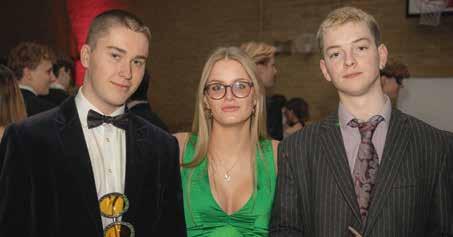

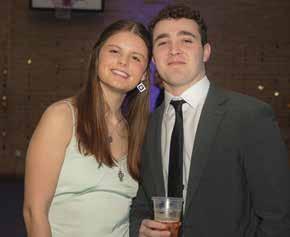
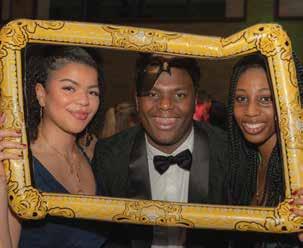

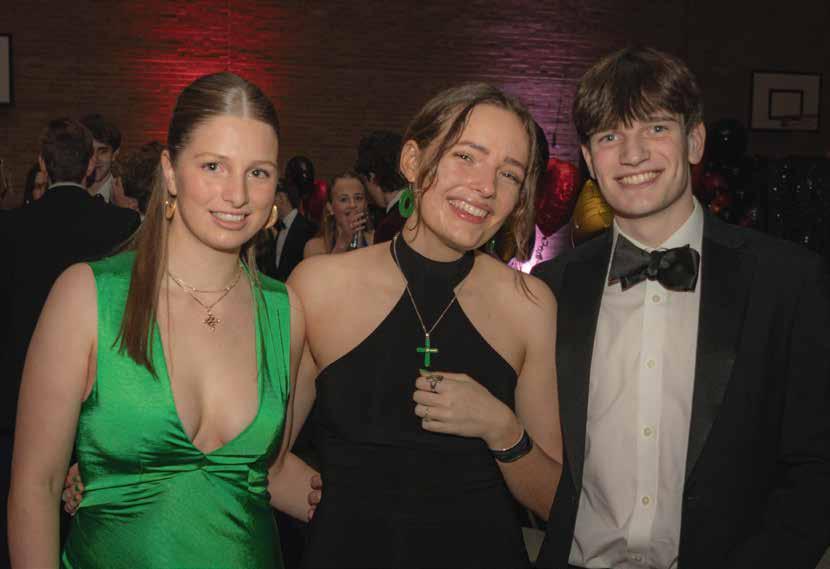
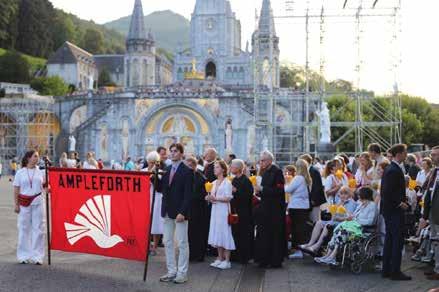


In July last year, a group of Year 13 students journeyed to Lourdes to take part in the annual Ampleforth pilgrimage. We stayed there for a little over a week, forming bonds with the assisted pilgrims and experiencing the lifestyle of prayer and service.
Anyone who went will be in agreement when I say this was a truly life-changing, amazing experience. Aspects of our visit included keeping the pilgrims company and serving them during mealtimes, as well as simply spending time getting to know them. This was rewarding on so many levels. Firstly, it was palpable when talking to the assisted pilgrims that many of them treasured the time spent in Lourdes very dearly and looked forward to it year-round. The appreciation from all there was overwhelming, the atmosphere throughout the town is filled with love and compassion, as well as sheer pleasure to be part of such a dedicated and genuine community.

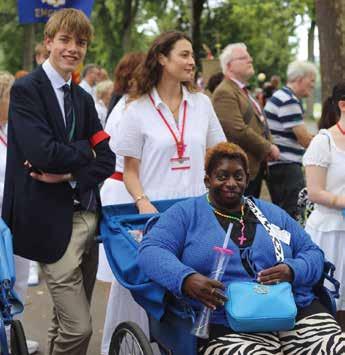





As well as experiencing how much our company meant to the pilgrims, we were also lucky to make so many friends. Learning how to communicate with people who we may not have spoken to ordinarily was a vital lesson. I learnt that there is friendship in people who can often be simply overlooked, and that every individual has their own language, which we should take the time to learn and respect.
I was also really taken aback with how supportive the environment was. Being able to experience things such as international mass, a pilgrimage to an outdoor church where we were blessed to witness intimately the anointing of the sick, and group singing alongside like-minded people, friends and family, was something I will never forget. I discovered aspects of myself and my faith which I had not known before, and gained a new perspective on subjects I knew little about. To anyone considering attending the pilgrimage in future years, I can do nothing except encourage you wholeheartedly.
By Josephine Blake-James (M), Year 13
When my wife Jojo and I visited the city of Poltava in eastern Ukraine last April, we went to Mass in a small parish. After Mass we heard a talk by a Ukrainian monk who had lived for six months under Russian occupation in the south of the country, near Kherson. He witnessed ill-treatment of civilians by Russian soldiers, the deliberate restriction of food supplies, and the constant fear of being reported as a spy. He and his parishioners were terrified by what they heard of the massacre of civilians elsewhere in Ukraine, in the town of Bucha. To his surprise, four Russian soldiers used to come to his church to pray. He explained the difficulty he had in dealing with the hatred he found in his heart towards these men. It is inevitable, he said, that such hatred will develop when you have witnessed your enemy doing bad things to people you love.
He was saying this, don’t forget, to a congregation of Ukrainians, all of whom had fathers, sons, cousins, friends who were caught up in the war, some of whom had already been killed. All of his congregation would share his fear and be near to hatred of these people who wanted to destroy their nation. How can we deal with this growing hatred, he asked? Through forgiveness, he said, by praying for this ten times every day. But not praying to forgive your enemy. No. When we are tempted to hate another, he said, we should pray again and again – ‘Father, forgive me.’
What I understood in this was a powerful, powerful message. What must be my first contribution to peace in Ukraine, in Israel and Palestine and those many other places of conflict in the world? It must be this prayer to resist hatred in my own heart, by looking to that in me which refuses to ‘love my enemy’ as Jesus so clearly commanded.
The writer GK Chesterton once contributed to a correspondence in The Times, where people were discussing the growing nationalism and arms race in the years before WWI. ‘What is wrong with the world?’ they were asking. Chesterton wrote a brief letter: ‘Dear Sir, I am. Yours sincerely GK Chesteron’.
So, when I read about the terrible, terrible tragedy of hatred and savagery, of indiscriminate killing – and worse than killing – of old people, pregnant women, partying teenagers, babies – crimes which have reached a crescendo in the last nine days, but which, along with countless lesser inflictions of suffering and oppression, have been occurring, often barely reported, over the past years and decades; when I read about these, I must look first into my own heart. And then, I must ask God – the God of Abraham, the God of the Prophet Mohammed, the God of us Christians – to inspire similar self-reflection in all of those caught up in the struggle between Jews and Arabs in Palestine and Israel.
What a ridiculous thing to ask! To ask for a spirit of repentance and forgiveness, in the face of this 75 year-old conflict and the hundreds of thousands, millions of individual experiences of brutality, humiliation and injustice. But ask we must, and ask in Hope, as Fr Richard explained in his homily on Sunday. And we must ask too for God’s comfort and support for those who have already fallen victim to the fighting. But we must not forget also, as urged by the Ukrainian monk, to ask for forgiveness for our own harbouring of resentment and anger, so that - and this sounds like a cliché but is true - one step towards peace in the world may begin in our own hearts.
By Richard Hudson, Head of Year 12 & Teacher of Christian Theology
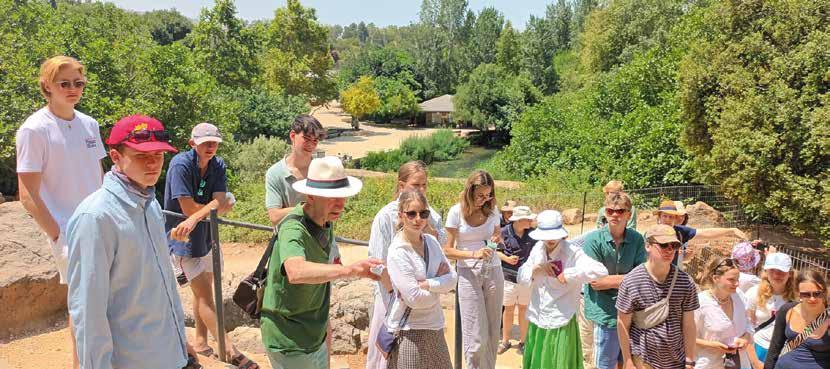
The most striking event of the Holy Land trip for me was the visit to the Western Wall in the famous city of Jerusalem. The walk to the city at night across the Kedron valley, past the Garden and Church of Gethsemane on the Mount of Olives, whilst being in and amongst hundreds of Orthodox Jews mourning the death of a great Rabbi was certainly a baptism by fire for a group of plucky Amplefordians. This being said, we believed that it was valuable for us to experience the life and soul of Jerusalem now, rather than just exploring the Jerusalem of twothousand years ago. The approach to the famous Wall was somewhat anti-climactic; a walk through a narrow street, a barrier, and then you’re there. We were greeted with the sight of hundreds of people joined in prayer.
The Jewish people being the older brother of our faith, it was important for us to ponder on the idea that we could take lessons in prayer from this holy sight. The scene of the Wall was magnificent, but in the foreground was a picture of hundreds of individuals praying their intentions whilst simultaneously united under a sensational communal space of worship. The physical aspect of the Wall is complimented by the ever-physical Jewish style of prayer; the striking full body experience added a perspective to our prayer that we can bring back to school and Houses.
On the final morning of our time in the Holy Land, we visited Fr Henry’s favourite shop in Israel, the olive wood shop in Bethlehem run by the very hospitable Jack Jacamo. Jack was warm and amicable from the moment he strode out from his shop to greet us. He welcomed us into the workspaces in the backrooms of his shop -this was valuable for us as it opened our eyes for the first time on the trip - real Palestinians, who are written about so often in the news, working on their select craft that date back to previous generations.




What was so striking about our time in Jack’s shop was the not only the unwavering hospitality, but more the ever-prevalent issues highlighted by Jack and his daughter. Jack spoke eloquently about the struggles he and his family faced during the conflict and subsequent restrictions placed on Palestinians living in the West Bank. He outlined certain issues such as restricted healthcare and restricted travel. Jack’s daughter was helping in the shop, and we were sad to hear that she had suffered from Leukaemia at a young age. Due to the healthcare restrictions that had been imposed upon Palestinians by the Israeli Government, it was very hard to seek adequate healthcare for his suffering daughter. Despite her eventually finding the appropriate care needed, this anecdote highlighted the extremities the conflict can reach.
The most moving part of our trip for me was the service of the Adoration of the Blessed Sacrament at the Church of Gethsemane on our final night in Jerusalem. This service was not on our itinerary, it was brought to our attention by one of the ever-amicable French nuns at the Maison d’Abraham; we thought this gave the service added meaning due to the feeling that we were invited to prayer in a magnificent church, the same place where Jesus invited his disciples to pray with him. With wise instruction and guidance from Fr Ambrose regarding our attitudes towards the service, we set off in the busy, bustling streets of the Mount of Olives.
The service gave us a golden time to reflect (not the golden time in John 12:23, albeit in the same place) on a week full of sensation, whether that be spiritual, political, individual, or communal. It was moving to be in and amongst fellow pilgrims, united in prayer, all against the backdrop of a unique city.
The Holy Land trip of 2023 was one of faith, and politics, harmony, and divide. While we may revel in the glistening history of the risen Christ who resided in the Holy Land, it was an important question to ask ourselves, how do we apply what we saw every day in Israel to our every day at home and school? With the saga in Jenin where nine Palestinians were killed on the Monday of our trip, we must challenge ourselves to use the principles that Christ sewed in the heart of the Holy Land.
By Patrick Adams (H), Year 13
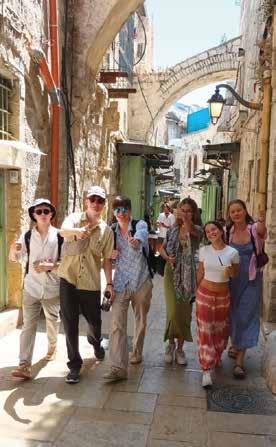
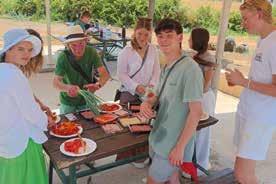

The Big Hoof have just completed a 205 mile trek the whole way across Scotland - and more: from St Andrews to the island of Iona! Along the way, over 40 people and six horses joined. The group have so far raised over £6,700 for Venture Trust, an outdoor mental health charity. The route celebrated the most wild and beautiful parts of Scotland, using the ancient trail of St Columba as their guide.
The Big Hoof is a charity that promotes adventure and wellbeing through the power of the horse. Previous to this ride across Scotland, they have journeyed from John O’Groats to Land’s End (2020), raising over £36,000 for the Cystic Fibrosis Trust and from Siena, Italy to Cape Finsiterre, Spain in 2022 (,2800km in 110 days), raising £24,000 for Ukrainian refugees and outsider artists. They have also ridden for the Turquoise Mountain Foundation, raising £3,500 in support of Afghan women and children.

In total, The Big Hoof have now raised over £80,000 for causes surrounding mental health, wellbeing and welfare and have travelled over 4,800 km in five different countries. Going forward, the charity aims to continue to use the ancient trails of Scotland to bring strangers together, from all walks of life, in order to explore the outdoors, raise money for local causes, and create a positive, connected and sustainable adventure.
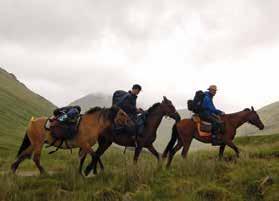
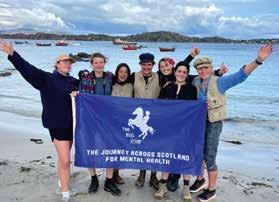
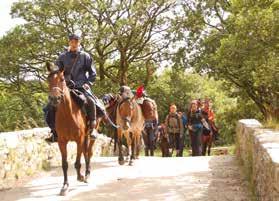

Two weekends ago, many of you were travelling between Ampleforth and your homes. For some of you this would have involved many hours of travel by plane, train and taxi, especially if you are an international student. Today of course, we have travel apps where we can monitor our flights, and even see where our friends are around the world from their phone data.
However, it was not always so easy for past generations of Amplefordians.
Spare a thought for the Orendain brothers – Rafael, Tomas and Ernesto. Their journey to Ampleforth in 1908 began in Guadalajara in Western Mexico. We don’t know every step of the Orendain brothers’ journey, but they had to travel from Guadalajara to the Atlantic Coast, and then undertake a five-day steamship crossing. I wonder what thoughts were going through the boys’ heads on those long days at sea, and what kind of weather they experienced.
Arrival in Britain would have been in one of the great port cities of London, Liverpool or Glasgow. That must have been an extraordinary culture shock, and although all the world’s languages were spoken in these ports, it must have been a daunting experience, as the youngest brother was only 11. I wonder how the boys found their train connections and how much luggage they were carrying. They must have been exhausted by the time they finally reached the valley.
The Orendain brothers made a big impact on Ampleforth, especially in sport. The Ampleforth Journal tells us that in the 1911 House Athletics, Ernesto came second in the shot-putt and his younger brother Tomas came second in the long jump. That the
Orendain boys made such an impact on sport holds a clue to their later achievements.
By 1916 the brothers were back home in Guadalajara, having survived the increasingly dangerous Atlantic crossing during the First World War. The previous year the Lusitania had been torpedoed off the Irish coast at the cost of more than 1,000 lives. Studying at Ampleforth must have done something to foster the boys’ love of sport as on 15 August 1916 they got together in a café with five other friends to set up a football club, Atlas FC. From such small beginnings, Atlas FC is now one of Mexico’s largest clubs, boasting a 56,000 seat stadium, the Estadio Jalisco. Their nickname, “The Rojinegros” – is a tribute to their red and black home strip. Clearly the Ampleforth influence lives on.
The Orendain brothers weren’t the first international students to study at Ampleforth, but their journey was perhaps the longest before the age of air travel. Today, more than a century on, we are deeply proud of the international diversity of our community Around 30% of our students today have international origins, from 36 countries. Diversity is a strength in itself, and we are a culturally and educationally richer community for everything that every Amplefordian brings to the valley, wherever they are from.
And what about the Orendain brothers? In July 2023 Alex Orendain visited the College. She was delighted to see where her great grandfather had lived and studied, and had developed his love of sport. I hope that all of you find your passion here, and take that passion back to wherever your home is.
By Alastair Dunn, Teacher of History
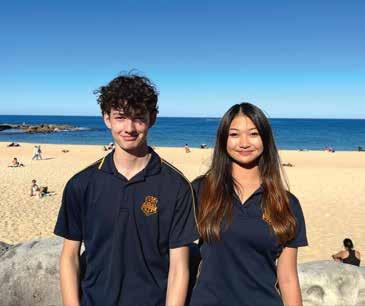
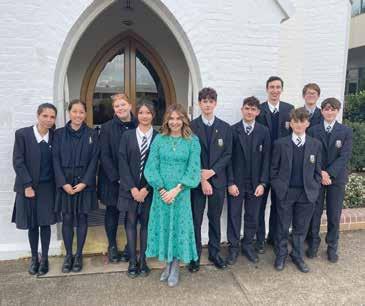
Georgia Bellaro, Year 12, St Bede’s - hosted by Anastasia Wu
Jett Mierisch Year 12, St Dunstan’s & Oswald’s - hosted by Elliot James
Ampleforth College has a Benedictine exchange programme with Rosebank College, a Catholic co-educational school in Sydney, Australia. Students from both schools spend time in each other’s country, getting to know local life with Benedictine values! The aim is to promote international understanding and cultural exchange between students.
Last summer I was lucky enough to visit Sydney as part of this programme along with fellow Amplefordian, Elliot James. While in Australia, I noticed some differences and similarities between the two countries. Rosebank offers a wider range of vocational studies which involve students doing work experience while they are at school and lead directly into employment after senior school. The school has a very relaxed environment, with friendly interaction and open communication between students and teachers. While I am used to more traditional British food at Ampleforth, Australian cuisine is more diverse. I really liked Australian Vegemite and preferred it to Marmite! Sydney is beautiful and great for outdoor activities; I particularly enjoyed an excursion to the beach.

Hosting students from Rosebank College has been equally rewarding. Their arrival brought us new energy and a new perspective on our daily lives. We were interested in learning about their culture, school life and special traditions. They easily integrated into our community and shared their experiences. We became good friends and had many memorable moments, from Saturday socials to the trip to York, which helped us get to know each other better. At the same time, their visit not only deepened our understanding of the world, but also strengthened the bonds between our schools, which we hope to foster further in the future.
Overall, the exchange programme with Rosebank College was a rewarding and memorable experience for all of us. It exposed me to different lifestyles and educational approaches, which helped my growth and cross-cultural understanding. I learned the importance of adapting and embracing new experiences. I realised that despite our differences, there is much in common that unites us. This realisation made me more open and appreciative of cultural diversity.
By Anastasia Wu (B), Year 12

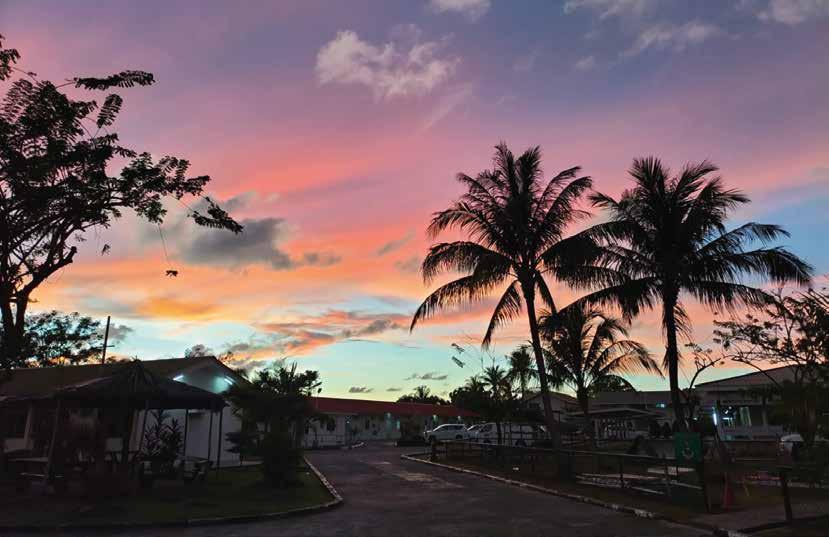
“Be very aware of the scorpions, snakes and spiders. Don’t go near them! If there is a lovely colourful spider, do not go and try to touch it”. As Lt Colonel Blackford said these words with a wide grin, looking around the classroom, I glanced at my 20 comrades all of whom had turned a little green, unless of course it was just the reflection of the jungle showing on the screen. Although we had been reassured and encouraged by all the staff prior to the trip, a tangible, nervous, unbearable feeling of excitement (more likely fear) infiltrated our group.
This year, on the trip of a lifetime, the Ampleforth College CCF and Stamford Welland Academy Cadets had gone together to train with the Royal Gurkha Rifles out
in Seria Town, in Brunei. Ampleforth has made three previous trips to Borneo, but this was the first time more than two girls had ventured out to the jungle. The opportunities presented to us were absolutely incredible, and I think it’s safe to say we would all go back if we could. We got to learn firsthand from some of the British Army’s best: the Gurkhas. The Gurkhas are Nepalese warriors who have been fighting in the British Army since 1815. We have a particularly strong connection to that Battalion because Lt Colonel Blackford was second in command of the military base we visited in Brunei. Going back and seeing where he used to work was such an honour.
Along with firing live rounds on a 25-metre range, learning jungle survival skills and
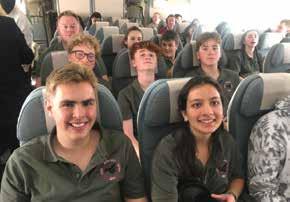
Nepalese, and playing volleyball with some of the world’s best fighters, we all came back extremely grateful and humbled to have had that experience.
A to B, Ampleforth to Borneo. Two of the most special and memorable moments happened even before we had left the UK. The night before the big trip, a handful of us went to Compline with the Ampleforth Abbey monks. Being sent off with Fr Chad’s kind blessing seemed to help ease the nerves. That day we had two section competitions, between 1 Section and 2 Section. The sections were made up of half Amplefordians and half from the Stamford Welland. This day helped us integrate and start building friendships. Setting out the next day, we

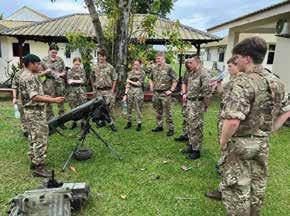

“ONE OF THE BEST THINGS, IF NOT THE BEST, WAS HAVING THE CHANCE TO LISTEN AND LEARN FROM THESE EXPERIENCED AND SMART SOLDIERS.”
had a boy with us who had never been on a flight before, some who had never been out the country. As we stepped off the plane and out of the airport in Bandar Seri Begawan (the capital), warm air enveloped us, the sticky sweet humidity created an exciting environment for us to start our journey.
The first week we spent acclimatising to the hot surroundings, while getting to play football and learn more about Nepalese Gurkha culture. We visited a beautiful Hindu temple where every year a buffalo is sacrificed as an offering to the gods. Four men hold it down, and one tries to cut its head off in one strike. If this is done in one strike, that is good luck and fortune for the Battalion that year, however if the Buffalo isn’t decapitated with one strike, the Battalion suffers bad luck that year. We looked in on BFBS (British Forces Broadcasting Services) and learnt how they communicate news to the Armed Forces via radio. We also had the opportunity to practice in the DCCT (Dismounted Close Combat Trainers), which is a virtual shooting range using electronic signals and real rifles to develop shooting skills. Some of the Gurkhas, especially snipers, would go in and
practise by changing the weather conditions and visibility to better their expertise. This week of training really helped us to prepare for spending five days in the jungle.
Those five days were the most exciting, as we got to learn firsthand from the Royal Gurkhas in an environment they knew like the back of their hand. We all had to improve our discipline and courage in order to survive, and even thrive in the jungle. As Mr Steele liked to say: “Out there, if you don’t sort your admin properly, not even God will save you”. Certain things such as tapping out your boots in the morning to make sure there were no scorpions, snakes or spiders inside them. Or even checking for deadfall before putting up your hammock, and making sure to tie your mosquito net, not too high otherwise mozzies will slip in under. Some of the best jungle lessons we learnt were purely survival skills, for example how to build a strong, durable long-term shelter, that will properly protect you from anything. We learned how to weave strong hammocks out of a certain type of jungle vine, so you are away from any creepy crawlies on the floor.
One of my personal favourite lessons was how to get water that is safe without puri tabs (purification tablets). From drinking from banana leaves, to vines, to even making your own filtration system with your kit - learning these skills was absolutely fascinating! Another crowd pleaser of a jungle survival lesson was hunting and laying traps for things such as jungle birds, wild boars and monkeys. We witnessed firsthand how to butcher a jungle ‘chicken’, without it making much noise to attract the enemy. Then we ate it for lunch along with local indigenous fruits and


insects. On the final day, after a long hard night in the jungle, we were up at 5am to prepare for a Platoon Attack. This attack in the thick, dense undergrowth was one of the most exhilarating things I personally have ever experienced. This was of course training, so some fantastic Gurkhas let us infiltrate their ‘camp’ and take hold of their location. We had many Gurkha instructors giving brilliant advice.
I think it’s safe to say one of the best things, if not the best, was having the chance to listen and learn from these experienced and smart soldiers; and hearing the stories of them trying to get into the British Army. For a regular Nepalese boy, there are 200 places in the Army every year and around 25,000 applicants. We heard about one Gurkha who nearly lost his leg to a Wild Cape Buffalo in Nakuru, Kenya. Hearing and seeing some of them with scars they had acquired from the Jungle Warfare Instructors course, was fascinating for all of us. After thanking the Gurkhas for all the time and energy they had put into our course, we headed off to Mulu National Park in Malaysia to explore the caves, and rest and recuperate, after such a life changing trip.
Going to Borneo, specifically Brunei and Mulu was one of the best trips of my life; without fail it tested us all in different ways, but I am confident that everyone is glad to have had the experience. Learning and listening about a different way of life was so interesting and it was a brilliant opportunity. I would recommend it to all future Ampleforth cadets!
By Amber Rego (B) Year 12

The school’s ski strip to Austria was a fantastic opportunity for me to improve my skiing whilst creating memories with my friends. The instructors were there every step of the way to teach me the basics and help me improve on my skills as the slopes got progressively harder. The full days on the slopes wouldn’t have been the same if it wasn’t for the wide variety of food and the rewarding meal at the end of the day back at the resort. In our free time, there were organised activities and things to do in the resort which gave us a great chance to socialise and have fun with friends and relax at the end of a tiring day. The trip was more than worth the long bus journey; a wonderful experience and I would love to go again.
By Evie Minchella (B), Year 12


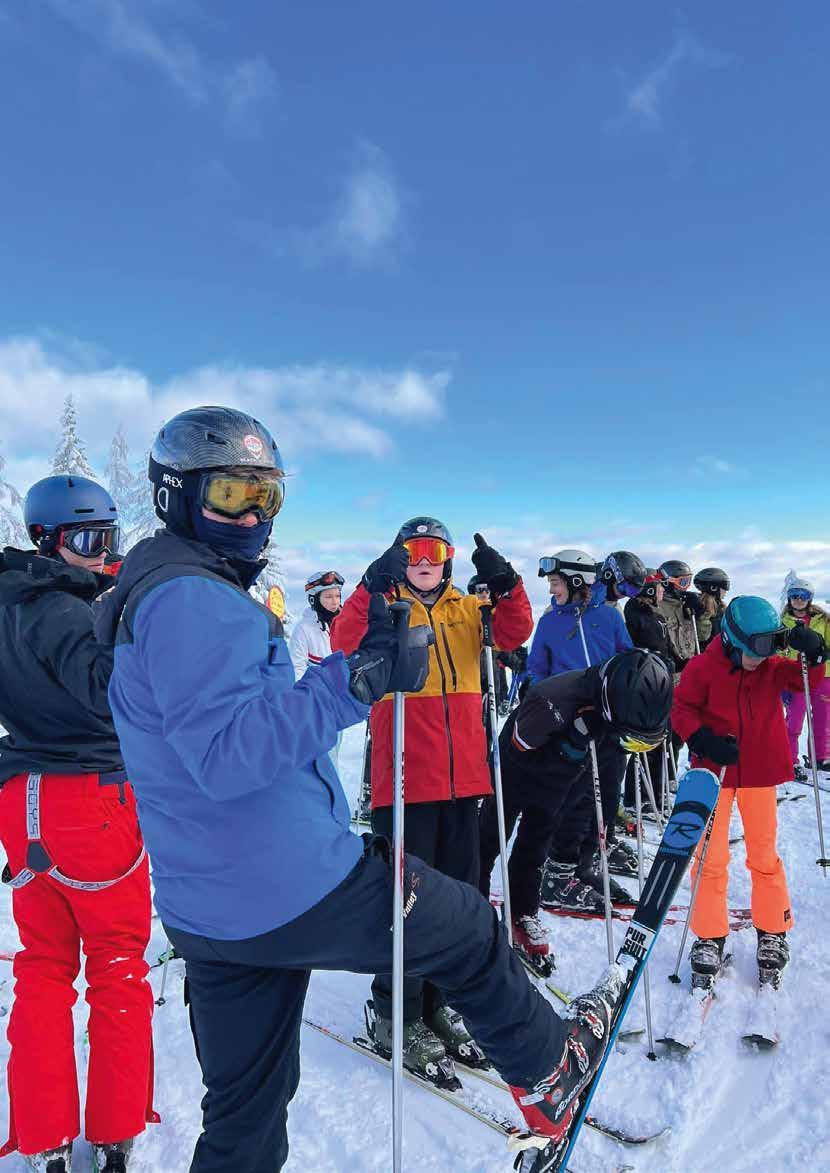
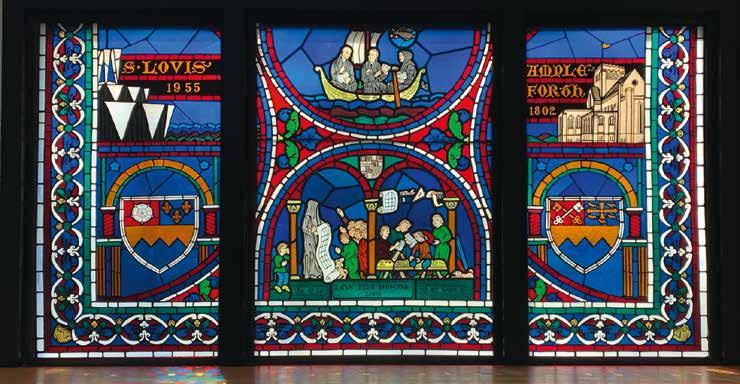
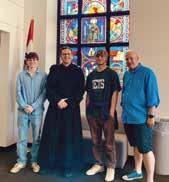
During the half term holidays, I went to America with my family. During this trip we visited St Louis Abbey in Missouri. St Louis Abbey was founded in 1955 by three Amplefordian monks, led by Fr Colomba, who aimed to establish a new community to address the post-World War II growth of Catholic education in the United States. As we arrived, we immediately spotted a lookalike flag of the Ampleforth crest. It had the same colours and same design, however looking closer we saw that on the left side instead of the two keys it was the white Yorkshire rose and, on the right, instead of the martlets, was the royal arms of France.
One of the defining features was the distinctive Abbey church designed by the renowned architect Gyo Obata and consecrated in 1962. ‘The church’s circular façade consists of three tiers of whitewashed, thin poured concrete parabolic arches, the top tier forming a belltower; the arches appear to float upwards from their grassy base. They are faced with dark, insulated fibreglass-polyester window-walls, which create a meditative translucency when viewed from within.’ The Abbey boasts a 14th century sculpture of Our Lady, a 17th century holy water font and a “tracker action” pipe-organ built and shipped over from Vienna, one of only 12 designed by Gregor Hradetzky in the USA.
Explaining that we were visitors from Ampleforth, we then visited the St Louis Priory School, adjacent to the Abbey. This triggered an excited and very hospitable welcome from Fr Cuthbert Elliott OSB, Headmaster, and Lise Riet-Lague, Assistant Head. They showed us the wonderful stained-glass window explaining the history of the Abbey, pointing out a section showing St Louis 1955 and Ampleforth 1802. After describing our links with Ampleforth from the three generations of OAs in our family, Swinton Thomas (C50), Dominic Thomas (O90) and Luke Thomas (C23), Fr Cuthbert ushered us into his office. Immediately we knew why as we spotted Robert
‘Mouseman’ Thompson circular table and chairs, brought over from Yorkshire as a gift. It felt just like the library back at school.
Ms Riet-Lague insisted on taking us on a tour of the school and grounds, which we were delighted about. St Louis Priory school is an all-boys school from ages 13-18, with around 400 pupils working towards academic and sporting excellence, as seen by their alumni achievements. Much like at Ampleforth, they had a vast number of pitches and grounds to explore, however, unlike Ampleforth, they had golf buggies to get around! Everything was immaculate as we walked down to where boys were playing a variety of sports including tennis, baseball, and lacrosse culminating in an amazing track and American football pitch. This had a giant LED scoreboard which was also able to show replays of the game as it happens, as well as heated spectator seats - imagine that on the Dallaglio Match Ground! One of the two indoor sports halls is so large that it has a raised balcony corridor specifically designed to run as an indoor track. They are even thinking of putting in simulated golf rooms instead of squash courts - something for SAC to think about.
As we visited all these places and watched the boys play their sports, we were introduced to some of the pupils. They were incredibly polite, charming and all were excited to learn that we came from Ampleforth and had heard of it. I hope their students will come over to the Valley and be greeted with the same hospitality. St Louis is a place many Old Amplefordians should visit.
By Sam Thomas (CT), Year 13

I decided to spend my gap year working and living within the Manquehue movement in Chile when my original plan for university fell through. Suddenly, I had a free year and I wanted to find something meaningful to do. So, when I heard about this opportunity during the Higher Education Day at Ampleforth, I decided to apply. I have now been in Chile for two months, and I’m really starting to get into the rhythm of life here. Everybody has been welcoming, and I feel very lucky to be part of this community.
My everyday life in Santiago involves working four days a week at Colegio San Benito and a day off to explore or take a day trip outside the city. Then my weekends are very community based; sometimes we spend them elsewhere, for example at the seaside all together. I live with three female Oblates in the women’s house called San Jerónimo, however we have had some girls of different ages and backgrounds living with us over the last two months (which has been a definite highlight for me!).
A big theme within the Manquehue Community is spiritual friendship; Jesus says in John’s gospel, ‘No one can have greater love than to lay down his life for his friends’. I have found that living out this verse in spiritual friendship in a community not only has brought me closer to God but also has been such a joyful experience. The girls who have lived with me in San Jerónimo have become very close friends of mine, and I have learnt invaluable lessons from them and their testimonies. I have also enjoyed getting to know the children who I work and pray with; the younger ones make me laugh a lot and I really value the friendships I have with the older children.
At the end of April, alongside the four boys from my Year at Ampleforth who are here with me, I went to Patagonia on a retreat for a week. I think I can say for all of us that it was an experience that will stay with us for a long time. We had no electricity or phone signal for a week; we worked on the farm, and experienced true silence and darkness. With the beautiful views and a simpler lifestyle, I found that a deeper peace settled on me and I got a lot out of the ‘Spiritual Formation’ sessions as well. We are now planning to travel in South America during the school holidays before heading back to England at the end of August.
By Elspeth Blake-James (A23)
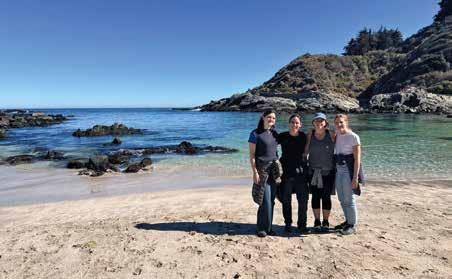

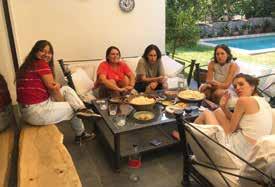

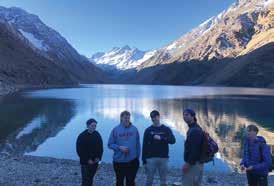
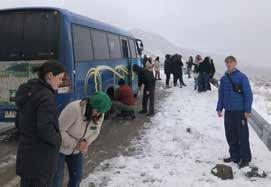
In 1984, Mark Bridgeman (E86), completed building the summer house in the garden of St Edward’s House, which Fr Edward and the boys had created out of the hillside. Mark had spent many hours in the old carpentry workshop, until it was closed and replaced in 1983 by the new Sunley Centre. Design and Technology became a new subject in the curriculum and Mark was the first student to take it as an A level. He used the new design centre to draw up the plans and then the summer house was built with the help of other boys in the House and also Archie, the gardener. The garden now belongs to St Dunstan’s & St Oswald’s House and Ben Bridgeman (DO24), the youngest of Mark and Lucia Bridgeman’s four OA children, uses it as the headquarters of ‘Gardening Club’, run under the supervision of Fr Henry. The many generations of Bridgemans and Fr Henry can be seen in these photos.
By Mark and Ben Bridgeman
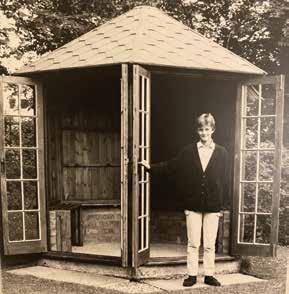

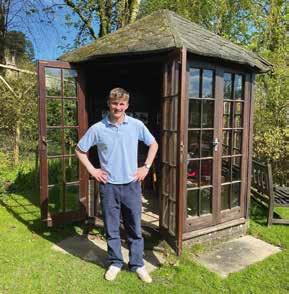
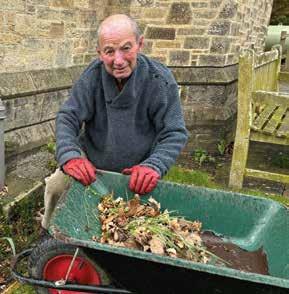

On Sunday 21 April 2024 we welcomed Old Amplefordians, parents, pupils and guests of honour, Robin and Penny Dyer, to the valley for the opening and celebration of our new “Robin Dyer Cricket Nets”. This fantastic 8 lane facility, located between the Match and Maiden Grounds, was made possible by the generosity of over 150 parents and Old Amplefordians who donated to the Robin Dyer Fund.
Whilst rain that afternoon had stopped play for the boys First XI vs The Forty Club, the girls had a very successful fixture against Sessay Emeralds, showcasing the growth of cricket as a flagship co-educational sport at Ampleforth.
Guests gathered in the Pavilion for lunch, where cricketing legends of Ampleforth’s past mingled with pupils, parents, and local friends who will also make use of the nets as part of our outreach and partnerships programme.
Lily Sadler (A) Year 10, Captain of the Girls First XI, reports: “As crowds began to form, everyone full of anticipation, the opening of the Robin Dyer cricket nets commenced. Mr Roberts made a moving speech about Robin Dyer’s tremendous career not only as a brilliant former Head of Ampleforth, but as a passionate and committed cricketer, who played an instrumental role in supporting the school’s cricketing success and championing of the girls’ sport at Ampleforth. Fr Ambrose then led a heartfelt blessing, which not only consecrated the nets, but doused with generous amounts of holy water the crowd and community that had come together to make this achievement possible.
Robin Dyer thanked everyone for coming and for the fantastic support from parents and OAs to build the new nets. He particularly thanked Colin, Head Groundsman, for his tremendous efforts to make it a cricketing day for both girls and boys, sadly thwarted by the heavy rain. Robin went on to say,
Thank you to Fr Ambrose for blessing the nets. When I was a cricketer, the idea of some sort of divine help, as we’ve just had from Fr Ambrose, was what I was hoping for most of the time and indeed needed. The idea that we needed more water being spread around in theValley has surprised me but that’s the way it sometimes works at Ampleforth. Peter Roberts suggested that I could have scored 87 runs before lunch; you need to know that when I was sacked byWarwickshire CC as a cricketer, the local brewery, Mitchells and Butlers, complained to the Cricket Committee about my sacking. They said in writing, ‘you have single handedly destroyed a part of our business by taking this decision, because when Robin Dyer was batting, the bars used to fill up’. 87 runs in a day, possibly Peter.
Cheers erupted through the valley as Robin cut the ribbon at the entrance to the nets, the gathering mirroring the strong community that Ampleforth College is so famous for.”
We are grateful to all those who gave so generously to make our new cricket nets possible, not only for the enjoyment of the current and future pupils of the College but for all those clubs and partner schools who will benefit from them in the years to come.

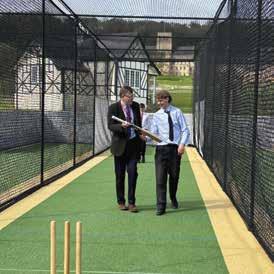
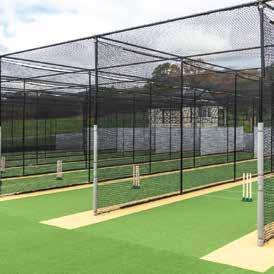

We welcomed Hari Budha Magar into the valley to talk to our cadets. Hari is an ex-Gurkha soldier who lost both of his legs due to an IED explosion in Afghanistan in 2010. Thirteen years later he became the first double above the knee amputee to summit the gruelling 8,849 metres of Mount Everest. Since then, he has continued to use his miraculous story to inspire others, promoting a determined message to pick yourself up and not dwell on your disadvantages.
Hari spoke of the aftermath of the explosion and how it deeply affected him mentally, going into a depressive phase. This was enhanced by his fears of how he would support both his family in England and Nepal with no job. However, Hari was able to turn this horrible period around by adapting to his new way of life through a positive outlook. He started doing physical activity again such as hiking, skiing and kayaking and eventually the end goal of summiting Everest. Not only did Hari have to create his own prosthetic leg to brave the harsh conditions, but he had to campaign against the Nepalese government to allow solo, blind and double amputee climbers to climb Everest. He overcame all of these obstacles and has a beaming smile on his face - I’m sure that each person is able to take at least a little inspiration from his story.
By Sam Thomas (CT) Year 13
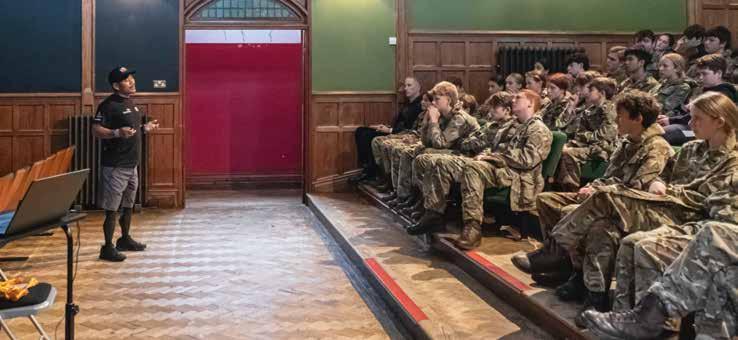
Tuesday 25 June brought forty-four primary school students from Middlesbrough for an ‘Inspiration Day’ at the College as part of a Primary School Ambassador Programme. This is one of the initiatives set up by Power of Women campaign, which was formed in response to the charity Plan International UK’s 2016 report identifying Middlesbrough as the ‘worst place to be a girl.’ Their mission is simple: to improve the lives of young people in the Tees Valley and beyond by elevating aspirations, ensuring equal opportunities for all students, and smashing gender stereotypes.
The programme takes young leaders and promotes a more inclusive future where aspirations have no bounds and Ampleforth College was more than happy to lend our facilities, staff, and students to give these young ambassadors an inspirational day. The students rotated through four activities, led by staff and our Middle Sixth students.
The activities included Art, where the students looked at the work of Frida Kahlo and then completed their own block printing. Drama gave them the opportunity to express themselves as they engaged in a variety of theatre activities. Things went with a bang in Science, as Mr Howard created an explosive demonstration, and then the students moved on to see Physics in action, learning how to bend water. All of that was topped off with team building and problem-solving activities with our welldrilled Combined Cadet Forces team. Our students were truly great ambassadors for the College, living our Benedictine values and making our visitors feel very welcome.
The feedback from the visiting primary schools, and our Power of Women partners, demonstrated just how worthwhile the event had been, providing valuable, longlasting memories and inspiration to our young visitors.


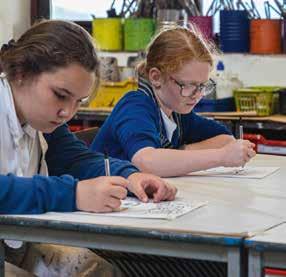



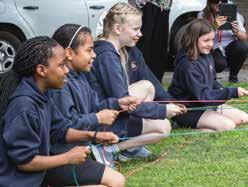


On 27 January 1649, Charles I (Figure 1) was condemned to death as a ‘tyrant, traitor, murderer, and public enemy’ during a trial in Westminster Hall. Three days later, he was beheaded on a scaffold set up outside the Banqueting House in Whitehall; republican government had begun. This was by no means a universally supported decision. Indeed, of the 135 Commissioners who had been appointed to the High Court of Justice, 47 never appeared at a single session and only 59 became regicides by signing the death warrant of Charles I. Colonel Adrian Scrope (Figure 2) was the 27th signatory. Eleven years later, he would face his own trial for his role in the execution.
‘I never went to the work with a malicious heart.’ This phrase captures Colonel Adrian Scrope’s clear understanding of what was at stake on 12 October 1660: his life. His desperate plea was not enough to convince the court to commute the death sentence however, and the scaffold at Charing Cross was his ultimate fate. It is Scrope’s story, so intimately tied up with that of the presiding judge at the trial, Sir Orlando Bridgeman (Figure 3), that is the focus of this article. These men were caught up in the whirlwind of the restoration of the Stuart monarchy in 1660; only one of them saw the year’s end with his life intact.
Adrian. When Dilly returned from the February half-term break, she brought copies of Scrope’s portrait and his speech from the scaffold which are preserved in her family home.

The desire to unpack Scrope’s story led me to his entry in the Dictionary of National Biography where the author made a pointed reference to Sir Orlando Bridgeman’s conduct towards Scrope during the trial, stating that he ‘treated Scrope with great civility.’ Bridgeman’s name immediately leapt out from the page and brought to mind another - Orlando Bridgeman (D18) who was two years below me at the College; was there a connection? As it happened, there was, as Sir Orlando is the tenth great-grandfather of our modern-day Orlando and his younger brother, Ben Bridgeman (DO) Year 13, who has sat at my old desk in Room 43 during his Upper Sixth year.
of the words spoken must exist. Rooting around on the Internet, I stumbled upon a digitised archive belonging to Cornell University in the United States. Within this was a curious document entitled William Throop and Adrian Scrope: The Family Tradition. It was a record of an American family, privately printed in 1943, who held that their ancestor was one William Throop, son of Colonel Adrian Scrope, who, ‘feeling insecure in his person and property’ following his father’s execution, had ‘escaped to America and changed his name to William Throope.’ One descendant, James Addison Throop, found himself in the Chicago Library in August 1905 where a copy of Noble’s Lives of the Regicides, published in 1798, recounted the proceedings of the trial. In this way, a record of the trial found its way into the little booklet that the family had created to preserve their story. It is the proceedings of the trial that I would like to share with you, for within the words recorded by the court scribe, Scrope and Bridgeman come alive once again.
regardless of the evidence presented, agreed with Scrope’s request but remarked: ‘nothing is more usual than for a witness to make use of a paper to help his memory.’
Another witness, Mr Kirke, arrived at the stand and confirmed that he saw Scrope at Charles I’s trial but was surprised that Scrope, ‘an eminent man’, should have been present at such a spectacle. Scrope immediately attacked him, arguing that Kirke should ‘give his evidence without any speech.’ When asked by an incredulous Counsel, ‘How can that be? Can he give evidence without speaking?’, Scrope clarified that he wanted Kirke to speak ‘in plain words’ and he only allowed Kirke to proceed after being placated by Bridgeman.
for what had happened in 1649 and, with so many MPs excluded by the army radicals, it could in no way be called a representative body. Scrope claimed that he had been ‘misled’, that he did not have a ‘malicious heart’, and that his signing the death warrant was ‘an error of judgement’. Bridgeman shut this down: ‘The law implies the malice.’
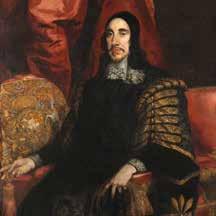
Before the beginning of the academic year, I had never encountered Scrope’s story, even though the turbulent English Civil War and its aftermath has been a keen interest of mine since Maria Rainer brought the subject alive with her passionate and inspiring teaching during my own time at Ampleforth. I had the privilege of inheriting her classroom, Room 43, at the beginning of the academic year and have continued delivering the Stuarts topic as part of the A level syllabus offered by the History Department. Whilst teaching the trial and execution of Charles I to my Middle Sixth class in January, one of my students, Dilly Scrope (M) Year 12, explained that she and her brother, Sam Scrope (H) Year 9, were related to Colonel
The implications of these connections for my own teaching were mind-blowing. It meant that these two men, whom fate had brought together in October 1660, had living relations in my Sixth Form classes. Dilly and Ben were both studying a paper which focused on a period in which their family members had featured as protagonists of the divisions which tore the country apart and turned ‘the world upside down’, to quote a ballad published in the 1640s. The past, which can sometimes appear to be a foreign country, was alive and present in these two students studying for their A levels.

Given that the connection between the Scrope and Bridgeman families centered around legal proceedings, I was keenly aware that there must be an account of the trial preserved in an archive somewhere and that a record
When Scrope appeared at Sessions House in the Old Bailey on 12 October 1660, the Solicitor General began the trial by describing the High Court of Justice as a ‘traitorous assembly’ which had had acted ‘with a wonderful impudence’. In all, eight witnesses were called to provide evidence against Scrope, who had to rely on his own powers to defend himself; he had been denied legal representation by the Court. Throughout, Scrope vigorously cross-examined the witnesses; as he said himself: ‘I am now pleading for my life.’ One witness, Mr Carr, said he was present when the names of the judges who sat on the High Court were called, and that he still had the list on which the names were printed. Scrope immediately challenged the Court arguing: ‘I hope you will not take evidence from a printed list.’ Scrope’s point was that that every witness should be required to give their evidence completely from memory and that paper evidence had no place in the courtroom. The Solicitor General, maybe knowing that Scrope’s conviction was certain
It was the evidence of Sir Richard Browne, disparagingly described by James Addison Throop as ‘the renegade Brown’, that was, quite literally, the ‘nail in the coffin’ for Scrope. Browne, a fierce opponent of Oliver Cromwell’s Protectorate, had spent nearly five years in prison, but upon the Restoration became Lord Mayor of London. He appeared at Scrope’s trial to describe a conversation that had recently occurred between him and Scrope in the Chamber of the Speaker at Parliament. Browne had made it clear that he regarded that the kingdom had been ‘ruined’ after Charles’ execution, yet Scrope, refusing to denounce his role in the execution, said: ‘Some are of the opinion and some of another.’ This was such damning evidence that the Solicitor General immediately declared to the Court: ‘You have heard how little penitence he hath had…’
Scrope was then allowed to give his testimony in defence of his life. He argued that he was not an MP and so bore no responsibility, and that the High Court was organised by a ‘commission for the Parliament’ He said that the ‘commission’ was the supreme authority at the time and so all of his actions were in accord with that authority to which ‘a great many of the generality of the nation submitted…’ Bridgeman made it clear that there was no parliamentary precedent
After summing up the evidence, Bridgeman instructed the Jury to find Scrope guilty of treason. Given that Scrope had admitted signing the death warrant, Bridgeman argued that: ‘This, without any witness at all, was a sufficient proof, a proof of proofs. Yet Bridgeman still accorded Scrope respect and dignity, even if this did not negate what Scrope had done: ‘Mr. Scroop (to give him his right) was not a person as some of the rest, but he was unhappily engaged in that bloody business, I hope mistakenly.’ Finally, Bridgeman made it clear that ‘there [was] no excuse or extenuation before man’ for Scrope’s actions and the Jury accordingly returned a verdict of guilty.
After reading the account of the proceedings of Scrope’s trial, a unique opportunity presented itself. I invited Dilly and Ben to Room 43 and explained the connection between their relations and the unique position they were in as young historians studying Stuart England with such a profound connection to the period. Handing them a copy of the trial, and with the portraits of Scrope and Bridgeman projected onto the whiteboard, Dilly and Ben read aloud the words spoken by their family members. To the best of my knowledge, it was the first time in 364 years that a Scrope and a Bridgeman had come together and re-enacted the proceedings. Though divided in 1660, the families were now united in a shared pursuit of the past.
We finished our meeting by discussing Scrope’s fate. James Addison Throop admitted that it was ‘very impolitic in Scroop to unbosom himself to such a man [Browne]’, but commended Scrope for his ‘steady mind’. This ‘steady mind’ continued to the
end of Scrope’s life. On the night before his execution, he rejected his nephew’s attempts to convince him to repent and submit to Charles II’s mercy. ‘Avoid Satan’, Scrope replied. That night, Scrope ‘slept so soundly that he snored’ and he had to be forcibly awoken when the men arrived to deliver him to the executioner. He was hanged, drawn and quartered at Charing Cross, together with three other regicides, on 17 October 1660.
As a special favour to his family, Scrope’s remains were returned to them for burial rather than being displayed around London, as was the norm for regicides. This final action demonstrates the complexities of Scrope’s character and the ambiguous way in which he was viewed by his contemporaries. As Bridgeman said, he was ‘not a person as some of the rest…’
By Joseph Ruane (EW16), Teacher of History
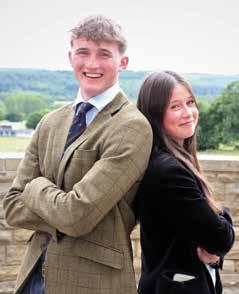
‘If’ as the Bard says, our very own William Shakespeare, ‘music be the food of love’, then today’s music making for our fête champêtre, our Exhibition barbeque, from motet in Abbey to orchestra here in the St Alban’s Centre, is apt and uplifting for Ampleforth’s Exhibition of 2024, as a celebration of the huge amount we have achieved together across this academic year. We are all like an orchestra, each playing our part, sharing the harmony, but interpreting it with an individual and special sense of our own contribution. The sense of togetherness, contributing to the one theme, the one leitmotiv, the one hymn has been very strong.
Marie and I have felt it with the wonderful wave of sounds that surrounds us from the congregation singing at Mass in the Abbey Church, under the encouraging baton of Fr Oswald, the nave’s response to the excellence of the polyphony from our superb Schola Cantorum under the passionate and masterful guidance of our very own Kapelle Meister, Edward Seymour, our splendid Director of Music.
That sense in the Abbey that our efforts, our gifts when singing in praise of the Lord are shared and can transport us, both as a means of appropriate worship, but also to educate our senses to develop our emotions, our emotional intelligence is very important at Ampleforth. It is something we wanted to celebrate today, to cheer the heart, to lift the soul, to comfort us if we want to shed a tear and to respond to musical ideas. Music is for all the community and it is a joy that Edward and his Department have enjoyed such an excellent year, the high point being, perhaps, when 600 concert going members of the public paid good money to hear them sing Handel’s ‘Messiah’ accompanied by a professional orchestra, under the baton of our very own and brilliant OA Charlie Grace at Cadogan Hall in London.
I hope that other activities and Departments will be trumpeted from this lectern in coming years. I am sure, next year Ampleforth sport will be centre stage. Of course, Charlie Hill, our rugby Captain, with his fine half time talks to the lads, or, Melisa Anyim, our netball Captain, orchestrating her superb netball warm-up before our all-conquering 1st VII plays in this hall, reflect the same thing, inspiring harmony amongst a team, creating teamwork and helping Ampleforth move forward and do really well.
The music making from our wonderful Upper Sixth leavers has been memorable. The recently discovered papyrus scrolls in the lava from Vesuvius at the ruins of Herculaneum in Italy, show that the great Greek philosopher, Plato, on his deathbed in 348 BCE was
not enchanted by the flautist, or aulos player, as he suffered, not out of misogyny about unruly female musical sensitivity: Plato should have had our very own Lucy Barrett who has been enchanting audiences by the brilliance of her flute playing across her time with us; and we have had the brassy confidence and good playing of Finn McCarthy on the trombone; and the control, delicacy and evocative playing of Alix Hamilton on piano and on organ. I particularly will remember her performance of Janacek, the owl calls resonating in the sound box of the piano, just as we hear them in the Ampleforth woods.
Brilliantly led by Seamus and Josie and their Monitors team, this has been an exceptional Upper Sixth at the College: they have been happy, united, contributing full throttle right across the year, truly responding by their love for our community – they will go far.
One of the reasons for that is the way they understand themselves in relation to others and have developed qualities of equilibrium, self-discipline and empathy which will take them far, building good lives, founding loving families themselves – as you parents have done with them. To say ‘goodbye but not farewell’ in this frame of mind, it could not be better expressed by Evie Tempest by music with words…….‘if music be the food of love, play on’ Evie. (Reader, she did)

“WE ARE ALL LIKE AN ORCHESTRA, EACH PLAYING OUR PART, SHARING THE HARMONY, BUT INTERPRETING IT WITH AN INDIVIDUAL AND SPECIAL SENSE OF OUR OWN CONTRIBUTION.”
My first word is a word of genuine thanks.
I am personally deeply grateful to the Headmaster, Peter Roberts, for inviting me to attend and give out the prizes at this Exhibition. This will be the first time that the Abbot of Ampleforth has done so since 2016 and it reflects the sense of collaboration and commitment to our common mission. It is impossible to imagine the College without the Abbey next door. The monastic community have been intrinsically involved in the life and development of this College since its inception and we are still committed to supporting a vibrant Catholic education that witnesses to the importance of faith.
Circumstances have dictated and made necessary the separation of Abbey and College into two independent Trusts with separate governance and finances. The demographics of the monastic community would have inevitably led to the reduction in the number of monks who are involved in the life of the College. This shift has happened gradually over a period of time, but it was predictable. The separation and reduced monastic presence should not be interpreted however as a loss of interest or commitment. The recent Ofsted inspection and that of the Catholic Schools Inspectorate both recognised, and rightly so, the high quality of the work of the Chaplaincy and the life of faith within the daily structure of the College. To have attained such top grades is something to give thanks for.
Yet at the same time the fragility of this offering cannot be underestimated, and it should keep us fresh, creative, and humble – this is the work of God and a work carried out for God. Monks may not be present in the large numbers as in times past, but this College was built on and stands as neighbour to a community of faith, who are enthusiastic to share the good news of the Gospel. Our praying presence is the first and most valuable service we give to our world and to the students, parents and Staff of this College.
I am so very grateful to my own brethren who serve as chaplains, confessors and celebrants at Mass because in these ways we nourish and nurture the gift of faith – we make God known and loved. In this way we contribute to the evangelisation of our nation, the transformation of our society and the revitalisation of our Catholic Church.
I would, therefore, in conclusion like to take this opportunity to assure parents, Staff, and students
that the partnership of Abbey and College is here to stay. The Benedictine influence and values will be passed on to future generations as long as there are monks in this valley and as long as we can provide a spiritual resource. It is my hope and my expectation that together we will be able to ensure that future generations of Amplefordians will continue to be deeply imbued by the Benedictine understanding of the Gospel – imbued in such a way that they will be able to live the Gospel in the rest of their lives and make a significant contribution in our world.
Thank you for the opportunity to share in the joy of this exhibition experience. Be assured you are all held in prayer.
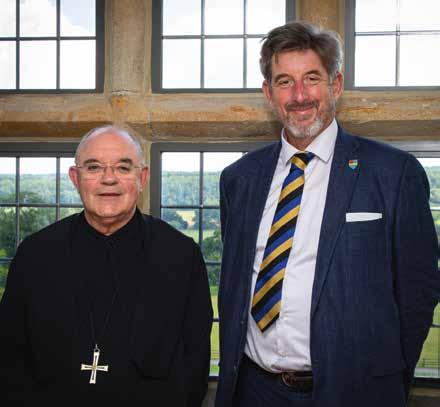
“OUR PRAYING PRESENCE IS THE FIRST AND MOST VALUABLE SERVICE WE GIVE TO OUR WORLD AND TO THE STUDENTS, PARENTS AND STAFF OF THIS COLLEGE.”

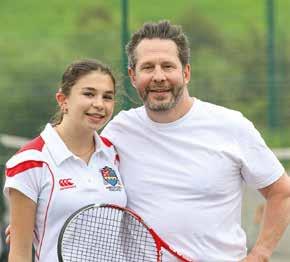
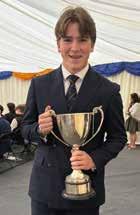

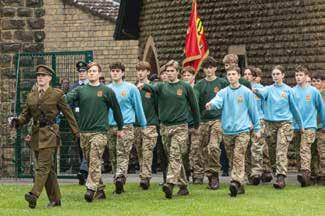


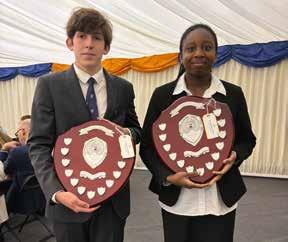

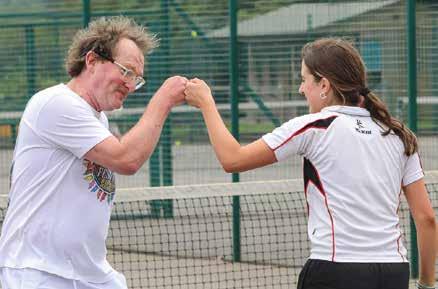

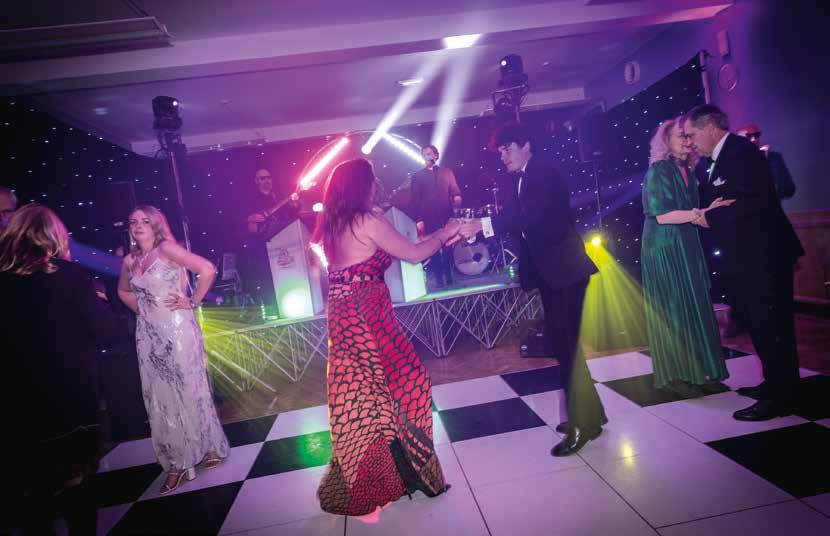




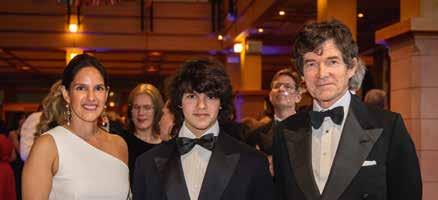



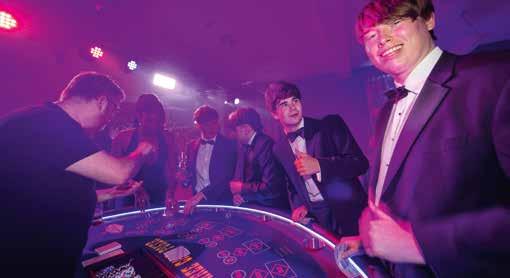
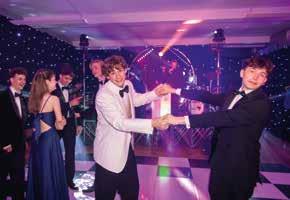
What follows, is an edited version of Seamus Stainton’s (J) speech at the 2024 Leavers’ Ball:
Tonight, some of you become Old Amplefordians, as all of us will in the next few weeks.
From my experience, the reputation of Old Amplefordians is that they are people who you want as your good friends.
While this may sound slightly cheesy, I believe there is something behind it.
So, what qualities would you want in a friend? Someone fun and grounded, someone that can see the value of life beyond themselves and knows how to have good relationships with others, someone who is grateful for what they have and the people around them.
Old Amplefordians are notoriously fun. And while we may not have had as wild an experience as past generations, I would dare to say we have all enjoyed our time here. This ability to have fun no matter where you are is something we should carry with us.
Old Amplefordians are also grounded people. Think about the number of Amplefordians whose life is centred around service. It is not uncommon for Old Amplefordians to serve in the Armed Forces following their time in the valley, and the Lourdes pilgrimage is a cornerstone of many Old Amplefordian’s calendars.
This emphasis on service is why Old Amplefordians make such excellent friendsthey see that life has value past their own experiences, they tend not to be selfish. They work for something bigger than themselves.
In order to properly be dubbed ‘Old Amplefordians’ we should aim to be grateful for all that we have. We should be grateful for this school as a community, a community that we will be part of till the day we die. We should also be grateful for this school as place. It is a place that has nurtured us, and we should be grateful that it is still here, since we were so close to losing this school during our time.
On that, as Old Amplefordians we should be grateful for all those people who have worked so hard to make our lives in this valley so special. I would like to thank the Headmaster, all the Senior Leadership Team, our House parents, our Chaplains and Dr Vowles as our Head of Year. There are too many to mention, but I would like to thank you all for everything you do for us.
This seems like a natural moment to express my personal gratitude. I want to thank all of my peers for making my time here the best years of my life. Especially my boys in St John’s who have already shown they are great drinking partners.
Tonight, and for the rest of our lives, let’s aim to be the type of people you’d want to have as your closest friends.
Have a lovely rest of the evening, thank you.
By Seamus Stainton
(J), Year 13
This is a significant moment.
It is an important moment because this is a moment in the academic year when the College pauses to give thanks for the many blessings and opportunities that have arisen. Tomorrow at Prize Giving there will be an occasion to acknowledge, with gratitude, the achievements, over the past year, of individuals. But this is also a significant moment before many continue with public examinations and some of you will begin to say goodbye –before you start a whole new chapter of your life. Exhibition, therefore, marks a moment of real transition.
Words of Dag Hammarskjold came to mind. He was at one time Secretary General of the United Nations. His aeroplane mysteriously crashed while on a peace keeping mission to the Congo in 1961 and not long before that fateful journey he said: “For all that has been, thanks. For all that will be ‘Yes’.” Here are the sentiments with which we enter this celebration, not just of this Mass but also this Exhibition weekend. Take time to say thank you. Thank you for all that has been while you have been here in this valley. The things you have learnt, the friendships you’ve made and the qualities and abilities that you’ve discovered. Whatever your feelings and thoughts are as you approach the completion of your time in the College, this place will have had its influence, it will have left its mark.
St Bede, whose Feast it is tomorrow and whose prayers we are asking this evening, was very clear that the search for meaning and purpose, the need to find direction and values are essential to the human endeavour. As a Benedictine monk, Bede knew that the scriptures and our encounter with God in prayer provide us with purpose, principles, people and power. The Word of God that we have just listened to has presented us with this clear guide: The first reading from Ecclesiasticus reminded us:
“…the scholar will be filled with the spirit of understanding…words of wisdom…He will grow upright in purpose and learning.”
You have learnt many things over these years at Ampleforth College, but the underlying purpose of this College is not simply to fill your heads with information, important as that can be. Information might make life more manageable, but it does not always give you a reason to live, it does not always add quality to life and wisdom is not measured by intelligence Bede was hungry for learning, not for prestige or honours, but so that he would be able to live life to the full. To live life according to its ultimate purpose.
You have lived here surrounded by a community of Benedictine monks, some of whom you have got to know, others were simply figures at a distance. Monasteries exist for no other purpose than to point to something unseen and beyond themselves. We are or should be – a place where people discover that there is more to life than what can be touched, tasted, or seen. My hope is that you have had that experience, and that you have become aware that life has a purpose, greater than the one you may choose to create for yourself.
The Gospel we heard this evening is alerting us to this very reality. It poses the crucially important question: What contribution will I make to the world around me? The principles of the Gospel that you have encountered in the retreats, masses, homilies, discussions that you have engaged in while being in this valley have all been aimed at empowering you to answer that question. What differences will I make, what values, attitudes, beliefs will shape my choices? The world is as it is not by accident, it is as it is because people choose to shape it in this way rather than another. Are you choosing to do what is true, beautiful and good? Without genuine principles
we aimlessly make history – a history that can lead to confusion, despair, emptiness and unhappiness. Why did Bede write his history? So that we could know where we came from, so as to see clearly where we wanted to go.
The purpose and principles that God has put before us from the beginning is that we live in relationship, we are not made for isolation. You have lived at close quarters here with others and while that will have had its tensions, community has also been essential in shaping your character and abilities. Whatever life brings it will bring you into contact, as the Rule of St Benedict says, with people of different characters and abilities, people of different temperaments and backgrounds. Learning to negotiate and celebrate difference is a life skill that is indispensable. Having lived in community from an early age St Bede knew that the support and challenge of others helps enable both spiritual and human maturity.
We have a purpose to live for, principles to live by, people to live with and we have, through the presence of God, a power to live from. Hence, we can with confidence because of the formation in faith that you have received here, we with confidence say thank you for all we have received and we can say ‘yes’ to all that will come our way in the future.
By Abbot Robert Igo, OSB


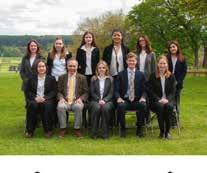
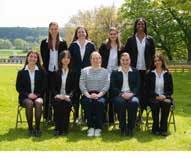

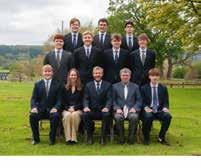
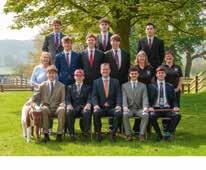
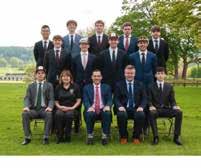

Paul Connor’s Speech to the Common Room on Bill Lofthouse’s last day at SHAC
It feels quite daunting, to say the least, for me, a humble Head of Department, to give the leaving speech for someone of the importance and stature as Bill, someone who has given 27 years – a lifetime – of dedicated service to the College, but I will do my best. There’s no Latin in it, I’m afraid – apologies Bill – but I do mention Roy Keane three times, which is nearly as good. So, here goes…
To give you a flavour immediately of what an extraordinary career Bill has had, I’d just like to run through some of the things he has done in his time here. In no particular order – Head of Classics (10 years), Head of Sixth Form (20 years), Head of Modern Studies, Head of Critical Thinking, Assistant Housemaster of St Aidan’s, Housemaster of St Aidan’s, Housemaster of St Hugh’s, EPQ Coordinator, seventeen years on the Senior Leadership Team and, underpinning all of this – 27 years as a great teacher of Classics. However, a mere list, even one as long and varied as this, does not, of course, do Bill justice. I would prefer instead to try to give a sense of the nature of Bill’s long commitment to the College, a sense of its importance and, above all, a sense of Bill the person who I’ve known and worked with for so long.
back then. It really was a lifetime ago. A young Tony Blair had just become Prime Minister, the world was stunned by the death of the most famous person in the world at that time – Princess Diana – , there were just five television channels, PCs were the size of filing cabinets, mobile phones were the size of shoe boxes, email did not exist and erstwhile Ampleforth parent Roy Keane, midfield enforcer for Bill’s team Manchester United, had picked up just one of the twelve red cards he was in time to amass for them.
that, rumour has it, first drew Bill to the job.
The world back then was, therefore, very different. Bill, though, was not. Though younger, single and bearded, he rapidly realised that the latter two were probably linked and, in due course, addressed them both. Other than that, though, he was in many ways just the same as he is now. My first impressions were of someone super intelligent, intellectually gifted and extremely capable and yet also warm, convivial, friendly and down to earth. We went to football matches together and had friendly digs at each other’s football teams, our sparky bantering mirroring the sparky rivalry of our teams over those years. In many ways, Bill has never lost that sense of humour, that ‘down to earth-ness’ and that ability to remember, and remind others, that there is life and there are interests outside the school.

But as a colleague, it was Bill’s sharpness, intellect and capability that most stood out. And this made him a perfect fit for, and real asset to, Ampleforth.
decade as Head of Classics, with countless students benefitting from his knowledge, his teaching and his guidance, and several staff, some of whom presented rather unique challenges (two in particular spring to mind), benefitting from his good natured, purposeful and always supportive leadership.
In so doing, Bill quickly demonstrated to all that his capabilities – effectively being reliable, capable and good at everything he did – lent themselves to roles beyond the department. In 1998, he was promoted to Housemaster of St Aidan’s House, a post he held for three years, and it was during this time that the first of what I’m sure are the two most exciting and defining moments of Bill’s life occurred – the second being his marriage to Jane. I’m proud to say that I was present at both. The first was in St Aidan’s in 1999 when Bill and I watched the Champions League Final between Manchester United and Bayern Munich (Roy Keane didn’t play, of course, because he’d been sent off again). Bill, of course, as we know, is calmness personified, but when Ole Gunnar Solskjaer dramatically scored the winner in extra time, Bill did something I’d never seen him do before or since – he ran. He ran round and round the room, jumping up and down and yelling and screaming at the top of his voice. It was, of course, the last time I ever saw Bill run, possibly the last time he has ever run, but it was a memorable and joyous moment, even for me, and something that, I feel, highlights the very normal, very human and very fun-loving side of Bill of which many of us, used to just seeing Bill as the calm, serious, measured, professional he is at work, may not be so aware.
knows the school, understands children, who ‘gets Ampleforth’ and who is, almost invariably – and often irritatingly – proven right. Later, when Bill was part of College Committee (what we call SLT now) and I was seconded to it for a year, I saw this writ even larger. Notwithstanding the fact that he used to yawn conspicuously throughout some of the longer meetings – and quite a few of the shorter, it was abundantly clear just how much successive Headmasters came to rely on his ability to understand complex issues, assess the merits or otherwise of various initiatives and reach clear and wise judgements. So good was Bill at all this that, and I mean this in the nicest way, that I found it quite intimidating, to be honest. I felt several rungs down the intellectual ladder. But at the same time, I learnt so much from listening to him.
Plus, Champions League Final notwithstanding, Bill has always done everything with this quite enviable and quite unbelievable air of coolness and calm. I have never, ever seen Bill panic or flap, despite often being under considerable pressure, be it from demanding students, demanding Headmasters, demanding parents or demanding UCAS or EPQ deadlines. Or even from the demands of line managing staff like me, who must surely have exasperated him on many occasions. He really is the embodiment of Kipling’s dictum that ‘If you can keep your head when all about you are losing theirs… you will be a Man, my son’. In fact, quite how he kept his calm as Head of Sixth Form when proof reading, as he did, every single UCAS reference done by tutors for twenty years, is truly astonishing.
of the Head of Careers role too, as Bill was also largely responsible for UCAS and Higher Education. In this role, Bill not only built up such an encyclopedic depth and range of knowledge – of numerous, universities, their relative pros and cons, entry requirements, acceptance rates and so forth – but also established a system of filters and checks that ensured that only applications that were as strong as they could possibly be went forward. He was also always available on that most dramatic day of the year – results day – with calm and invaluable advice to stressed students and parents and contacting universities. As such, quite literally thousands of Ampleforth students can thank him for his vital contribution in helping them to secure the places at university that they wanted. Equally, hundreds and hundreds of students have benefited just as much from his equally dedicated work as Extended Project Qualification (EPQ) Coordinator. I know all this as a fact, not just as a colleague but also as a parent whose own children benefited hugely from his advice, his care, his patience, his wisdom and his forensic attention to detail.
Similarly, it was this combination of calmness, intelligence and integrity plus his knowledge of both the school and of school issues that made Bill the obvious choice as Common Room President in recent years. It is no easy job chairing meetings where issues can be so pressing, opinions disparate, personalities strong and emotions sometimes high, but again Bill’s unique skill set enabled him to manage this challenge professionally and successfully. His are big boots to fill.
To even begin to understand the extent of what 27 years – 81 terms – of service means, one has to go back briefly to 1997, the year that Bill joined the College as Head of Classics, succeeding Fr David Morland in that role, and also as Assistant Housemaster of St Aidan’s, and realise what a very different place the world was
The College, too, was very different. The Headmaster was a monk, almost all Housemasters were monks, lots of teachers were monks, there were no girls, St Aidan’s and St Bede’s were boys’ Houses, the new EW’s, St Cuthbert’s and St Thomas’ and St Hugh’s and St Margaret’s Houses did not physically exist, House Punches ended when Period 1 the next day started (or not), the latest technology wasn’t AI or IPADs but an amazing new machine called a photocopier and staff were allowed to smoke in the Common Room – something
Private schools – and their staff – back in the mid1990s were in transition. They were becoming professionalised. Heads of Department used to be academics; now they had to be educational practitioners. Bill, it became rapidly evident – and relatively unusually for the time – was both. And he needed to be. When Bill arrived, Classics at Ampleforth, and Fr David as its Head of Department, had a long, proud national reputation for excellence, with much Oxbridge success, and it would take someone of singular intellectual and educational gifts to continue and even elevate that reputation. Bill did so, with great distinction, for his
But it was Bill’s calmness and professionalism, combined with his intellect and competence, that were most evident to all who worked with him. It certainly was to me. As Heads of Department, he and I attended APC together and I just remember being in awe of him at meetings. To be in meetings with Bill was to listen to someone not only demonstrably intelligent and expert in all things educational, but also to listen to someone who has a huge dose of those most essential qualities - wisdom, empathy, common sense and good judgment. I remember not always necessarily agreeing with him but always thinking ‘here’s someone who palpably knows his subject,
As mentioned, Bill has also been, at various times, Head of Modern Studies (the ‘Modern’ studies juxtaposing the ‘ancient’ Classics and perhaps encapsulating the polymath that Bill is), Head of EAL, Head of Critical Thinking and Housemaster of St Hugh’s. All these are testimony not only to his incredibly wide and diverse skill set but also his considerable abilities as a leader and manager of people. However, it is as Head of Sixth Form, a post he held for a full twenty years, that he perhaps made his biggest impression. Head of Sixth Form was a massive job. First of all, it was Head of Year 12 and 13 combined but also, crucially, it had half
I would like to finish with my reflections on Bill the person more than Bill the colleague. We all know how intelligent, dedicated and professional Bill is. We also all know about Bill’s legendary sartorial elegance. Reputed to have a suit for every Sunday of the year and a tie for every weekday, I have bumped into him in Tesco’s during the holidays in a suit, in Helmsley during the holidays in a suit, at home relaxing in a suit – and there are, famously, photographs of him on Italian beaches in the sweltering heat – again in a suit. More importantly, though, I’d like you to know a few of the qualities that I’ve been lucky enough to see in the 27 years that I’ve known Bill.
“BUT PERHAPS ONE OF BILL’S GREATEST QUALITIES IS THAT HE HAS SOMETHING PERSONAL AND UNDEFINABLE THAT INSPIRES THE LOVE AND AFFECTION OF ALL HIS STUDENTS. HE IS HUGELY RESPECTED, ADMIRED AND LOVED BY THEM…”
Bill is very funny and very kind. He has a sharp wit and great sense of humour but is never caustic or hurtful. I can honestly say that I’ve never heard him say a bad word about anyone. He can be critical of things, but never of people - a rare and admirable quality. He is extremely patient, caring and considerate – with students, with parents and with colleagues. Again, I know this first-hand. He loves horse racing, football and American football and is always happy to chat away about any of them. He enjoys music – not just classical choral music (that saw him make something of a surprise guest appearance at last year’s Messiah), but the equally inspiring tunes of Madness and the Specials. He is also not averse to taking a cheeky, good-humoured pot at his friends on occasion. Those, I shall say, ‘fortunate’ enough to have found themselves on duty with him, whether in the refs, on patrol or in a House, myself included, will have often seen Bill strolling up to them after ten minutes, felt the warmth of his smile and of his hand on your shoulder, accompanied by the phrase, ‘I’ll leave them in your capable hands.’ In the moment it takes you to realise what’s happened, he’s gone, leaving you feeling mildly valued and praised, yet strangely outmanouevred.
But perhaps one of Bill’s greatest qualities is that he has something personal and undefinable that inspires the love and affection of all his students. He is hugely respected, admired and loved by them, especially Sixth Formers. I’ve noticed this throughout his time here – he has always been their ‘go to’ person whenever they have been in need of serious academic advice. This is, I think, because, quite simply, they like him, they trust him and they have complete confidence in him. And this was not just in his capacity as Head of Sixth Form. First and foremost, Bill is a teacher and his warmth, care, sense of humour and trusted teaching

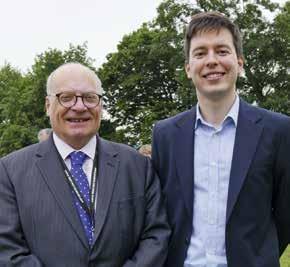
style just reinforced this affection they had for him. Again, I know this as fact – Bill was my daughter Lauren’s favourite teacher (way above me, describing him as ‘the father figure she never had’), and in that she spoke for many. However, what highlighted this affection most to me was when I was in a Sixth Form Assembly in the Theatre back in 2008 when it was announced that Bill was to marry Jane. I can honestly say that I have never witnessed or heard such a long, loud, raucous and genuinely affectionate ovation for anyone as that which the Sixth Form burst into then. They were so happy for him and for Jane. I remember Bill himself being truly moved by it. It was a genuinely memorable moment.
And this brings me – saving the best and most important to last – onto Jane. Bill has given the College a huge amount over his 27 years, but the College has, in one way, given him even more. Through the College, Bill met Jane, they married in 2008 and they have had, so far, nearly sixteen years of very happy marriage, with many, many more to come. Jane has been at Bill’s side throughout, as he has been at hers, and they have been a great team (indeed, for a while, with Bill as Head of Sixth Form and Jane as Head of Scholars, the Sixth Form Scholars simply could not have been in better hands). I was lucky enough to be present at their wedding, as was Bill’s father who had recently been very gravely ill, and I know that it was, for Bill, the most happy, luminous and profound moment of his life –to be marrying Jane with both of his parents there. In many ways, Bill has not changed in the 27 years I have known him, but in this one way – in marrying Jane – he has… he has become complete.
I will conclude now not just by thanking Bill on behalf of all of us for the 27 years of enormous contribution to the College,
for which we are hugely grateful, and also not just by wishing him a very long, very healthy and very happy retirement. I would like to conclude by trying to encapsulate Bill by likening him to someone from the world of his many interests outside school. Not horse racing – I don’t know anything about owners or jockeys. Not his new-found interest in choral singing – I doubt his voice compares to that of Pavarotti. But football. But I would certainly not compare him to Roy Keane. No… concurrent with most of the 27 years that Bill has been here, Italian football was blessed with one of the greatest midfielders of all time – a player called Andrea Pirlo. In many ways, Pirlo was very much like Bill and demonstrated many of the same qualities – he was always cool and calm, he made everything look effortless, he could virtually stand still in the middle of the pitch and control the game, he was supremely skillful, and he smoked at half time. He was respected and revered by all –he was known as ‘peerless Pirlo’ – a genius in his role. All this is Bill too. When Pirlo retired, the Italian press and, indeed, the Italian nation knew it was the end of an era, and with Bill retiring, it is the end of an era for us too, a last link with the SLT of old and in many ways the College of old, gone – others are doing, and will do, the jobs he did, but no-one will replace him.
And so, for the last time, Bill is strolling up to us again, but this time not just to the person on duty with him but to all of us who remain on duty, responsible for the place he loves and to which he dedicated 27 years of his life, giving us all a collective smile and putting his hand on our collective shoulders and saying to all of us, ‘I’m leaving them all now in your capable hands.’
Bill – thank you for everything. We will miss you greatly.
“He, then, is truly eloquent…who in the Forum and in public debates, can so speak, as to prove, delight and force the passions”. These words of Cicero are equally applicable to a brilliant teacher as to a brilliant orator and encompass all the qualities which Mr Lofthouse brings to his lessons.
Mr Lofthouse’s knowledge of Classics is encyclopaedic and his enthusiasm for what he is teaching is nothing less than inspirational. Sixth Form classes in his office were more like a convivial chat or tutorial than an hour-long lecture, but unfailingly imparted a wealth of knowledge or new ways of thinking about the classical (and modern) world. Memorable lessons covered the true meanings of exeat and caveat, whether an Athenian would consider America a democracy and the commonality between Rome, Sheffield and Istanbul. He is always ready to share his passion for (and remarkable learning in) all aspects of Classics and the humanities at large, be that Thucydides’ Introduction, the three great Athenian Tragedians or Pompeii (on an unforgettable class tour). On more than one occasion, he has also been known to explain at length why an Oxford comma is “utterly pointless”.
We three brothers feel so lucky to have benefited from Mr Lofthouse’s teaching and are grateful to him for putting up with us over such a long time; from 2008 to 2024, with a few years off in between for good behaviour! Felix was the first to be taught by him and quickly referred to him as a legend for his extraordinary learning, teaching style and famously extensive collection of ties! He had no relief from Hugo, whom he taught from Year 9 to 13, and topped that off by teaching Will Latin and Greek A level, often one to one.
Mr Lofthouse’s demand for excellence, extraordinary knowledge and constant enthusiasm were fundamental to all three of us choosing to study Classics at university. Words will never be able to express our gratitude for a teacher who has, in a very concrete and fundamental way, changed and enriched our lives both at Ampleforth and beyond.
By
Shipsey brothers, Felix (H13), Hugo (H15) & Will (H) Year 13
Bill Lofthouse’s Successes: Ampleforth Classicists at Oxford or Cambridge, 2002-2024
2002
Edward Brady, Pembroke College, Cambridge,
Edward
Antonio
2003
Philip Canning, Fitzwilliam College, Cambridge, Classics
Jonathan Halliwell, Downing College, Cambridge, Classics
2004
Richard Flynn, St Anne’s College, Oxford, Classics and Modern Languages
Zachray Tucker, St Benet’s Hall, Oxford, Classics
2005
Anthony Pitt, St Benet’s Hall, Classics
Madeleine Rudge, Merton College, Oxford, Classics
Theo Pembroke, Trinity College, Cambridge, Classics
2007
Rupert Goodway, Clare College, Cambridge, Economics
2008
Patrick Garety, Clare College, Cambridge, English Literature
2009
Padraig Staunton, Corpus Christi College, Oxford, Classics
2010
Catherine Dobson, New College, Oxford, Classics and Modern Languages
2011
Walter Arbuthnott, St Benet’s Hall, Oxford, Classics Eleanor Kirr, Corpus Christi College, Oxford, Classics
2013
Felix Shipsey, Christ Church, Oxford, Classics Edward Sparrow, St Benet’s Hall, Oxford, History
2015
Theresa Rowland, Hughes Hall, Cambridge, Classics Hugo Shipsey, Corpus Christi College, Oxford, Classics
2016
Raphaëlle Philipponnat, Jesus College, Oxford, Classics
2017
Tom Channer, St Benet’s Hall, Oxford, Classics with Oriental Studies
James Gordon, Keble College, Oxford, Classical Archaeology and Ancient History
2019
Isabella Fox, Murray Edwards College, Cambridge, English Literature
2020
Alice Hunt, Girton College, Cambridge, Classics
2021
Anna Barrett, Christ’s College, Cambridge, Anglo-Saxon, Norse and Celtic
2024 Will Shipsey, Corpus Christi College, Oxford, Classics

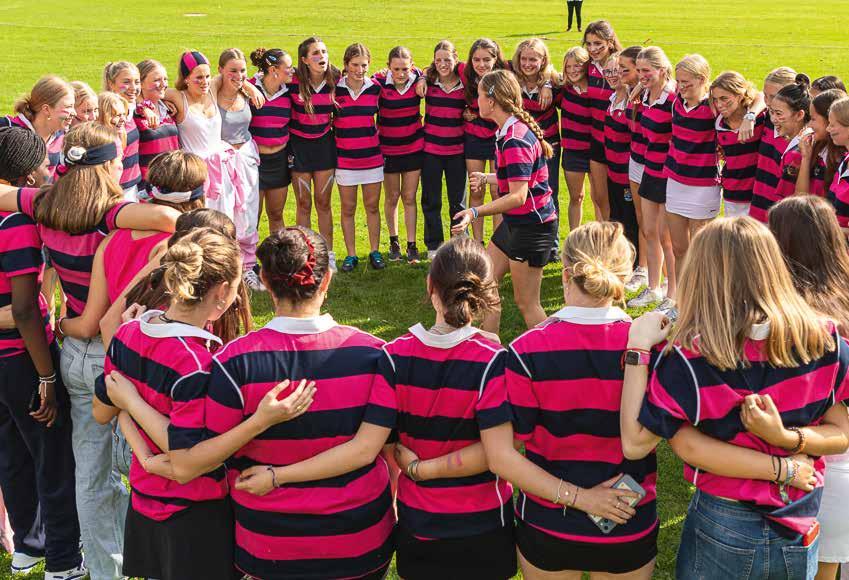


www.ampleforthcollege.org.uk